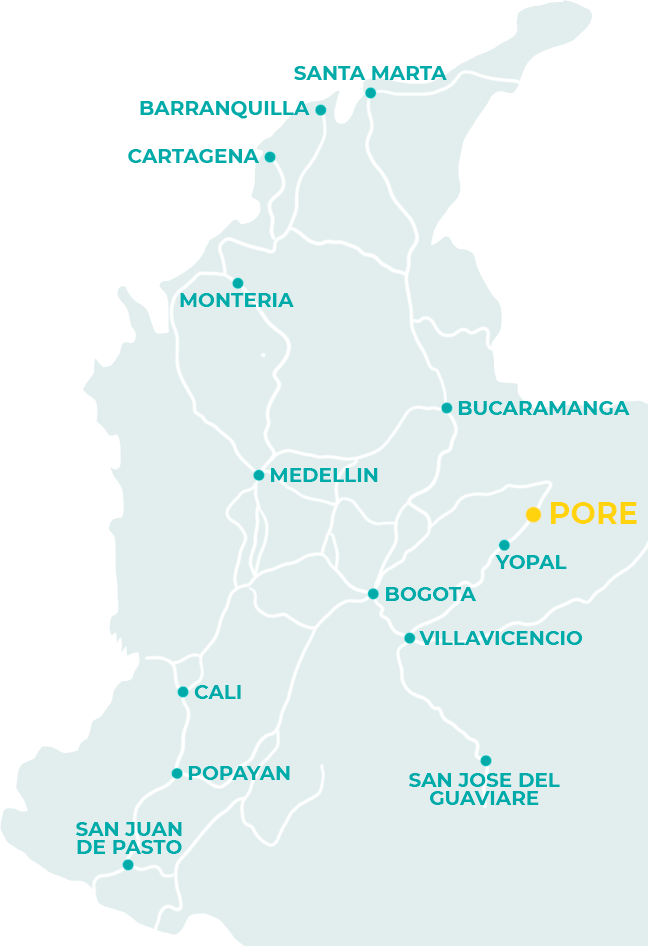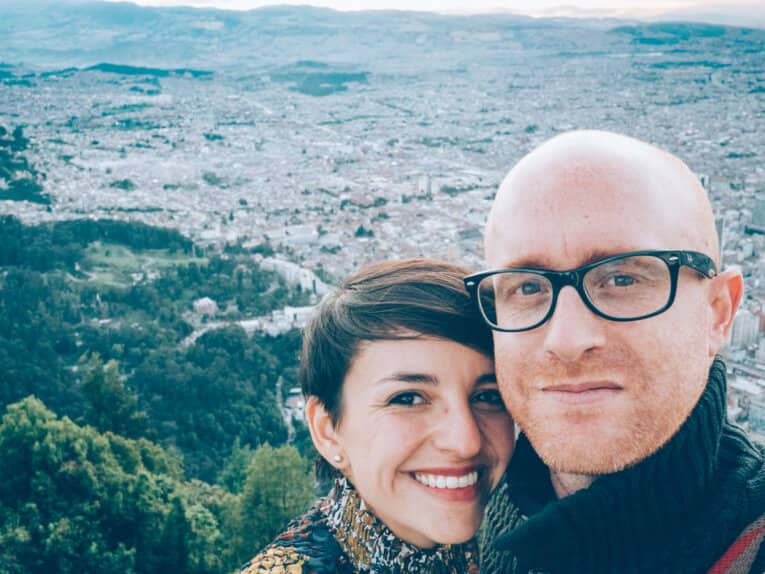The Colombian Heritage Towns and Villages Network is a grouping of Colombian sites that stand out for their historical or architectural importance.
The network is an initiative to promote Colombia’s tangible and intangible cultural heritage(history, architecture, know-how, etc.)
So they’re not always “beautiful villages” as you might imagine, although you’ll see that most of them are magnificent places. But while some heritage villages are remarkable for their architecture, others are more remarkable for their historical value or their craftsmanship.
The idea behind this network is to promote this heritage through tourism and offer sustainable development opportunities for local populations.
We’ve been meaning to talk to you about this for a long time, and to list the 18 heritage villages in Colombia.
It’s always easy to add one (or more) to a travel itinerary. We’ve visited eight so far, so there’s still more than half to discover!
Summary

Disclaimer: we apologize in advance for any grammatical or syntactic errors, as our native language is not English (we're a Colombian-French couple), so we hope you'll forgive us and still enjoy the information we share with you! Please note that all the information on our blog is based on our own experience, and is checked and updated regularly.
Guaduas, Cundinamarca
Colombia’s heritage villages
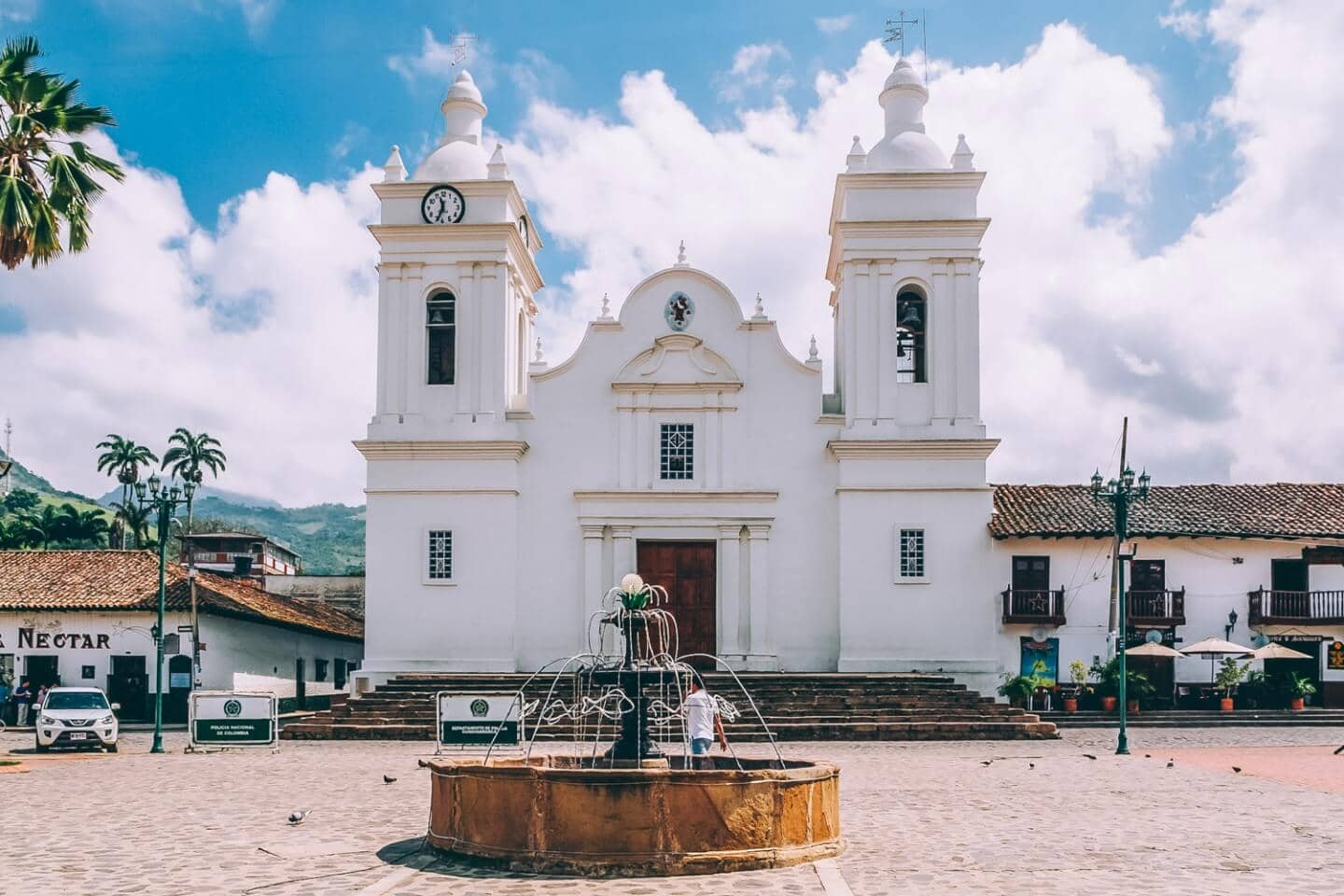
Guaduas is a village in the department of Cundinamarca, near Bogotá. Guaduas was founded on the ancient “Camino real” linking Bogota to Honda on the banks of the Magdalena River.
Guaduas was the nerve center of the famous botanical expedition led by José Celestino Mutis, considered the most important scientific epic of the colonial period in Colombia.
Guaduas is also the birthplace of Policarpa Salavarrieta, known as “la Pola”, one of the few female heroines to have played a major role in the resistance to the Spanish crown and in Colombia’s independence.
Bridges of interest in Guaduas
- Plaza de la Constitución: a meeting place with a refreshing fountain, a sculpture pays tribute to Policarpa Salavarrieta, “La Pola”.
- Casa Museo del Virrey Ezpeleta : the house-museum of José Manuel Ezpeleta, from where he ruled as viceroy of New Granada from 1785 to 1789.
- San Miguel Arcángel Cathedral : considered the last colonial church built in Colombia. Declared a national monument in 1959.
- Policarpa Salavarrieta House: a “Creole” house in memory of the Colombian heroine.
- Maison Royale : historic house with preserved 18th-century architecture.
- Patio del Moro Traditional Arts Museum: known as the House of 100 Doors, this old 18th-century house now hosts artistic workshops (music, theater, poetry, painting, etc.)
- Casa Consistorial: built in the 17th century, it was once a prison, a town hall and the seat of the municipal council.
- Convent of La Soledad: considered the first colonial building constructed in the early 17th century. It is now the Guaduas town hall.
In the vicinity of Guaduas
- La Piedra Capira: viewpoint over the region
- Camino Real: ancestral cobbled road
- Monument to José Antonio Galán: martyr of independence
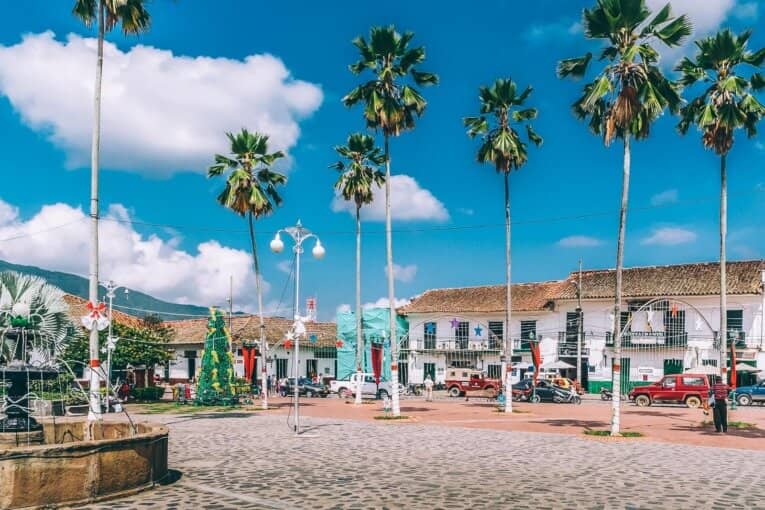
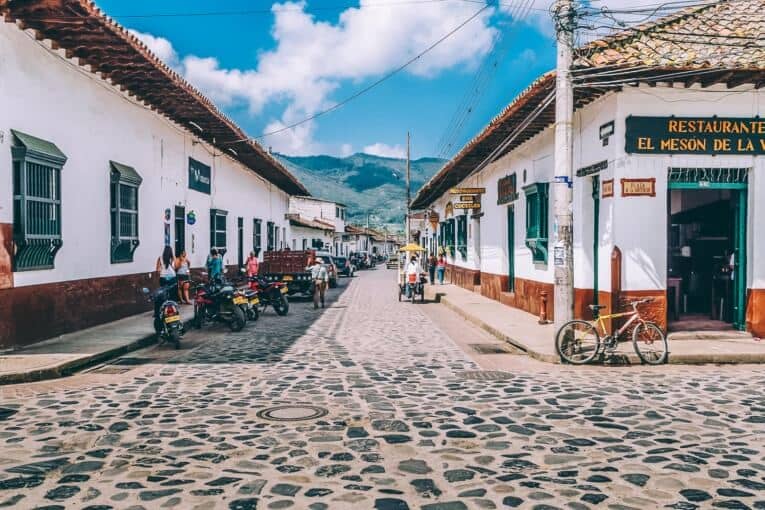

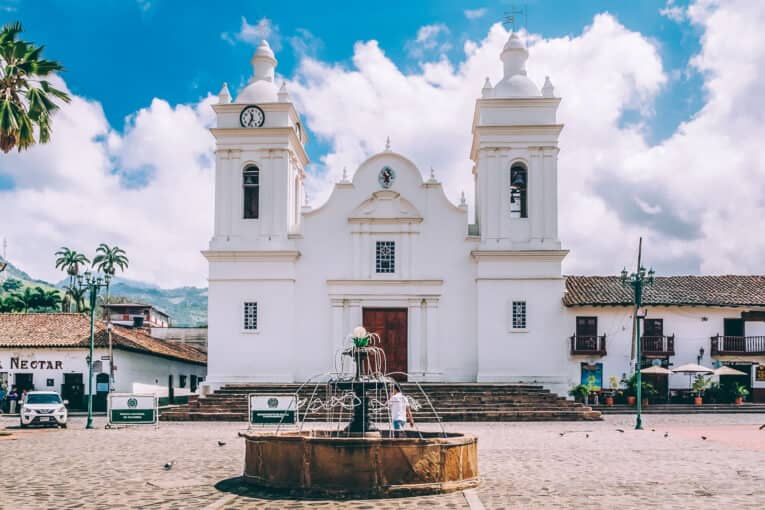
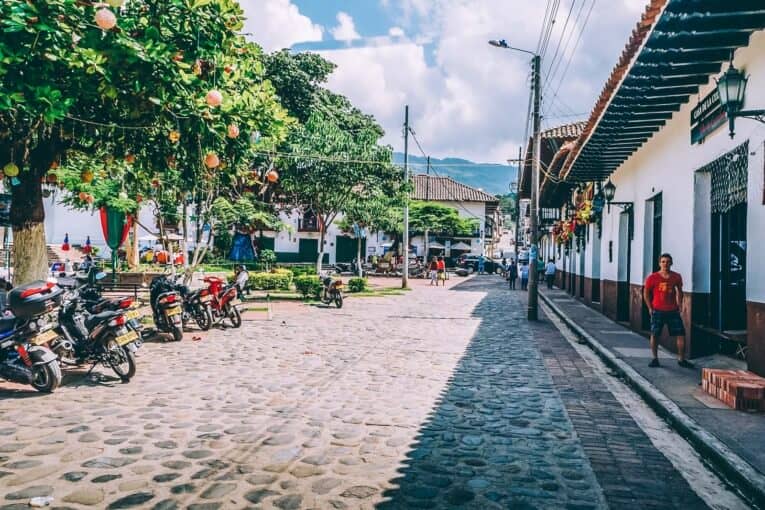
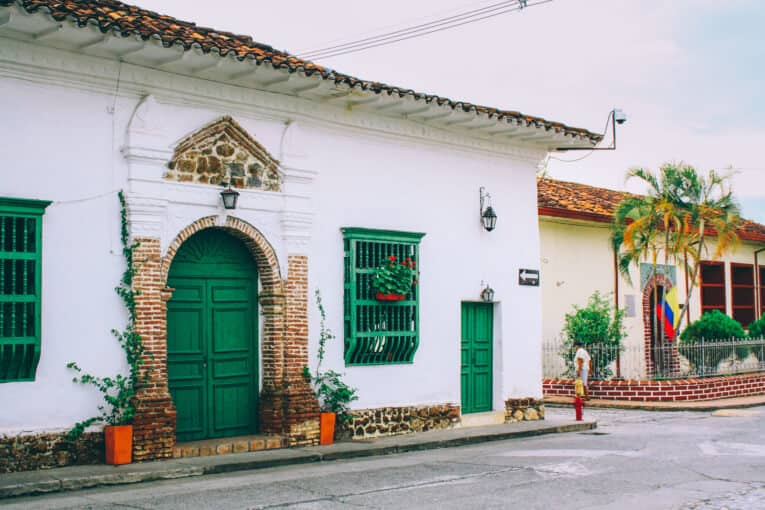
Guaduas
General info
- Founded: 1572
- Population: 31.000
- Altitude: 992m
- People: Guadueros
- County: Cundinamarca
How to get to Guaduas
- Nearest airport: Bogota
- By bus from Bogota: 3h30
- By car from Bogota: 123 km
Our recommendations for accommodation in Guaduas
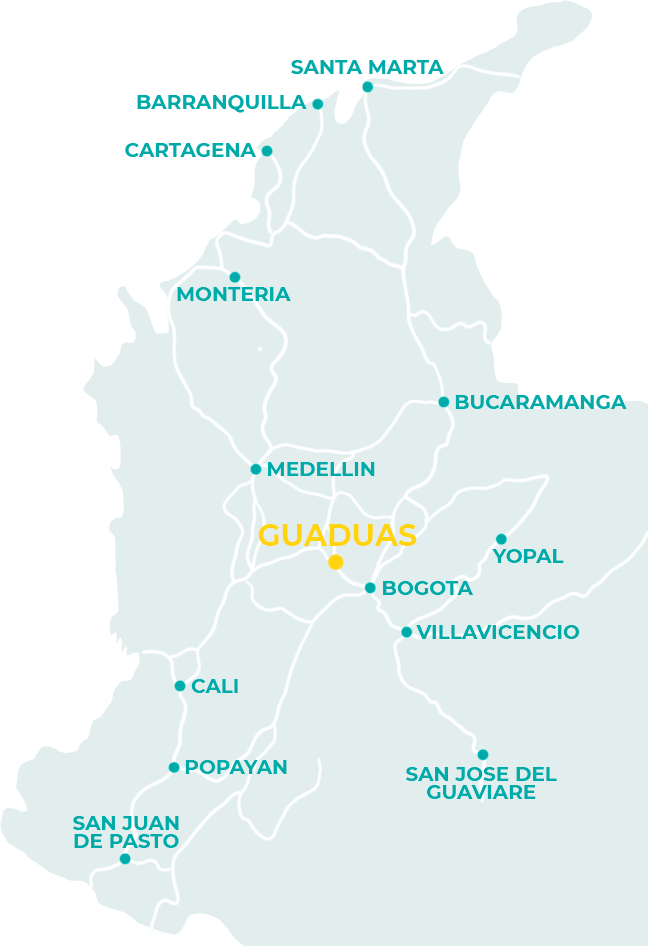
Villa de Leyva, Boyacá
Heritage Towns of Colombia
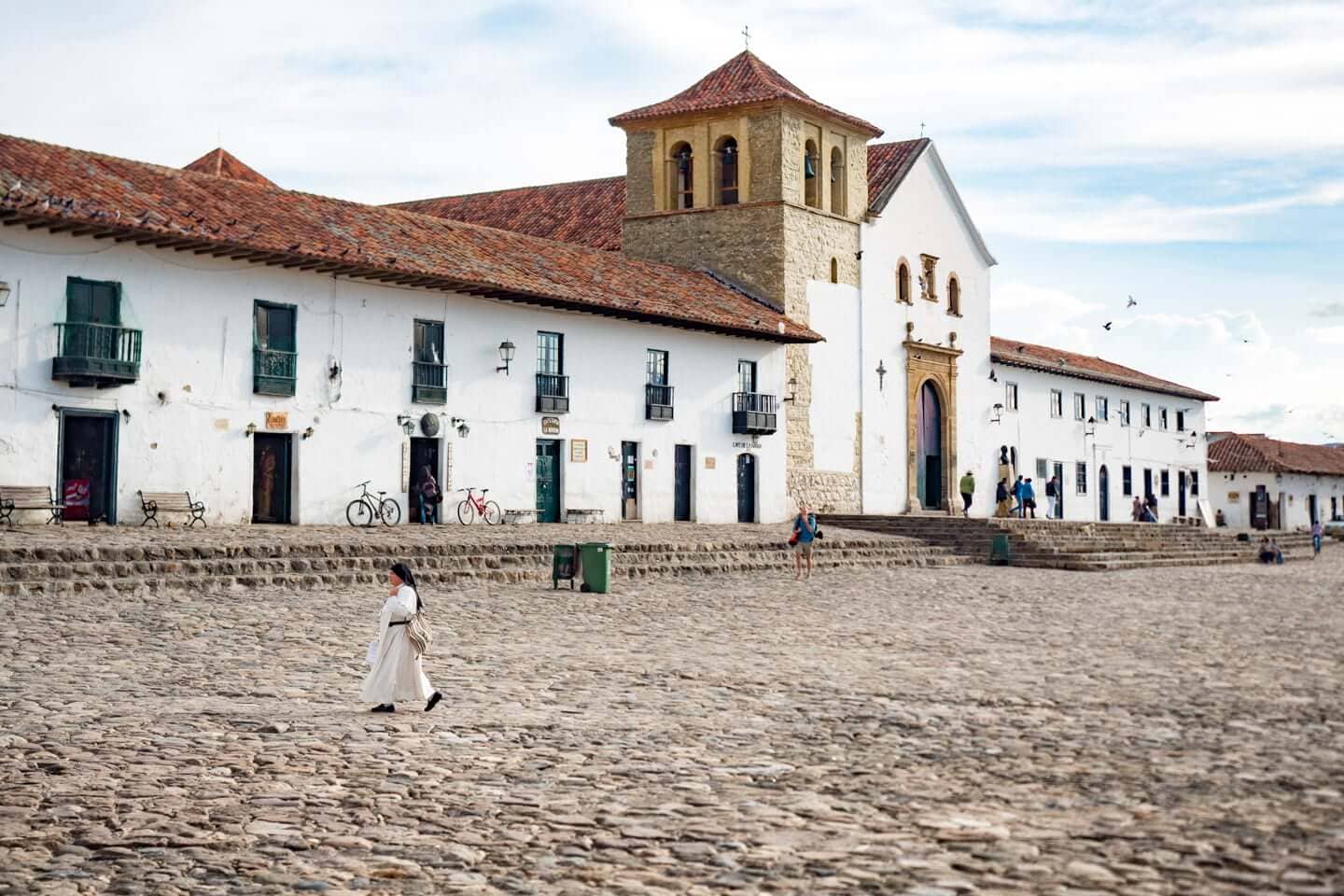
Villa de Leyva is located in the department of Boyacá, a few hours north of the capital Bogotá. Renowned throughout the country, it’s one of Colombia’s most beautiful villages, and one of Angélica’s favorites, because it reminds her of her childhood!
Villa de Leyva is a village steeped in history, known as the “Ciudad madre”, the “mother town”. Here, you can stroll along cobbled streets, past houses with whitewashed walls adorned with sublime bougainvillea. The village boasts one of the largest cobbled squares in South America.
While Villa de Leyva is renowned for its well-preserved colonial architecture, you can also discover the remains of indigenous influences in the surrounding area, including the remains of an indigenous astronomical site.
Points of interest in Villa de Leyva
- Plaza Mayor: Villa de Leyva’s huge, unmissable central square.
- Church of Nuestra Señora del Rosario: located on the Plaza Mayor and built between 1608 and 1665.
- Casa Museo de Nariño: dating from the 17th century, this house is a tribute to Antonio Nariño, famous for translating and disseminating the Declaration of Human Rights.
- Plaza de Ricaurte: a park erected in honor of Antonio Ricaurte, hero of the War of Independence. It features the house where he was born and the 16th-century San Agustin convent.
- Calle Caliente: shopping street with many local craft stores.
- El Carmen Museum: created in 1971 by the Carmelite community of Villa de Leyva.
Near Villa de Leyva
- Iguaque Natural Park : a beautiful natural park to discover the flora and fauna of the local mountains
- Convento Ecco Homo: a beautiful 17th-century Dominican convent about 15 km from Villa de Leyva.
- Dinosaur Park : a small theme park, as Villa de Leyva is a land of dinosaurs, many fossils have been found in the region.
- El Fossil” museum: the famous fossil, the remains of a 12 m-long marine reptile discovered in 1977
- El Infiernito: archaeological site of a Muisca astronomical observatory. A sort of giant calendar, it was used to keep track of the year and the seasons.
- Raquira: a small village with typical Colombian handicrafts that we really like

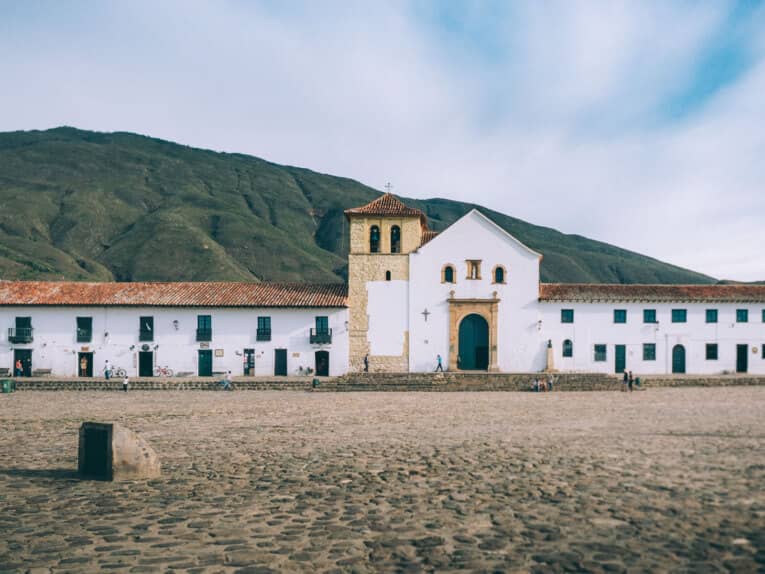
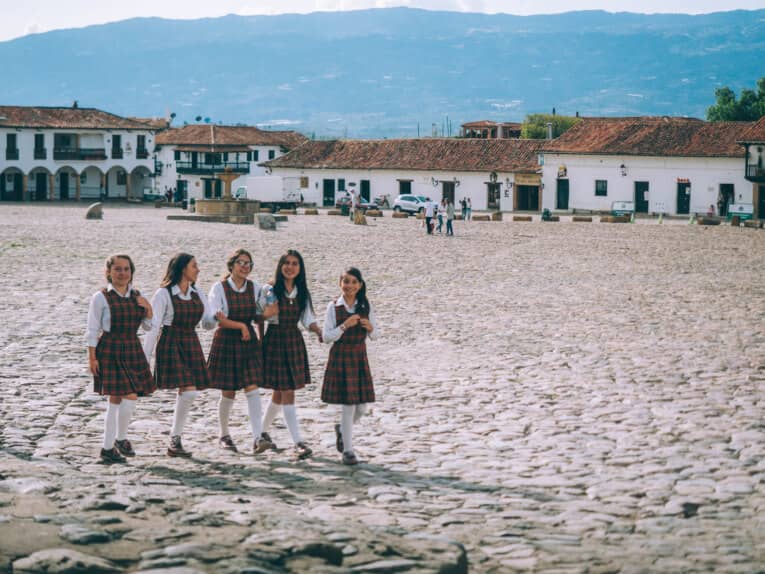



Villa de Leyva
General information
- Founded: 1572
- Population: 9650
- Altitude: 2150m
- People: Villaleyvano
- Department : Boyaca
How to get to Villa de Leyva
- Nearest airport: Bogota
- By bus from Bogota: 2h30 and around $25.000
Our recommendations for accommodation in Villa de Leyva
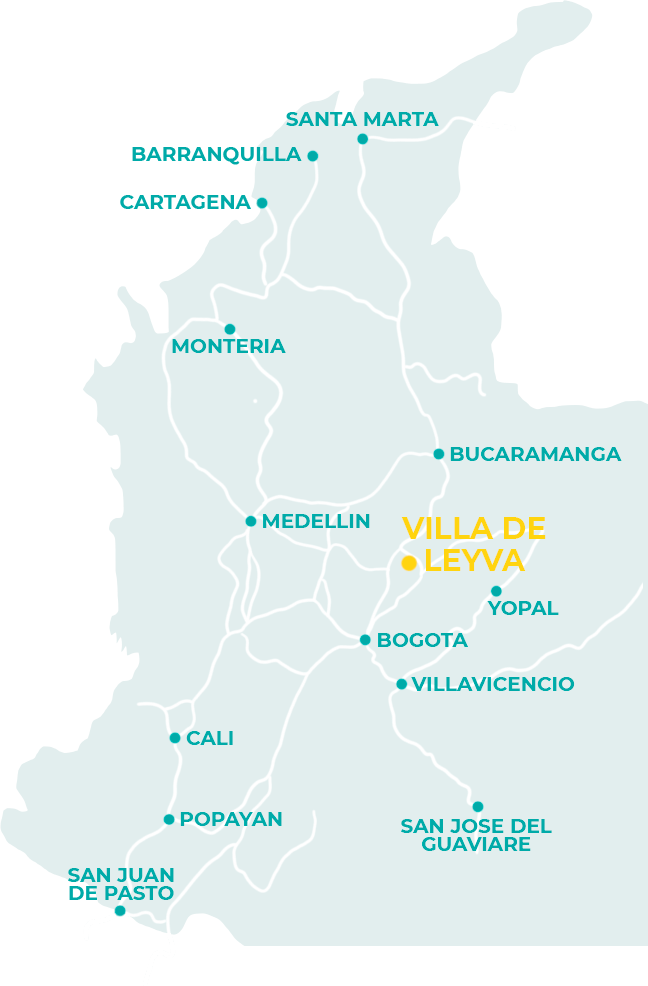
Mongui, Boyaca
Heritage villages in Colombia
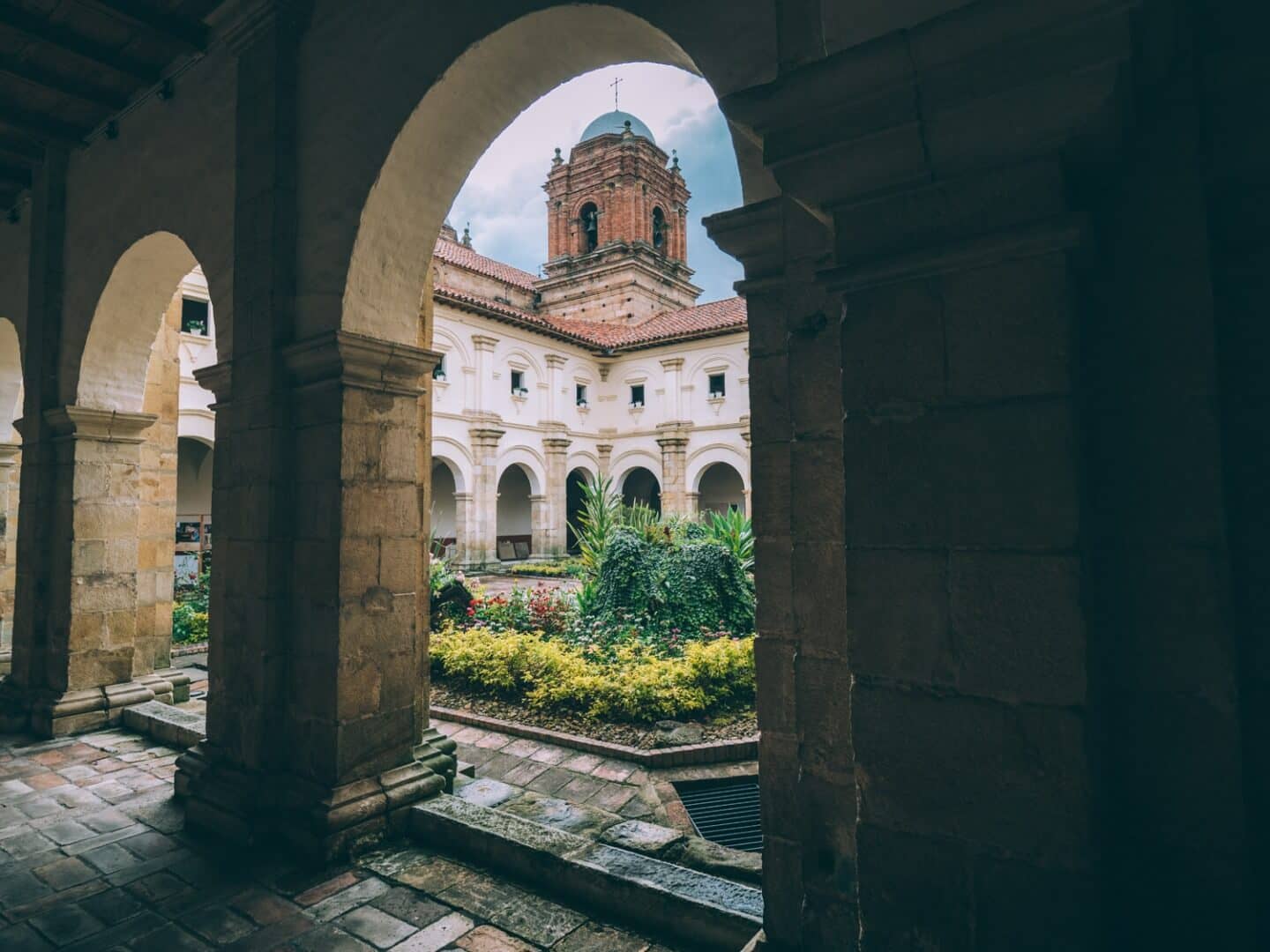
We discovered Monguí recently, because we wanted to go to the Páramo de Ocetá, a sublime páramo in the Boyacá department. We wanted to hike with Angélica’s dad for a weekend from Bogotá, so we took the opportunity to discover the village of Monguí, the starting point of the trek.
It’s an authentic little village perched high in the mountains (2900 m), with a tradition of hand-made footballs, and many workshops still in operation.
We took a guided tour of the historic center, visiting the magnificent former convent, where we learned a little about the cruel history of the forced evangelization of the local indigenous communities during the colonial era.
We also went into a balloon-making workshop where we made a small balloon ourselves, which was really fun! Our trek to the Páramo de Ocetá and the village of Monguí, a quiet, welcoming village that exudes Boyacense culture, will stay with us for a long time.
Monguí points of interest
- Main square: the focal point of village life, it features four monuments illustrating the village’s activities: a woman sewing a ball, a coal miner, a soccer and the bust of Father Alonso Ojeda, the village’s benefactor.
- Basilica de Nuestra Señora de Monguí: declared a national monument in 1975. The façade features the coats of arms of the kingdoms of Aragon and Castile, a reference to the period of Hispanic influence.
- Franciscan convent: located next to the basilica, it houses an exhibition of ancient paintings.
- Chapelle de San Antonio: built in the 17th century, this was the village’s first religious building.
- Puente Real de Calicanto : bridge built by the indigenous Sanoha people under Spanish supervision in 1603 and completed in 1715.
Near Monguí
- Páramo de Ocetá : an unmissable trek if you’re passing through Monguí, in a magnificent Paramo at around 4.000 m altitude.
- Mongüa: small village a few kilometers from Monguí, starting point for other walks to Páramo de Ocetá.
- Peña de Otí: a mirador with a fine view over the region, a leisurely hike that allows you to appreciate the variety of plant species present.
- Cascada La Virgen : small waterfall in the village of Pericos, where the Virgin Mary is said to have appeared.
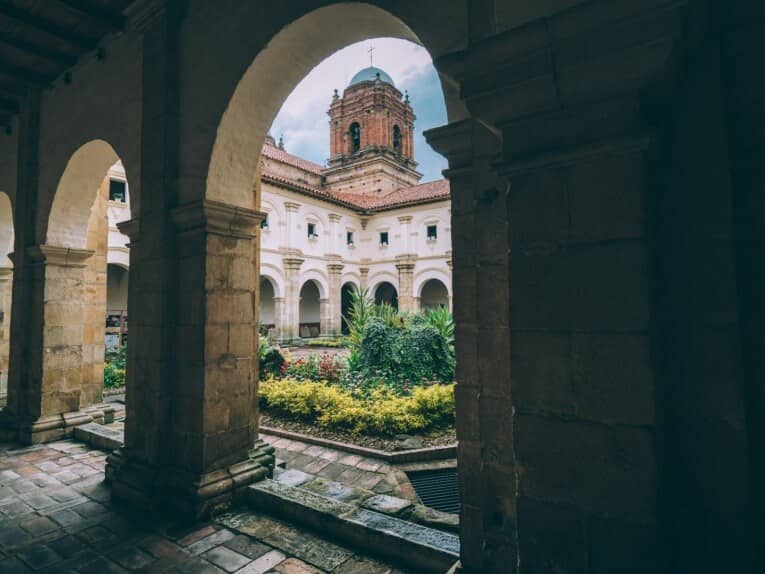
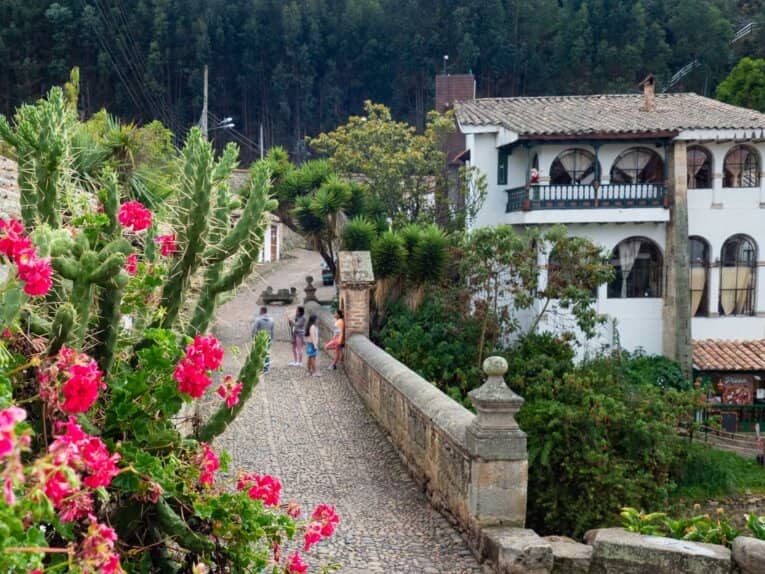
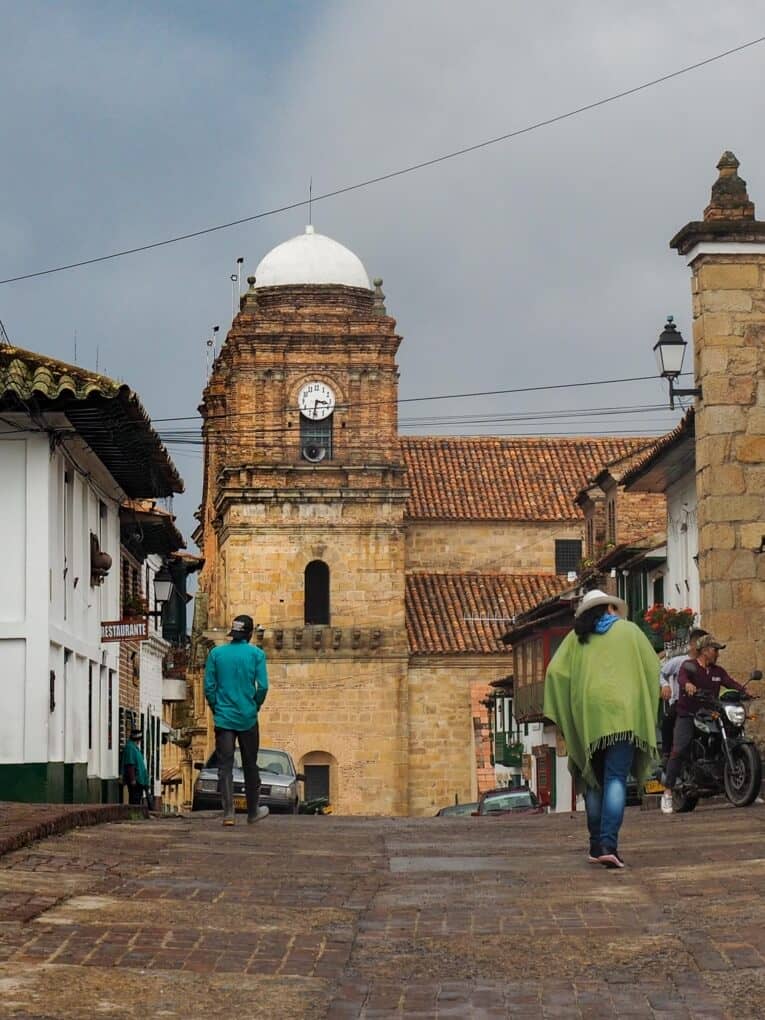
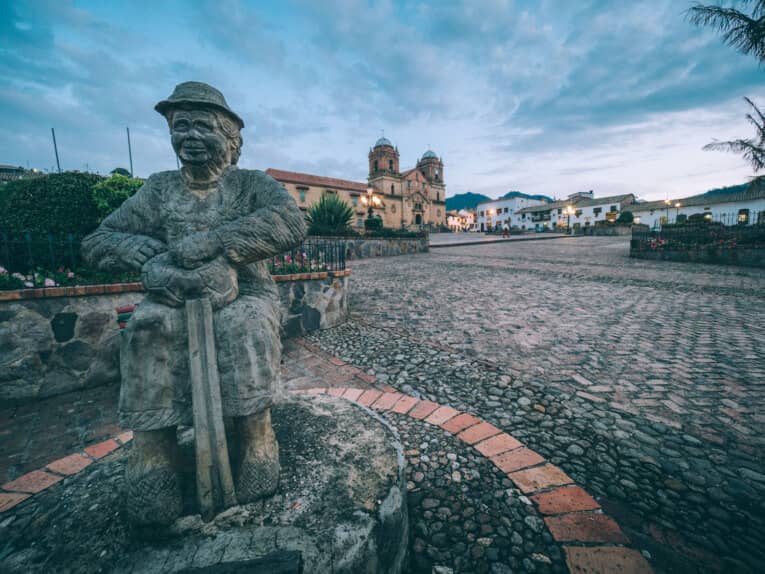

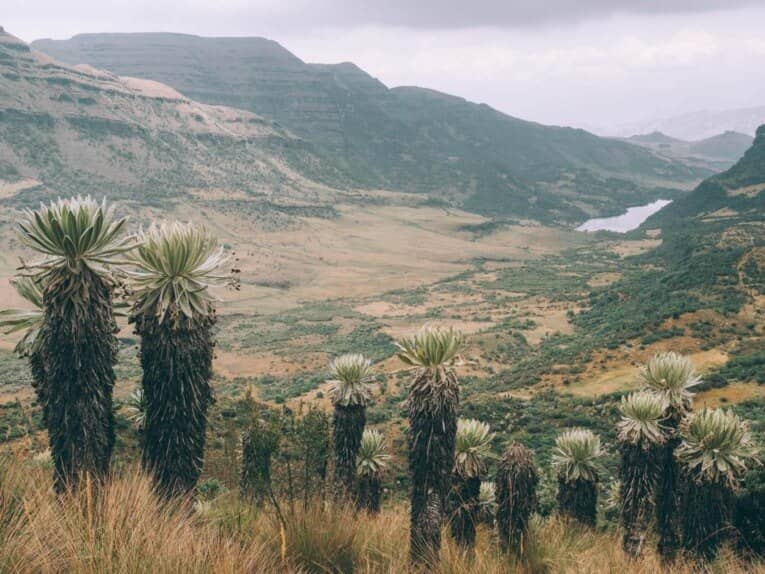
Mongui
General info
- Founded: 1601
- Population: 4986
- Altitude: 2900m
- People: Monguiseño
- Department : Boyaca
How to get to Mongui
- Nearest airport: Bogota
- By bus from Bogota: about 5 hours and about $35.000
Our recommendations for accommodation in Mongui

Socorro, Santander
Heritage villages of Colombia
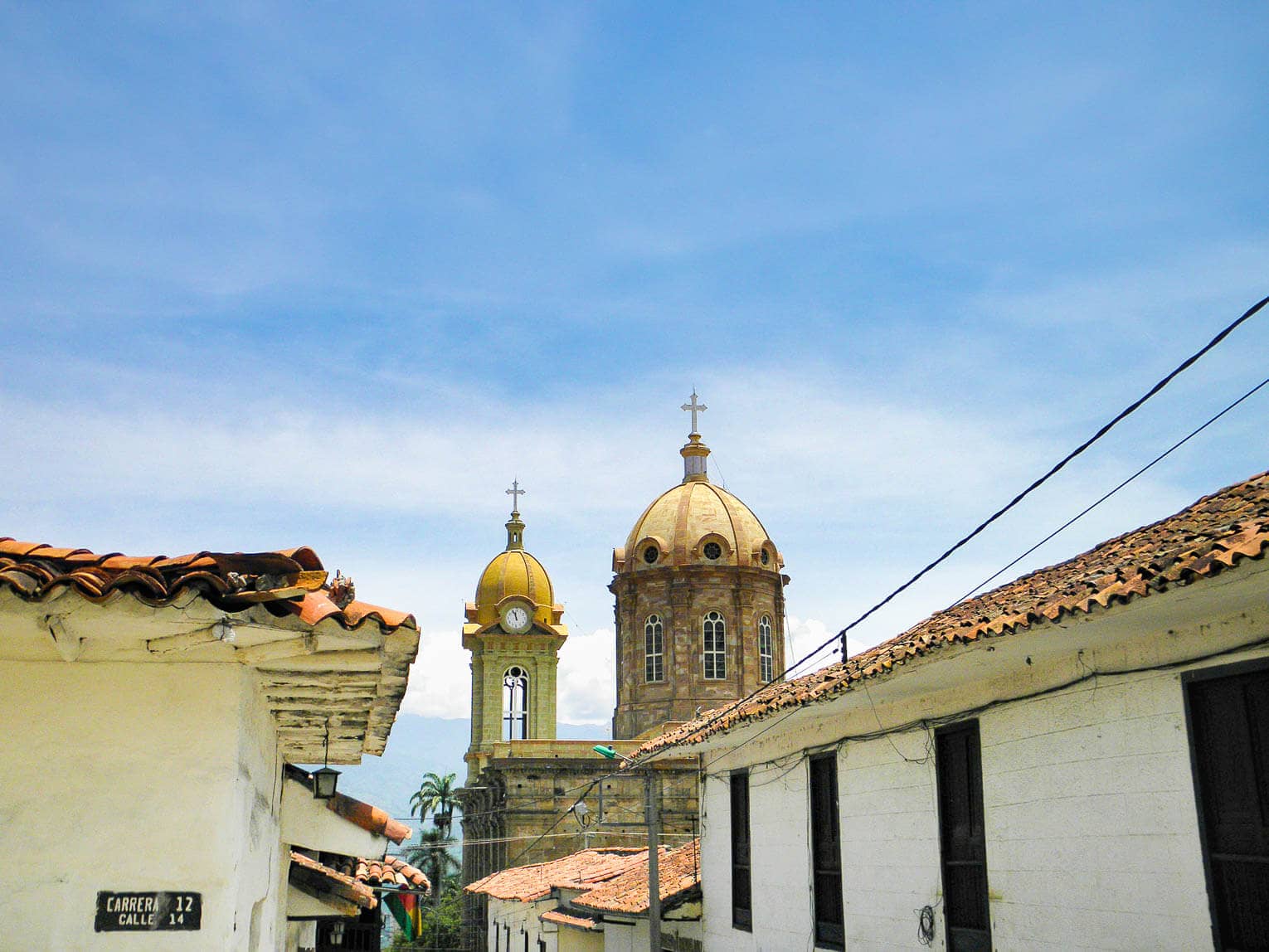
Socorro is a missed opportunity for us! It was a planned stop on our road trip between Bogota and Santa Marta, but the vagaries of organization meant that we didn’t have time to stop in the end.
Socorro is of great importance to national history, as it was the site of a series of events that led to Colombia’s independence, such as the signing of the National Independence Act.
Today, a visit to Socorro’s historic center will reveal traces of this great history in every corner of its narrow streets, houses and churches..
In Socorro, you’ll find a wealth of churches, chapels, monasteries and convents, and typical architecture with stone bases, adobe walls and tiled roofs.
El Socorro is famous for its gastronomic specialties: sopa de mute (a soup made from shucked corn), tamal santandereano (a corn paste mixed with various ingredients and covered with banana leaves) And for the handicraft traditions found throughout Santander: fique, cotton and tobacco.
Socorro points of interest
- State Capitol : built in 1872 when El Socorro was the sovereign state of Santander department, today it houses the Palace of Justice.
- Basilica of Nuestra Señora del Socorro : built in 1873, it is considered Colombia’s third-highest basilica.
- Independence Park: the historic site of the communal uprising and the War of Independence.
- Casa de la Cultura: a former colonial-style manor house with themed rooms housing antiques.
- Chapelle La Inmaculada Concepción : church converted into a pantheon for the heroes of independence.
- Chapelle Santa Bárbara : renowned for its sculpted stone façade.
- House of Juan Francisco Berbeo: one of the oldest in Colombia.
Near Socorro
- Barichara: sublime village near San Gil
- Las Gachas: natural pools near the tranquil village of Guadalupe
- Chicamocha: one of the world’s largest canyons
- San Gil : Colombia’s adventure sports capital

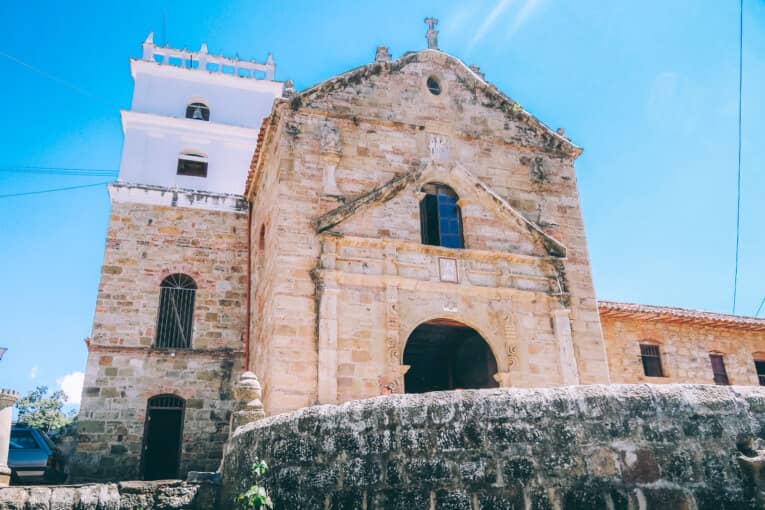




Socorro
General info
- Founded: 1683
- Population: 30.847
- Altitude: 1300m
- People: Socorrano
- County : Santander
How to get to Socorro
- Nearest airport: Bucaramanga
- By bus from Bucaramanga: 2h30 and around $25.000
- By bus from San Gil: 1/2h
- By bus from Barichara: 1h
Our recommendations for accommodation in Socorro
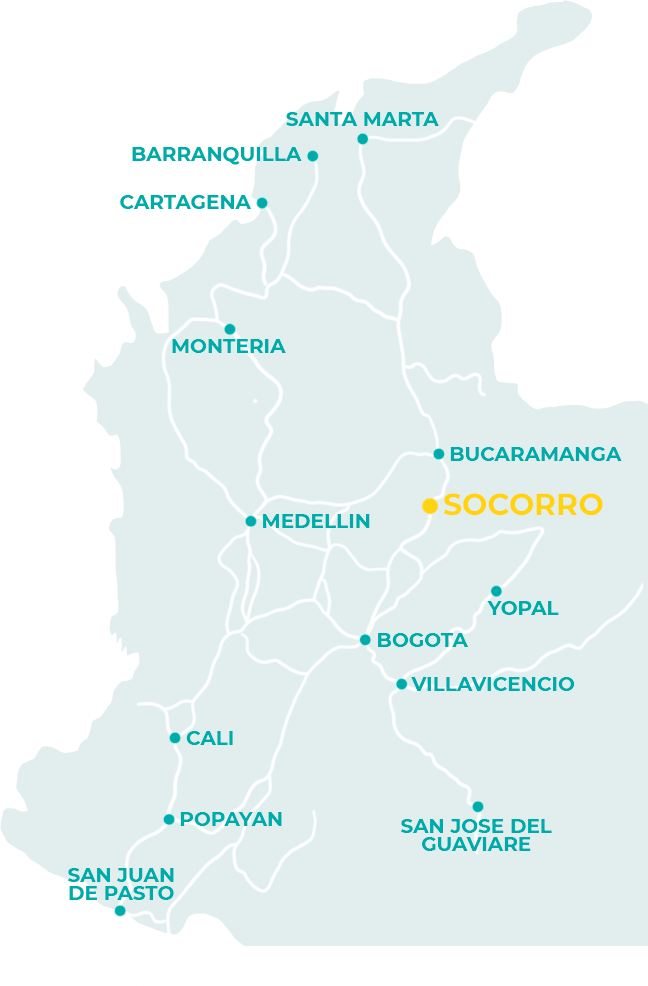
Barichara, Santander
Heritage villages in Colombia
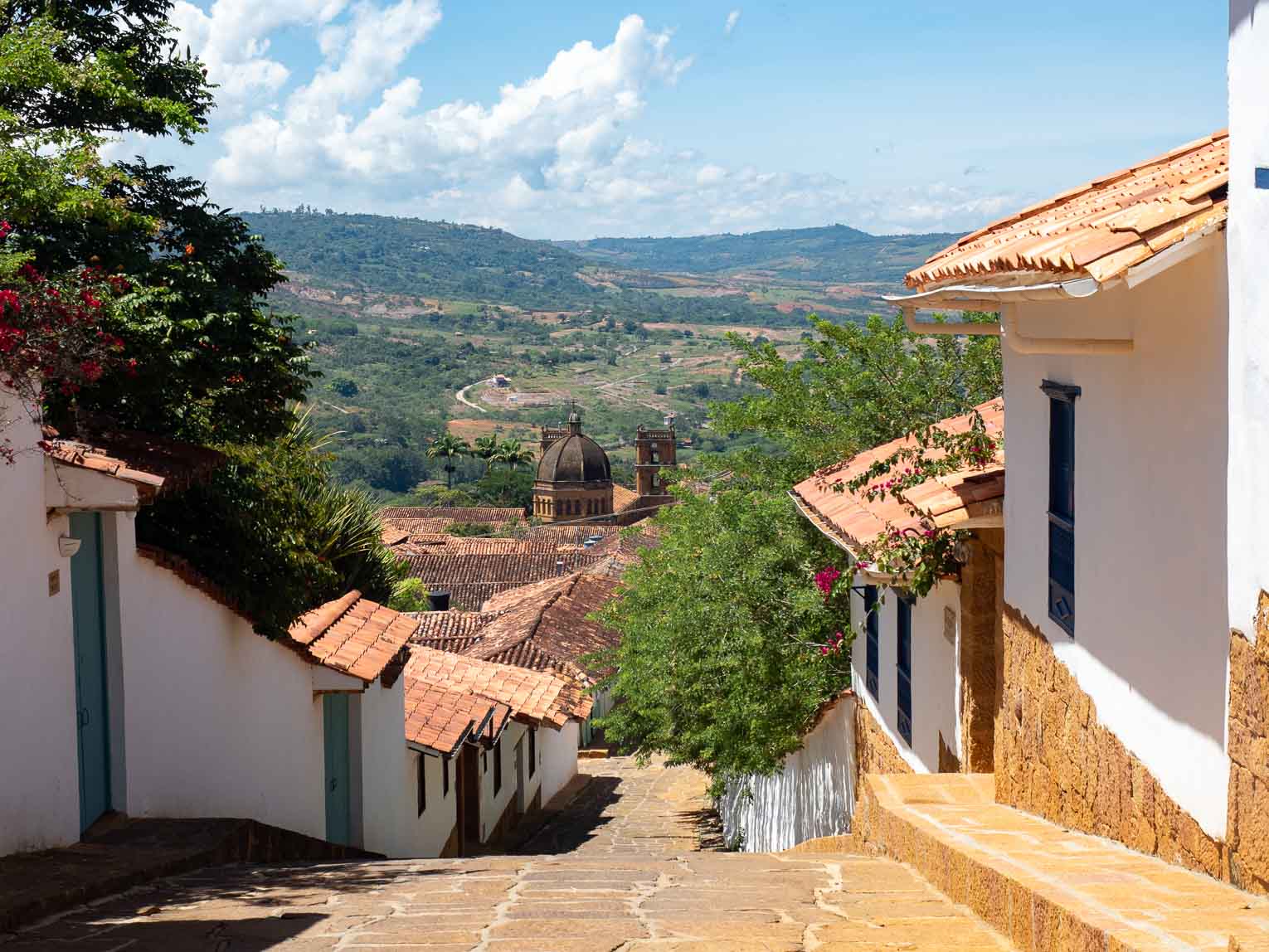
You probably know it, or if you don’t, we’ll tell you again: Barichara is one of our favorite Colombian villages. We loved this village and the people we met there, and we’ll tell you all about our discovery in our post dedicated to Barichara.
Barichara is clearly one of the most beautiful villages in Colombia. Its well-preserved architectural identity is absolutely magnificent, and the views from the village are each more spectacular than the last. Its historic center was declared a national monument in 1975.
There are plenty of handicraft workshops and a number of associations working to integrate single women with children and the elderly.
From Barichara, you can take a short hike to the authentic village of Guane, in the footsteps of the indigenous people of the same name. And if you’re feeling more adventurous, you can descend to the bottom of the Chicamocha canyon (you’ll need to be well prepared).
Barichara points of interest
- Templo de la Inmaculada Concepción y San Lorenzo Mártir: built in stone over a period of twenty years, it is the pride of the local population.
- Chapelle Santa Barbara: dating from the late 18th century, it features sculptures of a cross, oxen ploughing the land and a 250-year-old Ceiba tree.
- Casa de la Cultura: a sublime Colombian house dating from the 18th and 19th centuries, where you can discover the memory of Barichara (fossils, farming tools, photographs, etc.)
- Calle Real: built by the indigenous Guanes and preserved by the colonists, this is the street that leads to the Santa Barbara chapel.
- Cemetery: a fine example of the artistry of the village’s stonemasons.

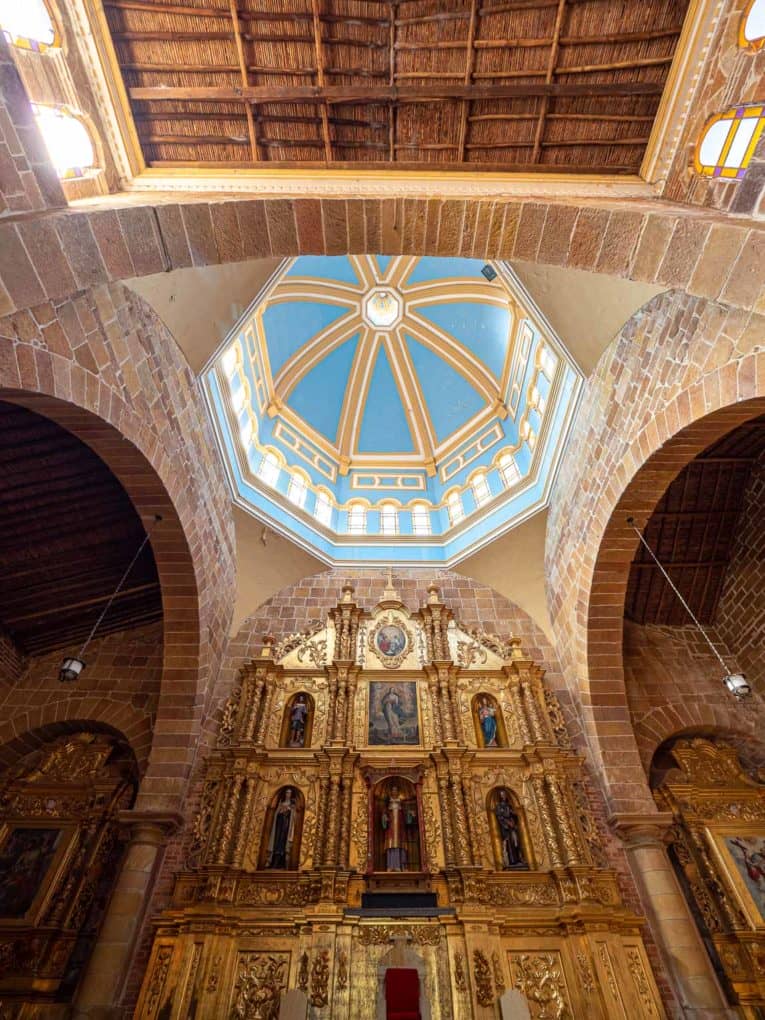
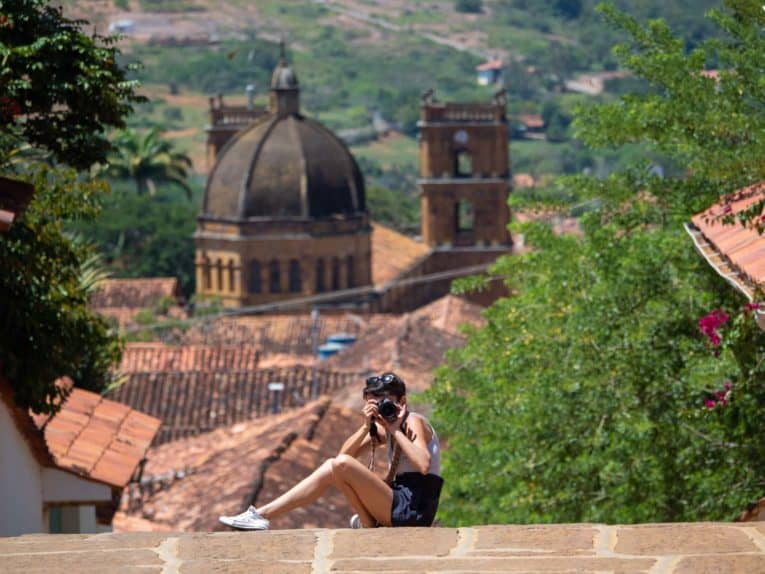

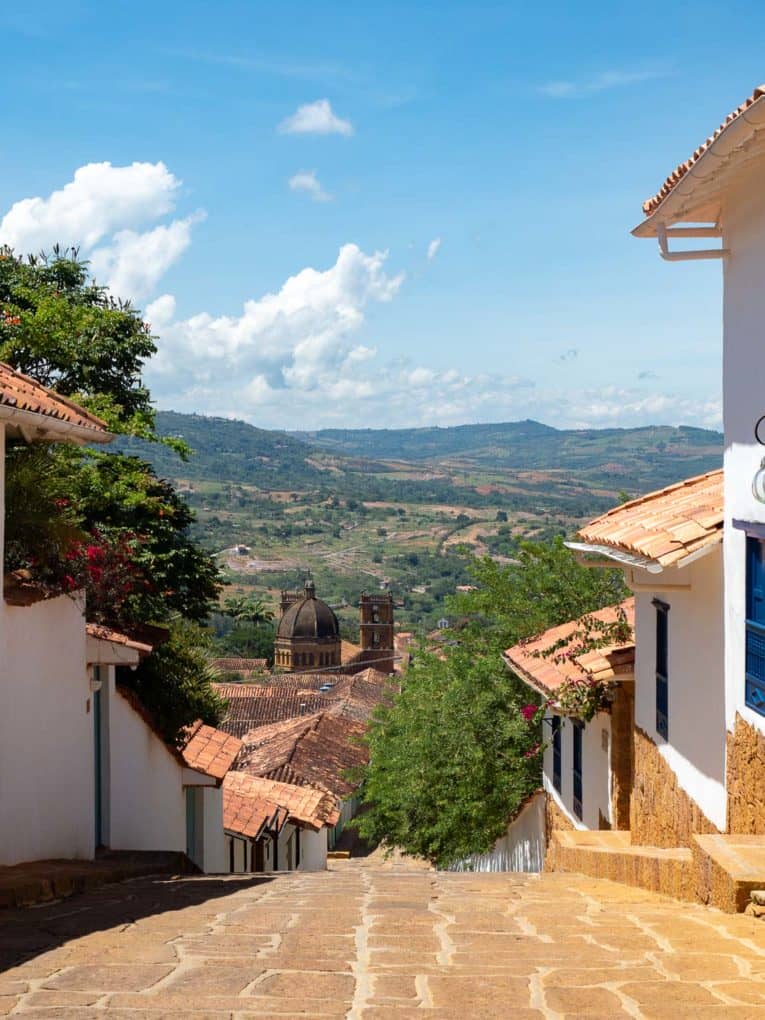
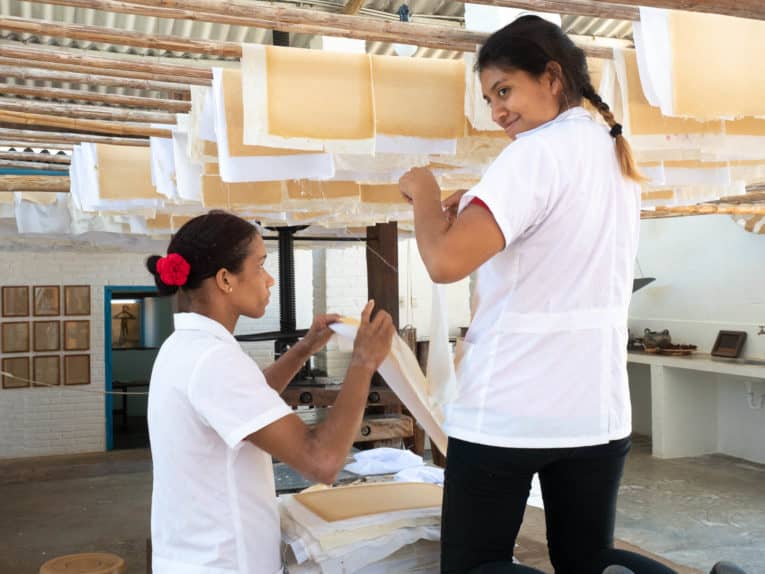
Around Barichara
- Guane: an authentic little village reached by a genuine “camino real”.
- Chicamocha : one of the world’s largest canyons
- San Gil: Colombia’s capital of adventure sports
- Cascade Juan Curi : sublime waterfall south of San Gil
- Socorro: preserved historic center
Barichara
General information
- Founded: 1705
- Population: 7215
- Altitude: 1336m
- People: Barichara
- County: Santander
How to get to Barichara
- Nearest airport: Bucaramanga
- By bus from Bucaramanga: approx. 3h30 and $25.000
- By bus from San Gil: approx. 45 min. & $5.000
Our recommendations for accommodation in Barichara
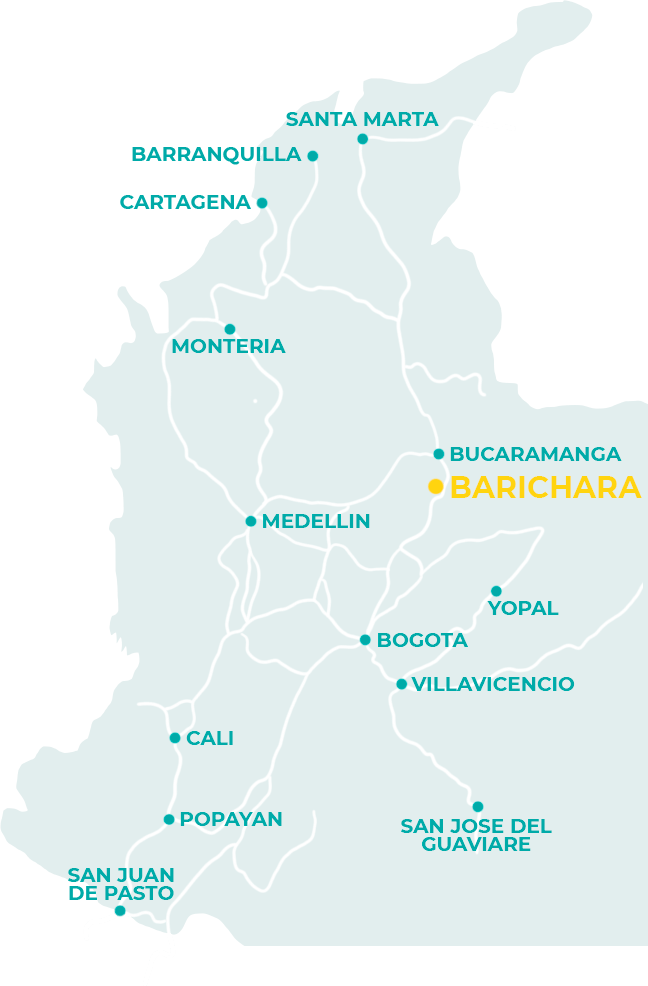
Giron, Santander
Heritage towns of Colombia

Giron is a surprising town: when you arrive, you feel as if you’ve been swallowed up by the huge conurbation of Bucaramanga. And yet, once you’ve made your way through the traffic jams into the historic center, you’ll discover an architecture that has been totally preserved in the style of a small village.
Whitewashed walls, cobbled streets, black wooden doors and shutters are all part of San Juan de Giron‘s identity as a Colombian heritage site.
We spent a night here during our road trip between Bogota and Santa Marta. Located right next to the Bucaramanga airport, it was the perfect place to pick up Angélica’s dad, who would be accompanying us on the rest of our road trip.
Until recently, the region was home to numerous tobacco crops and cigar factories. Angélica had long wanted to discover the tobacco tradition, and by asking the locals, we were able to visit a traditional cigar-making workshop.
Giron points of interest
- Main park: where life is in full swing and the basilica is enthroned
- Mansión del Fraile: a building representative of colonial architecture that is said to have housed Simon Bolivar on three occasions.
- Tourist Malecon: located on the banks of the Rio de Oro, this is not an exceptional place, but it does boast a number of traditional restaurants and craft sales. At night, it’s the place to party.
- Alameda Las Nieves: stroll along the river that runs through Giron, on the Alameda Las Nieves, and enjoy the natural landscape as you cross the six bridges built of stone or calicanto.
- Parque Las Nieves: a small square with the traditional Capilla de Las Nieves, an ancient cloister surrounded by gardens.
- Cigar-making workshop: one of the curiosities of Giron and the surrounding region, where tobacco is still grown.
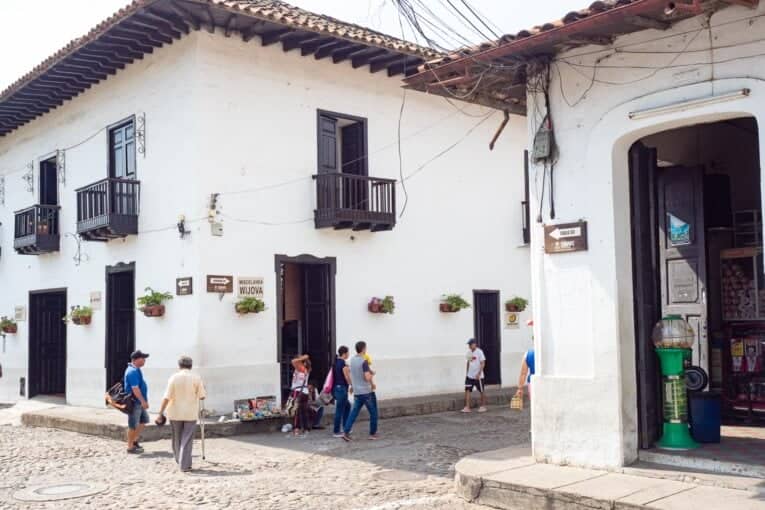
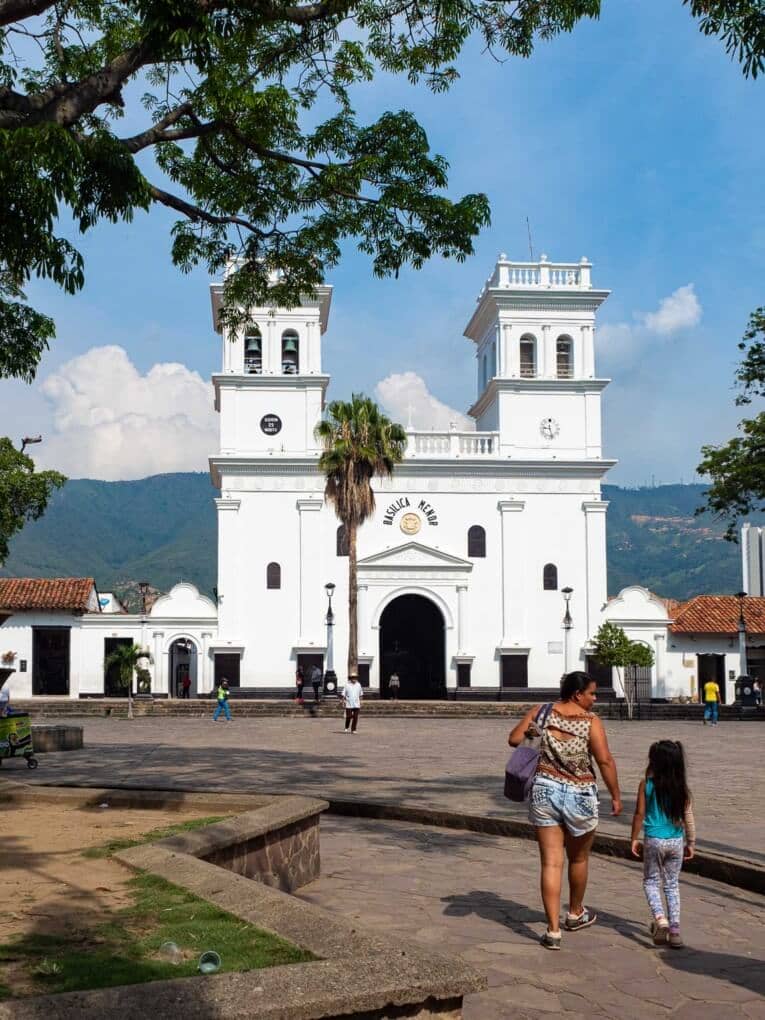
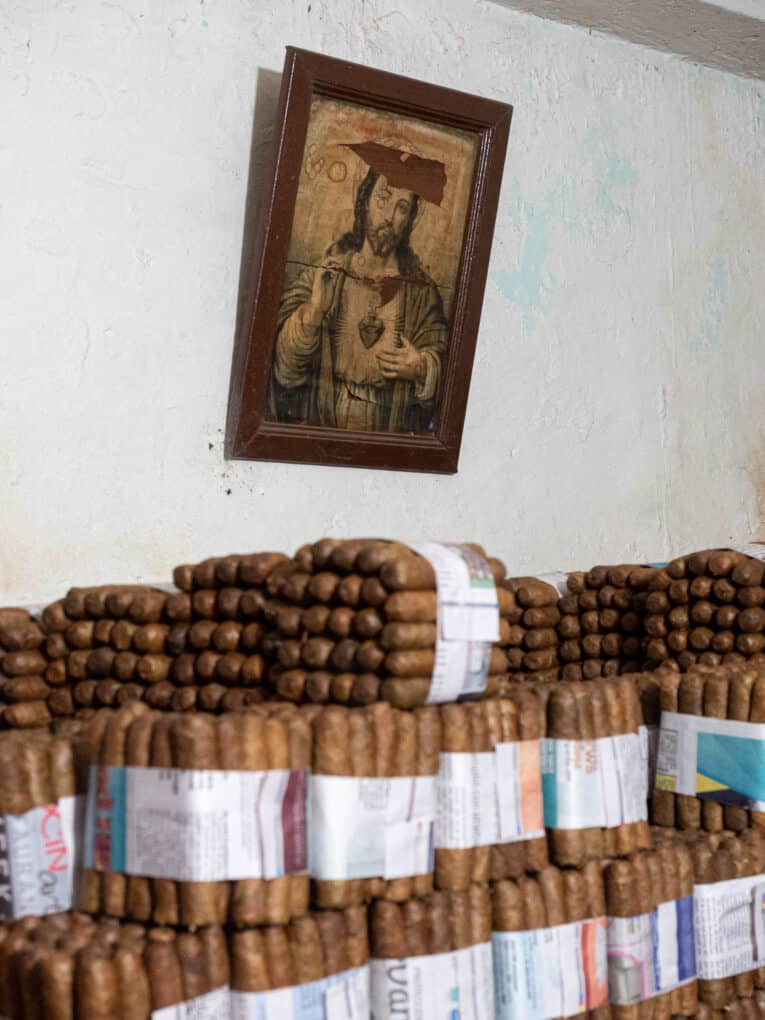

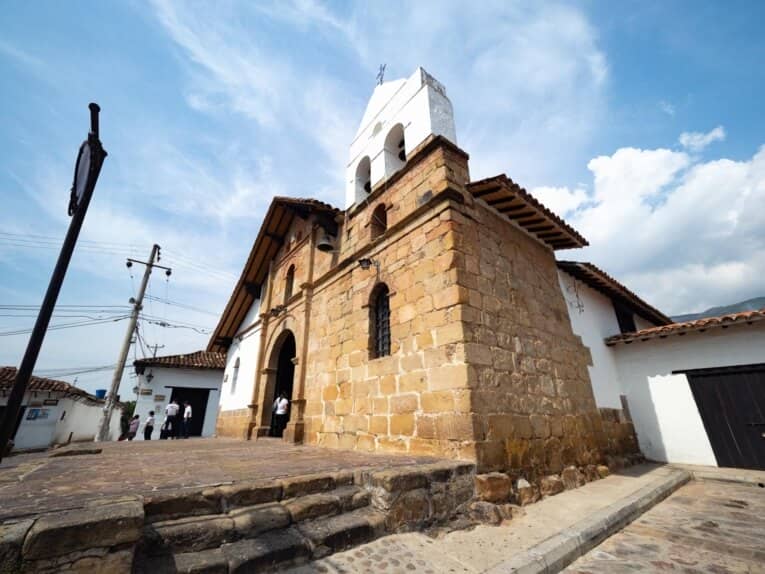

Around Giron
- Cañon de las Iguanas: on the road to Zapatoca, in the village of Chocoa, with a nature similar to the Chicamocha Canyon (cactus, aridity…). There are bathing spots and a 60 m-high waterfall.
- Humedal del Pantano: a natural marsh environment with a rich flora, where a conservation program is underway.
- Zapatacoa: a beautiful village 2 hours south of Giron.
GIron
General information
- Founded: 1631
- Population: 173.000
- Altitude: 777m
- People: Girones
- County: Santander
How to get to Giron
- Nearest airport: Bucaramanga
- By bus from Bucaramanga: about 3 hours and $20.000
- By bus from Bogota: approx. 6 hours and $60.000
Our recommendations for accommodation in Giron
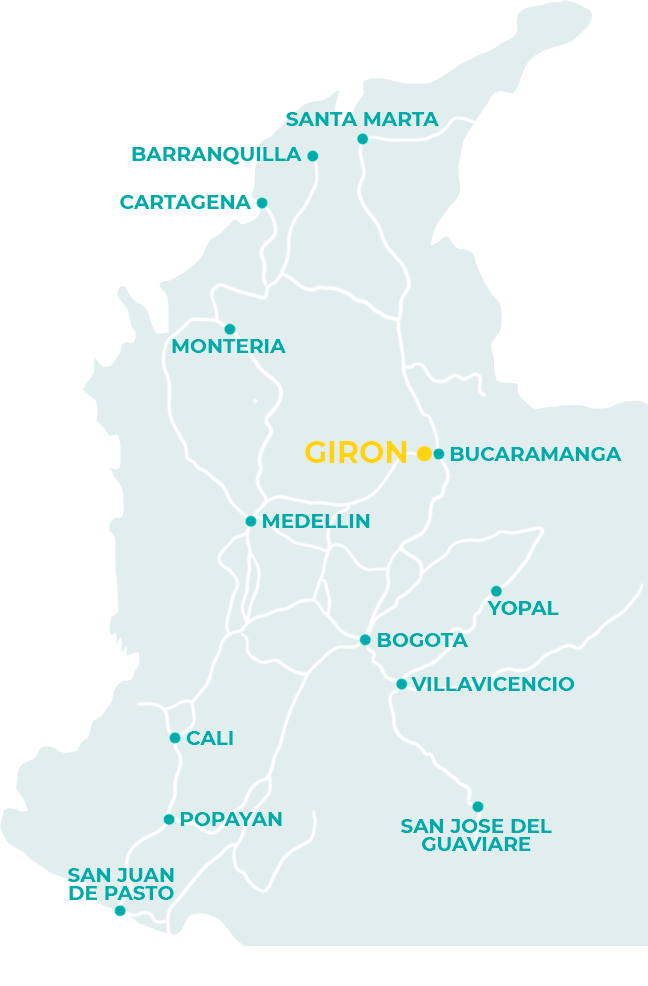
La Playa de Belen, Norte Santander
Colombia’s heritage villages

Another off-the-beaten-track village with real treasures to offer! Located in the department of Norte Santander, a tense region where guerrilla warfare is still very much alive, the village of La Playa de Belen is a peaceful oasis where security has returned in recent years.
We stopped here on our road trip between Bogotá and Santa Marta, to cut the road between Giron and Mompox, and it was a great idea! The village is very pretty with its white and red colors, but what’s most surprising is that it’s built in the middle of an incredible landscape: Los Estoraques.
Strange rock formations can be seen all around, and hiking inside the Los Estoraques natural park is THE thing to do if you’re passing through La Playa. We loved it! It really is a unique landscape.
La Playa de Belen points of interest
- Templo San José : neoclassical in inspiration, this is the main church of La Playa de Belen, with its two golden bell towers.
- Cemetery: situated on a plateau over 150 metres above sea level, it offers a 360-degree panoramic view of the town and Los Estoraques
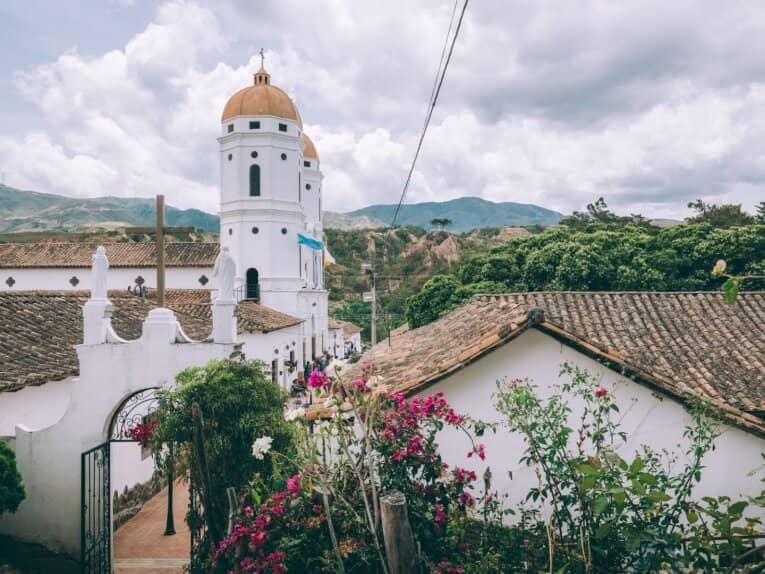
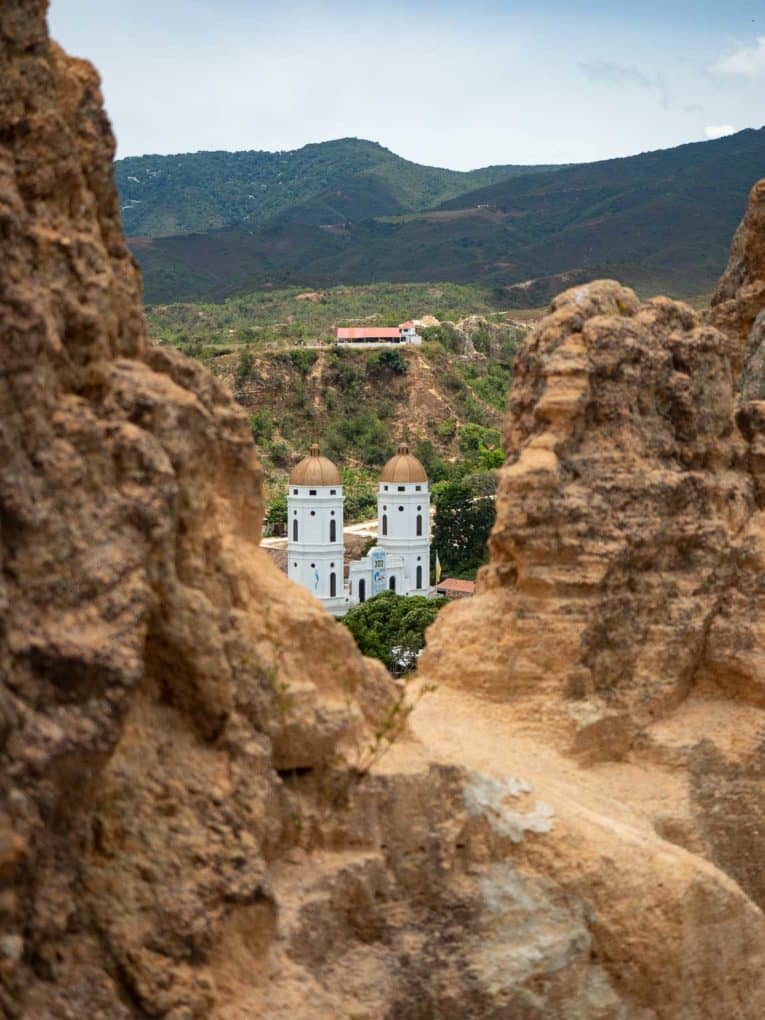
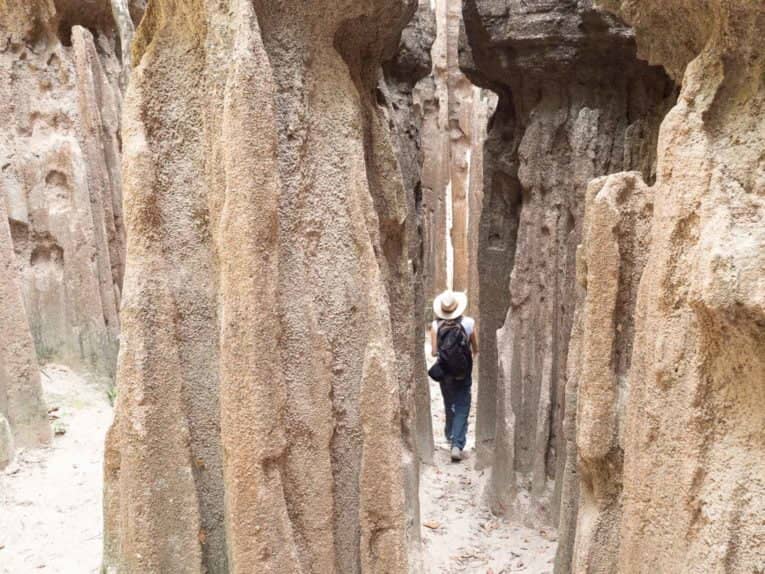
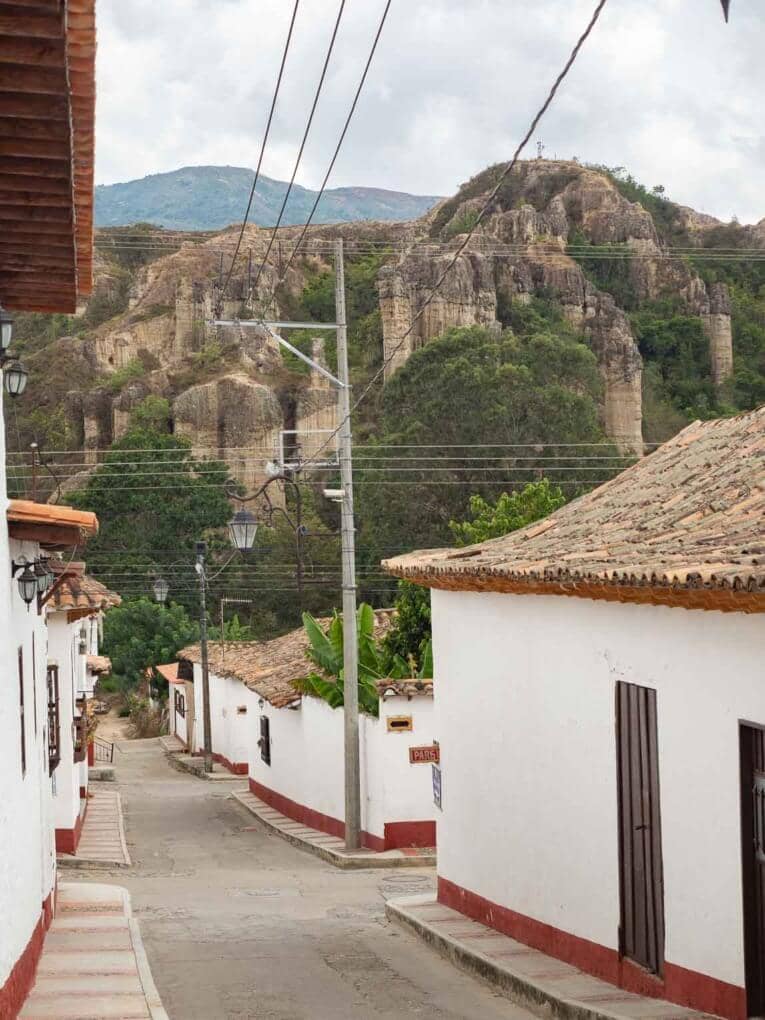


Around La Playa de Belen
- Mirador de Santa Cruz
- Mirador de los Pinos
- Los Estoraques: rock formations produced by erosion in a natural area considered unique of its kind.
- Los Aposentos: located at the entrance to the town, pays homage to the Virgin of Belen, and from here you can contemplate Los Estoraques in all its splendour.
Playa de Belen
General information
- Founded: 1862
- Population: 8.500
- Altitude: 1450m
- People: Playero
- County: Norte Santander
How to get to La playa de Belen
- Nearest airport: Bucaramanga
- By bus from Bucaramanga: about 6 hours and $70.000
Our recommendations for accommodation at La playa de Belen
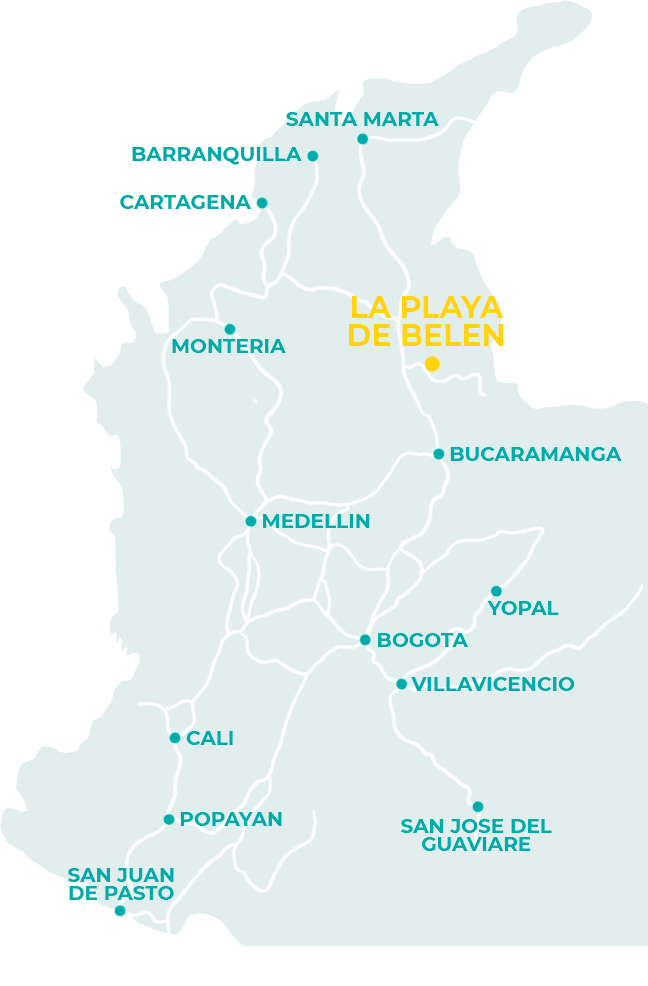
Mompox, Bolivar
Heritage towns of Colombia
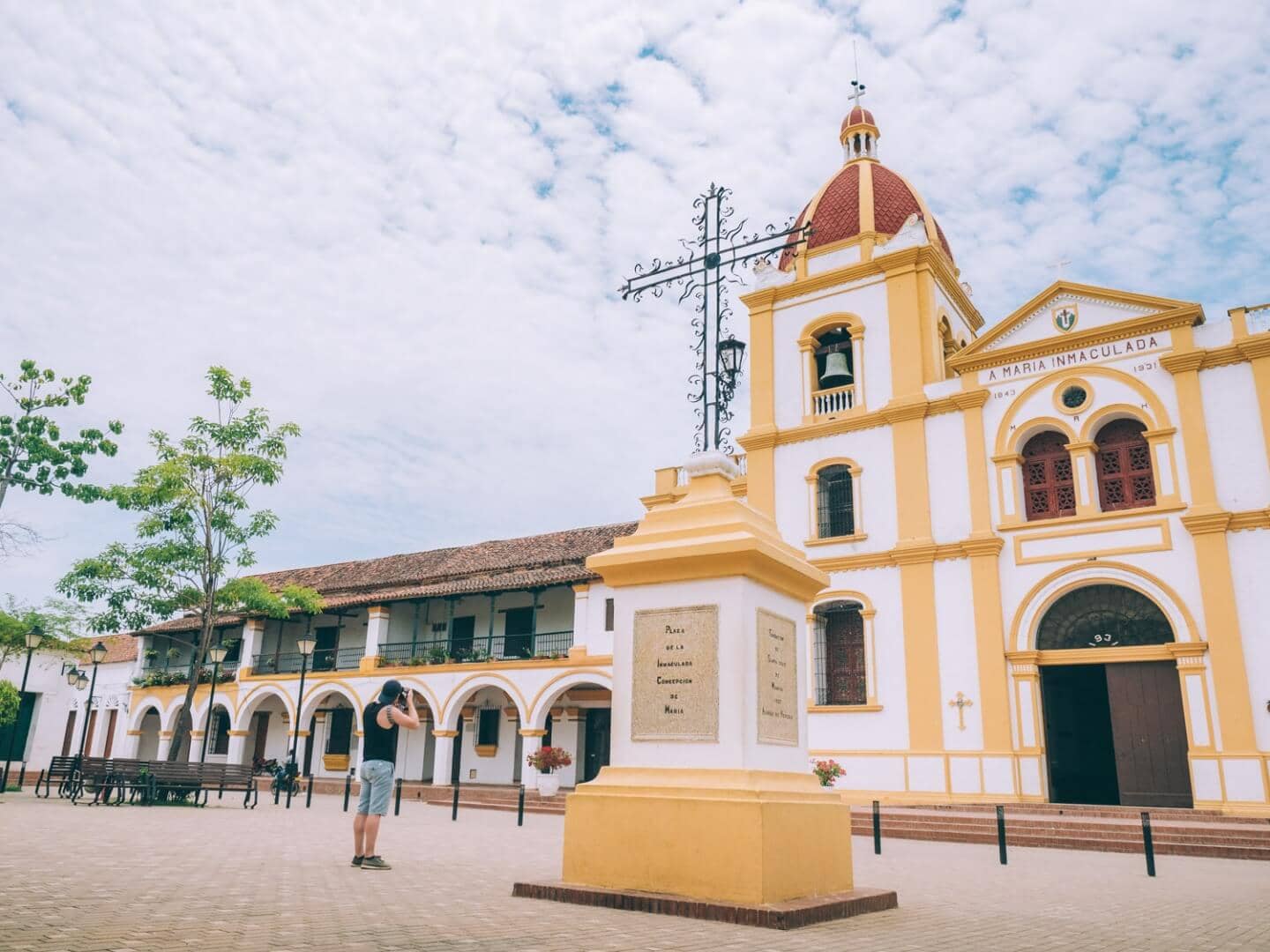
“You don’t pass through Mompox, you get there! With this saying and so many others linked to Mompox, it’s easy to understand why this town, located south of Cartagena, surrounded by the waters of the Magdalena, has a special, even mystical character.
For a long time, Mompox was one of Colombia’s most important and wealthiest cities, until the river and history decided otherwise, transforming it into a city “held in the past”.
Mompox’ s historic center is particularly well preserved and has been declared a World Heritage Site by UNESCO. Although Mompox is reminiscent of the colonial architecture of Cartagena de indias, the atmosphere is very different.
Turning towards the river, Mompox is an experience to be had and, until recently, was preserved from mass tourism with a wild authenticity. This may soon change, however, with the construction of a bridge and the opening of an airline making it much easier to reach by car from Cartagena.
We really recommend taking a historical tour of the city center! There’s so much to say about Mompox… we tell you all about it in our post on ideas for visits to Mompox and we’ve also written a practical guide to visiting Mompox.
Mompox points of interest
- Plaza Fundacional de la Concepción: located between the superb market and the church of the same name.
- Palacio Municipal : boasts the most important façade in Santa Cruz de Mompox and one of the most beautiful in the country.
- Cemetery: declared a National Monument, this cemetery is characterized by the whiteness of its tombs.
- Church of Santa Barbara: built around 1613, it keeps alive the story of this Catholic saint, Barbara, daughter of a superstitious, pagan father, accustomed to worshipping gods that didn’t exist in ancient Turkey.
- Stroll along the river: best done in the evening when the breeze rises slightly.
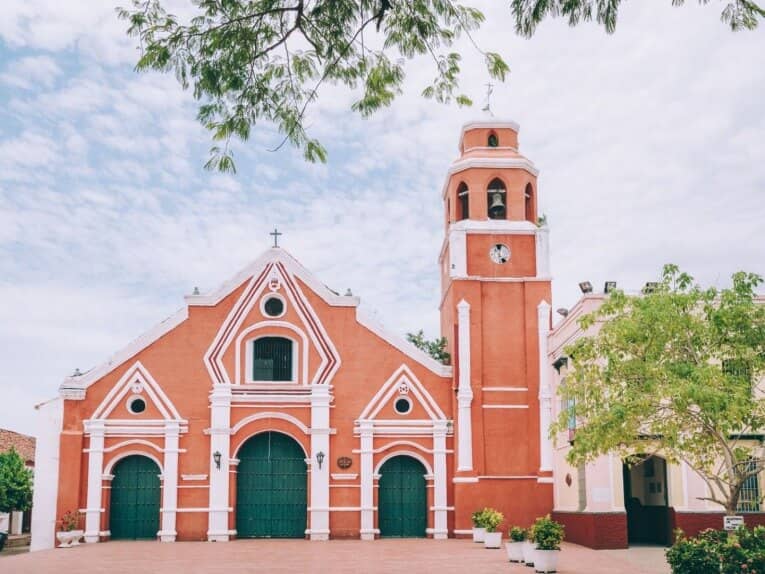

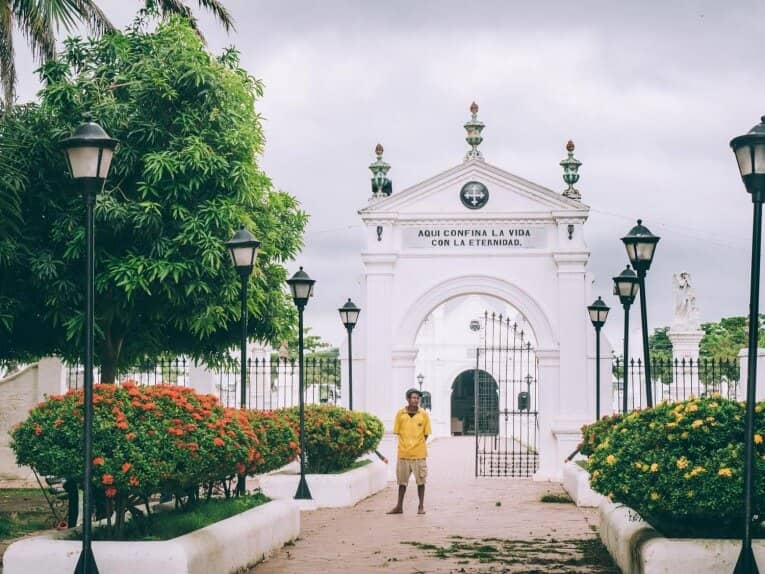
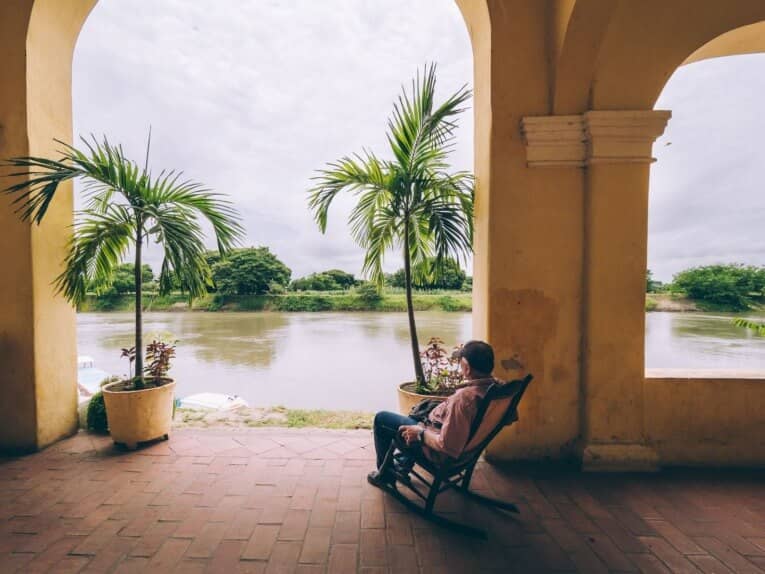

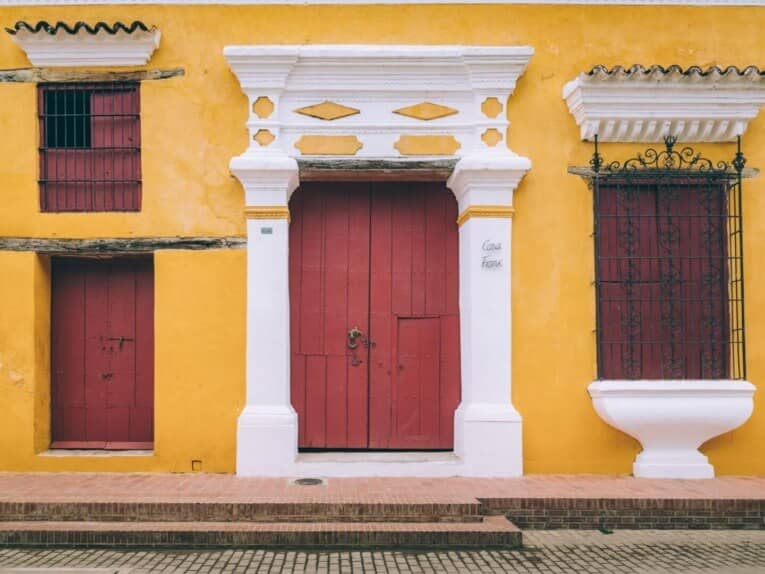
Around Mompox
- Ciénaga de Pijiño: huge lake ecosystem connected to the Magdalena River, where numerous birds and reptiles (iguanas, caimans) can be observed
Mompox
General information
- Founded: 1537
- Population: 44.000
- Altitude: 33m
- People: Momposino
- Department : Bolivar
How to get to Mompox
- Nearest airport: Sincelejo
- By bus from Sincelejo: about 3 hours and $70.000
Our recommendations for accommodation in Mompox
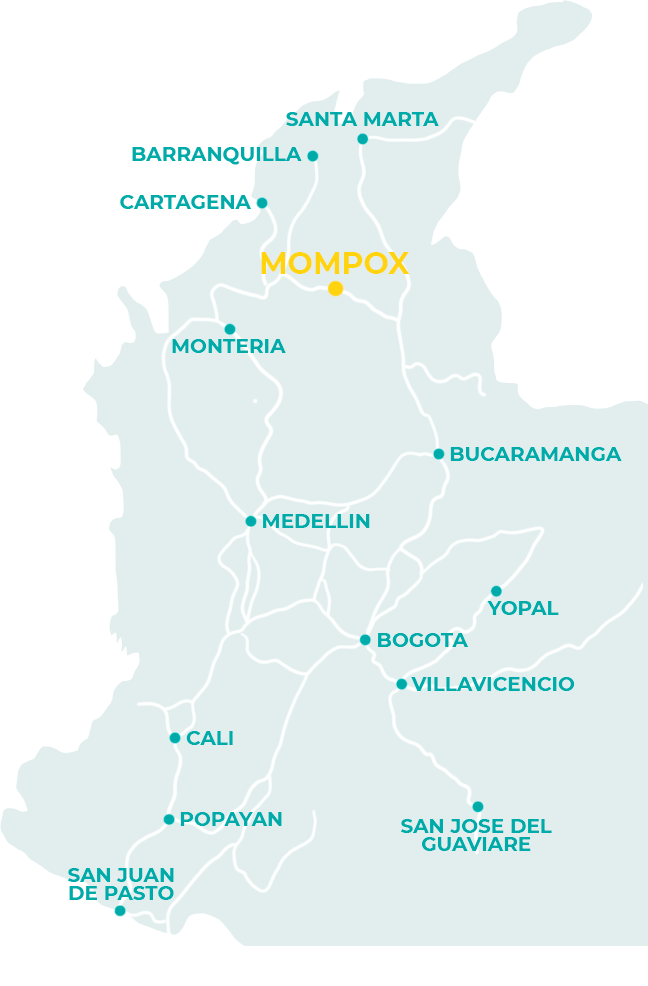
Cienaga, Magdalena
Colombia’s heritage towns

Cienaga Grande is perhaps better known than the village of Cienaga. But the historic center of Cienaga, just a few kilometers from Santa Marta, is well worth a visit. With some fine examples of colonial architecture, it has a very special atmosphere that (like many villages on the Caribbean coast) is said to have inspired Gabriel Garcia Marquez to write his many (and excellent) novels.
Coming to Cienaga is an opportunity to learn about the town’s history, and there’s no better way to do this than with our local partner, who offers guided historical tours of the town center.
You can also discover local handicrafts, with a wide variety of guineo (banana fiber) objects such as baskets, bracelets, bags and hats.
But if you’re in Cienaga, it’s unthinkable not to take a trip on the waters of the Cienaga Grande, to discover its unique ecosystem of fresh and salt water, and to explore the incredible stilt villages of Nueva Venecia and Buenavista.
GUIDED TOUR OF CIENAGA
Points of interest in Cienaga
- Centennial Park : located in the central square, this was the site of the public market and popular festivals.
- Municipal temple : inspired by Roman temples, located in Ciénaga’s Plaza del Centenario
- Palacio Municipal : an example of “republican” architecture, with its facade, courtyard and imperial staircase.
- Casa de Balcones: one of Ciénaga’s oldest buildings.
- Cimetière de San Miguel: known as the “cemetery of the rich”, it features some truly artistic works of art
- Casa del Diablo: republican-style house owned by a wealthy banana grower whose prosperity gave rise to popular beliefs of a “pact with the devil”.

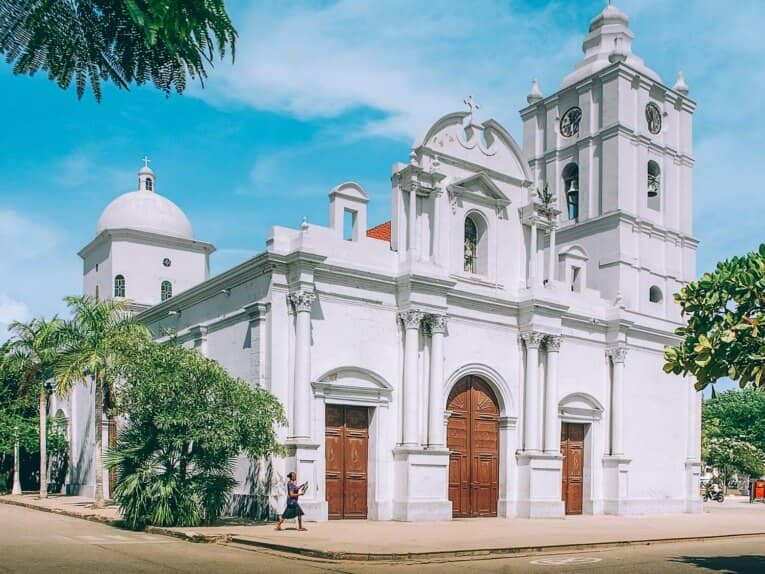
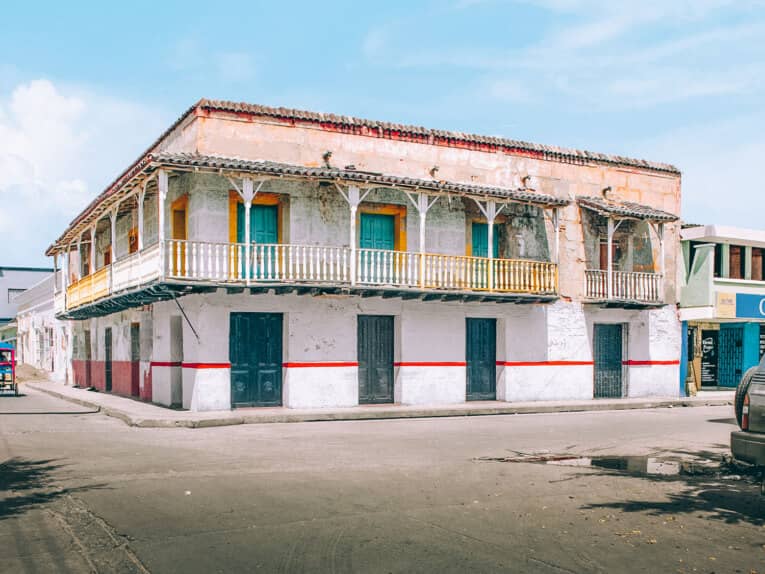
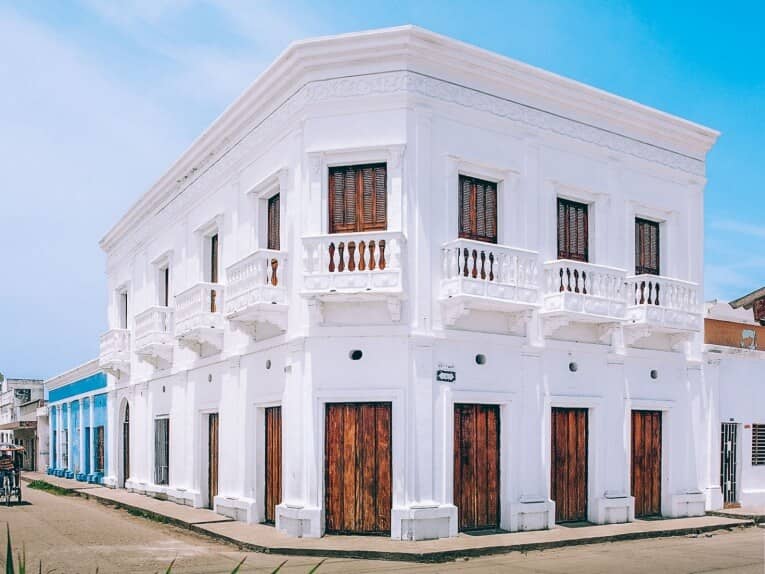
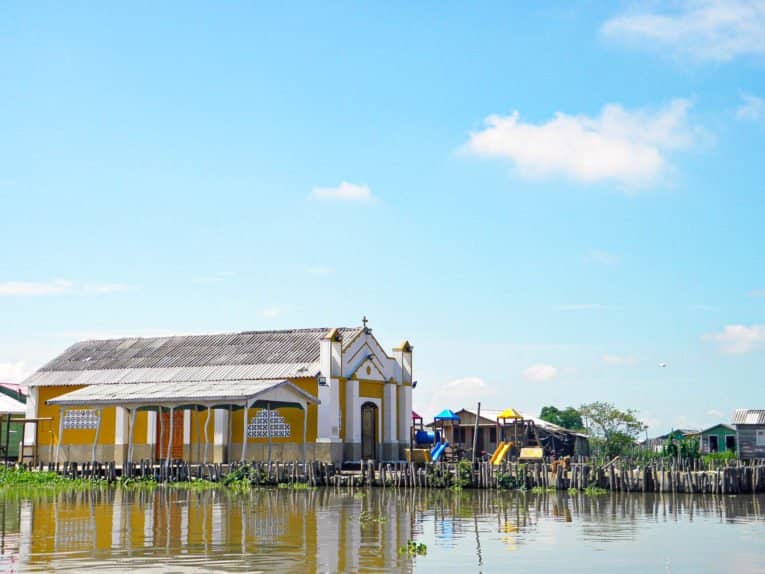

Around Cienaga
- El Volcán: located in the corregimiento of Córdoba, its thermal waters are medicinal, with therapeutic properties.
- Ciénaga Grande de Santa Marta: Colombia’s largest lagoon, declared a natural biosphere reserve by UNESCO in 2000. Discover endemic species and villages on stilts.
Cienaga
General information
- Founded: 1521
- Population: 129.000
- Altitude: 3m
- People: Cienaguero
- County: Magdalena
How to get to Cienaga
- Nearest airport: Santa Marta
- By bus from Santa Marta: about 45 min. and $5.000
Our recommendations for accommodation in Cienaga
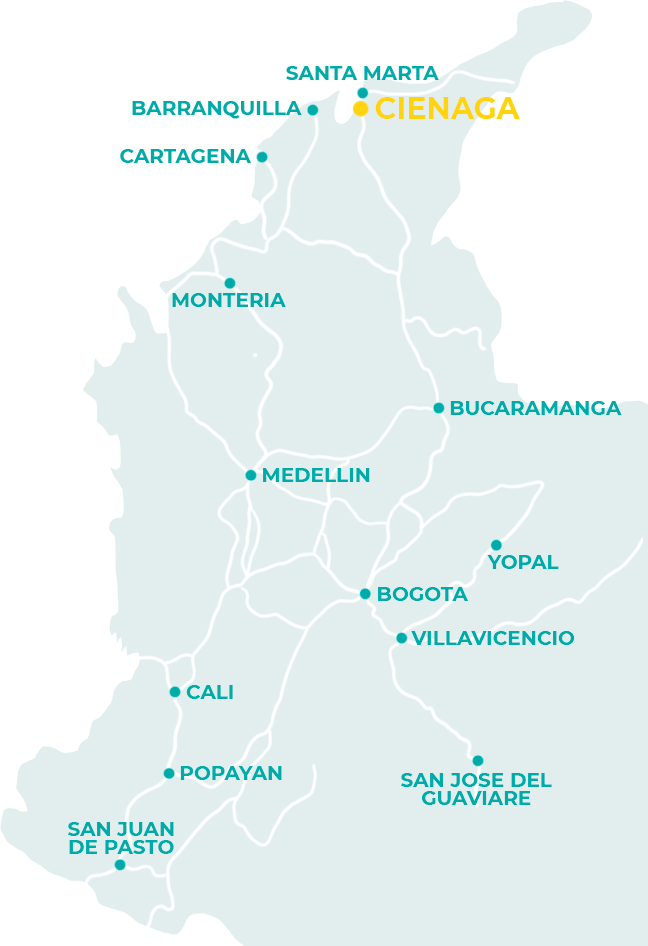
Lorica, Cordoba
Heritage towns of Colombia
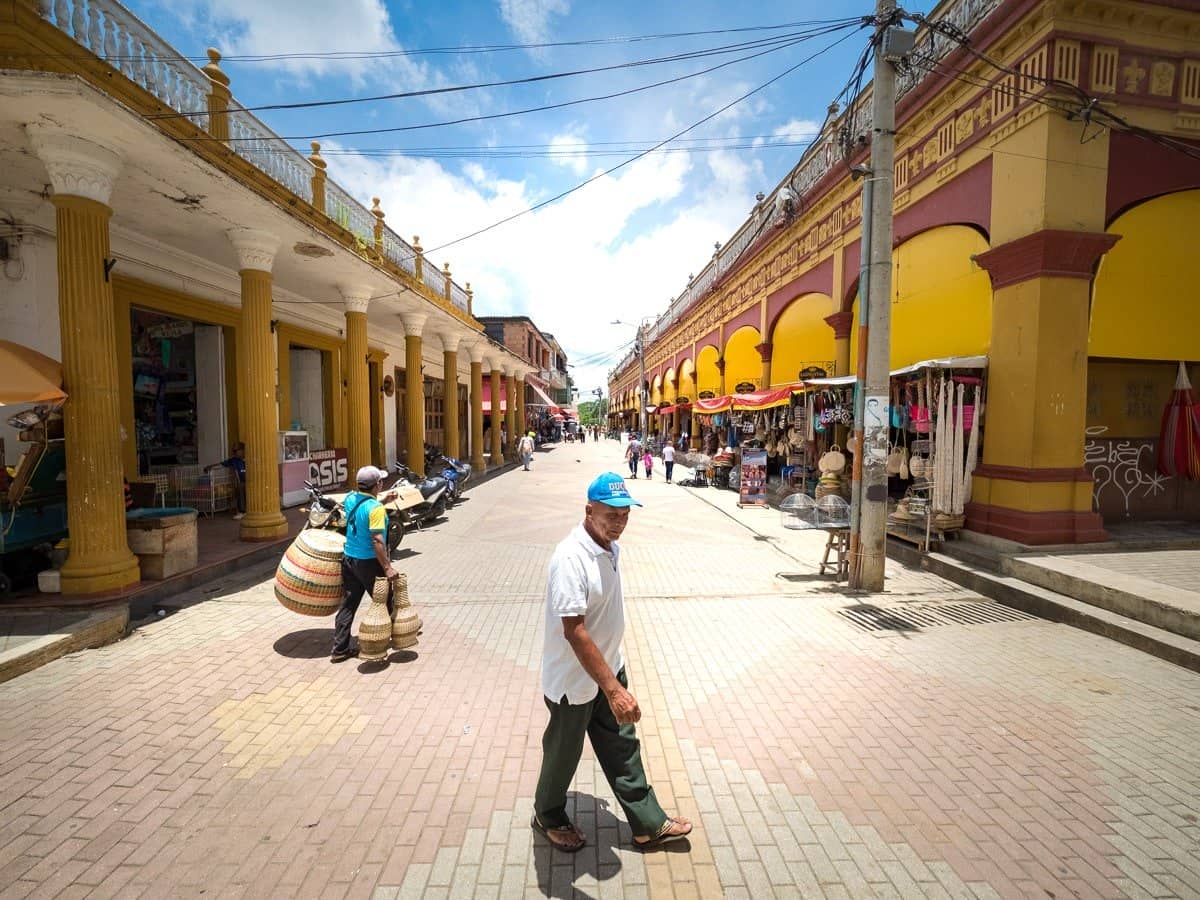
Santa Cruz de Lorica was one of our great discoveries, in a little-known region seldom visited by foreign travellers. Located north of Monteria, in the department of Cordoba, Lorica has an illustrious past as a regional economic capital, the “traces” of which are still visible on the walls of the historic center.
Once you’ve got past the rush of entering the town, you’ll be fascinated by the beauty of the colorful buildings and the sublime covered market on the banks of the Sinu river. An architectural style mixing “republican”, “vernacular” and “mudejar” (Arabo-Andalusian), testifying to the rich cultural heritage, notably of Syrian-Lebanese immigrants!
During our visit to Lorica, we met some very nice people, and we recommend that you drop by the tourist office and ask if someone can show you around the center.
A must: eat a fish envuelto under the arcades of the market!
Lorica points of interest
- Plaza del Mercado: a building declared a national monument, where you’ll find stalls selling food, handicrafts, typical foods, condiments and spices.
- Plaza Pastelillo: surrounded by commercial premises and some of the city’s most important buildings, such as the market square and the Afife Matuk building.
- Afife Matuk building: built in the early 20th century, this was Lorica’s first shopping center.
- Edificio González: home to the town hall, famous for its sculpted balconies and decorative mural frieze.
- La Isla building: built in 1919, so named because it has four identical facades on 4 different streets.
- La Muralla Malecón mural : a walk along the banks of the Sinu River, with a huge mural depicting the city’s history.
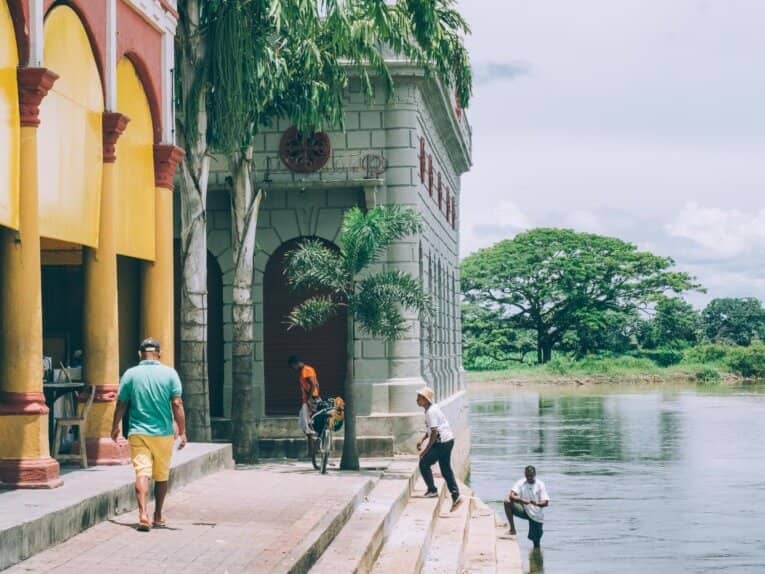
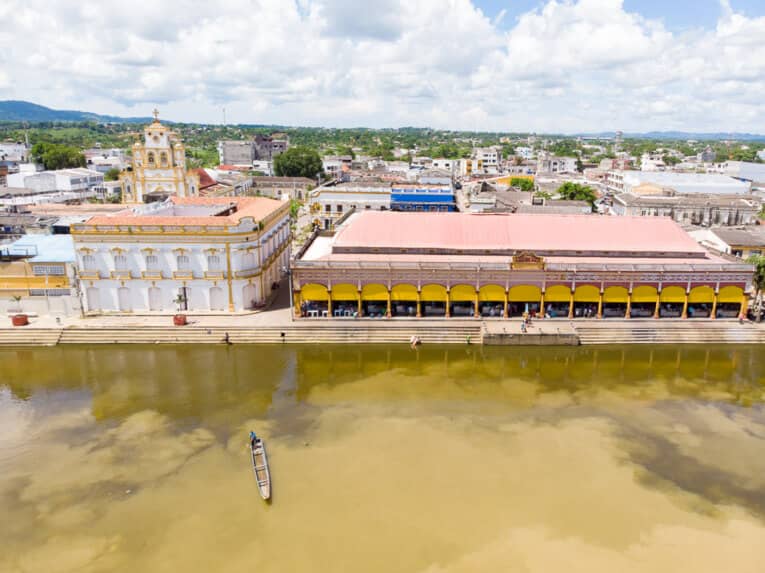
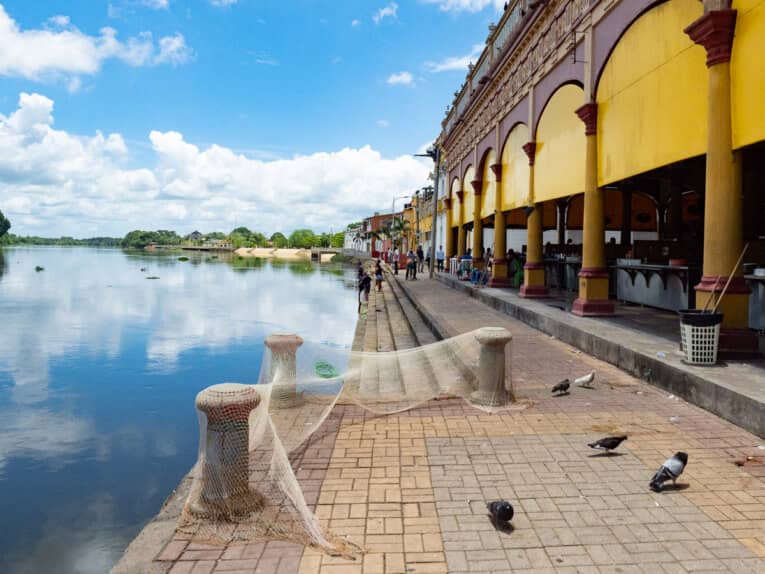
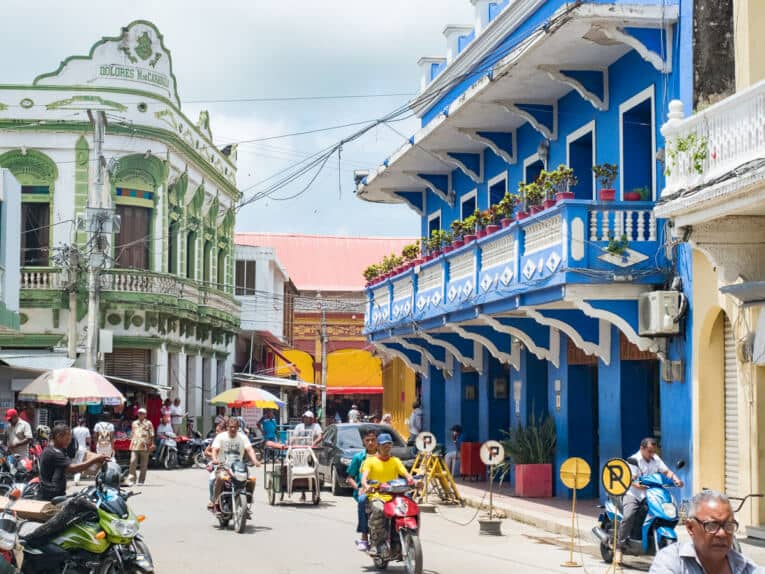

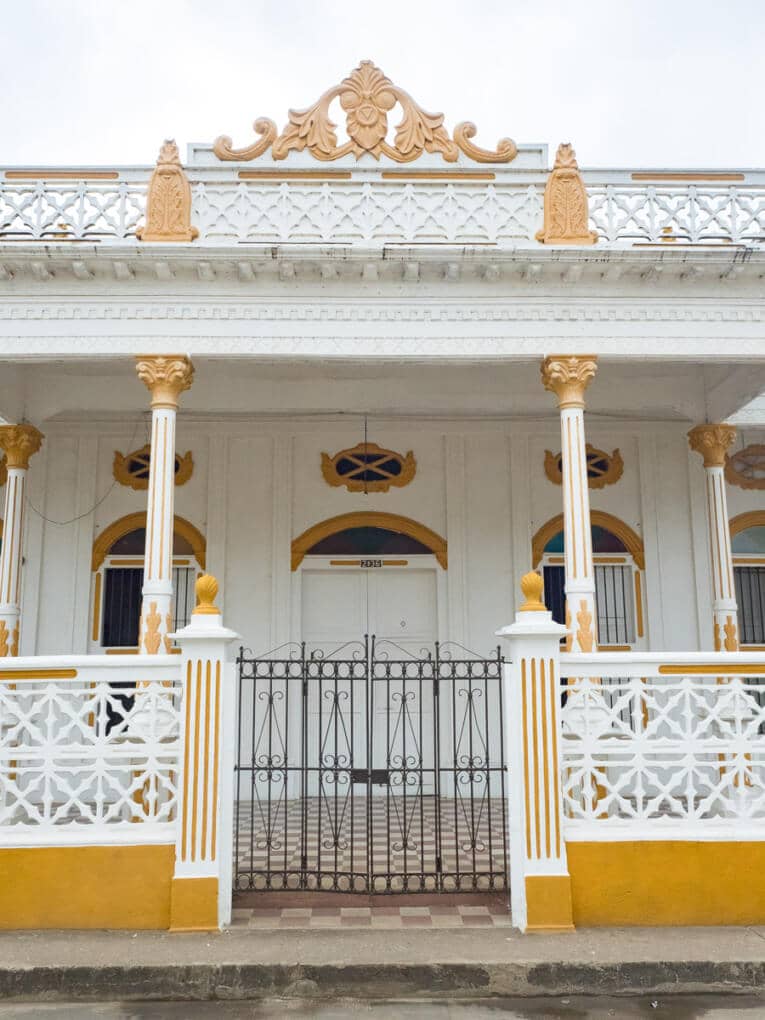
Around Lorica
- Ciénaga de La Caimanera
- Ciénaga de La Leche
- Reserva Natural Sanguaré
- Isla fuerte
- Rincon del Mar
- Coveñas
- Tintinpan and Isla Mucura
Lorica
General info
- Founded: 1740
- Population: 115.000
- Altitude: 7m
- People: Loriquero
- County: Cordoba
How to get to Cienaga
- Nearest airport: Monteria
- By bus from Monteria: about 1h30 and $10.000
Our recommendations for accommodation in Cienaga

Santa Fe de Antioquia, Antioquia
Heritage villages of Colombia
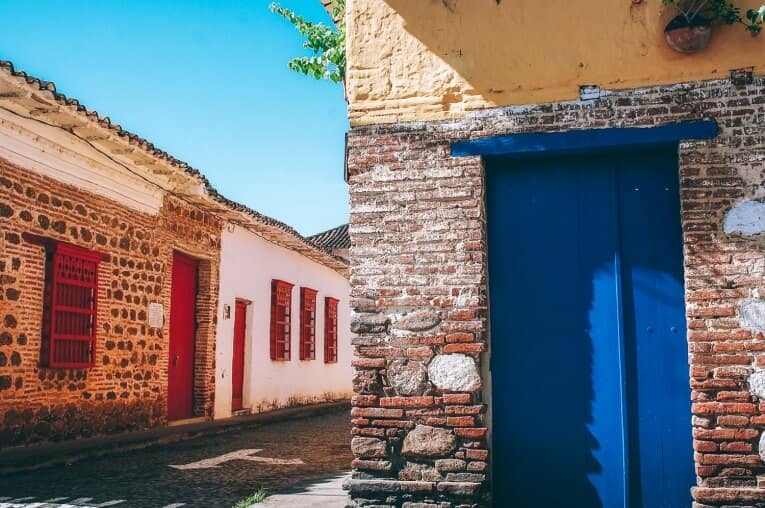
Located about 1h30 from Medellín, Santa Fé de Antioquia is considered one of Antioquia’s most beautiful colonial villages.
Santa Fé de Antioquia is considered the first foundation in the department of Antioquia, the one where it all began, the one where the distinctive identity of the “paisa” culture was created. It is one of the oldest cities, founded in 1541, and was for a long time the department’s capital.
Its superbly preserved architecture is typical of the colonial era, with beautiful houses and cobbled streets. Don’t miss the village’s beautiful squares: Plaza Mayor Simón Bolívar, of course, but also Santa Bárbara, Plazuela de Mi Padre Jesús, Plazuela José María Martínez Pardo..
The Puente de Occidente, a bridge that symbolizes Santa Fe de Antioquia, is one of the city’s landmarks. Of course, there’s also the Fruit, Sweets, Crafts and Traditional Foods Market.
To discover all the secrets and more, we really recommend that you contact Cathy via our form below, our local partner who offers a great guided tour of Santa Fe de Antioquia.
GUIDED TOUR OF SANTA FE DE ANTIQUIA IN english
Points of interest Santa Fe de Antioquia
- Plaza Mayor Simón Bolívar: the main square, home to various monuments including the Basilica of the Immaculate Conception
- Temple de Santa Barbara : built in 1728, this Baroque-style temple is the oldest in the city.
- Puente de Occidente: this 291-meter-long bridge across the Cauca River is the symbol of Santa Fé.
- Casa Negra: 17th-century colonial-style mansion
- Jewelry and filigree: an entire craft tradition introduced by the Spaniards, who themselves had learned from the Arabs.



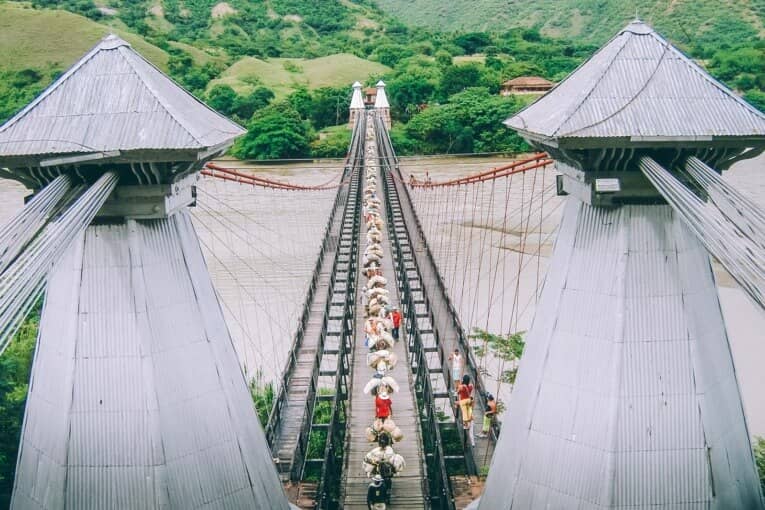
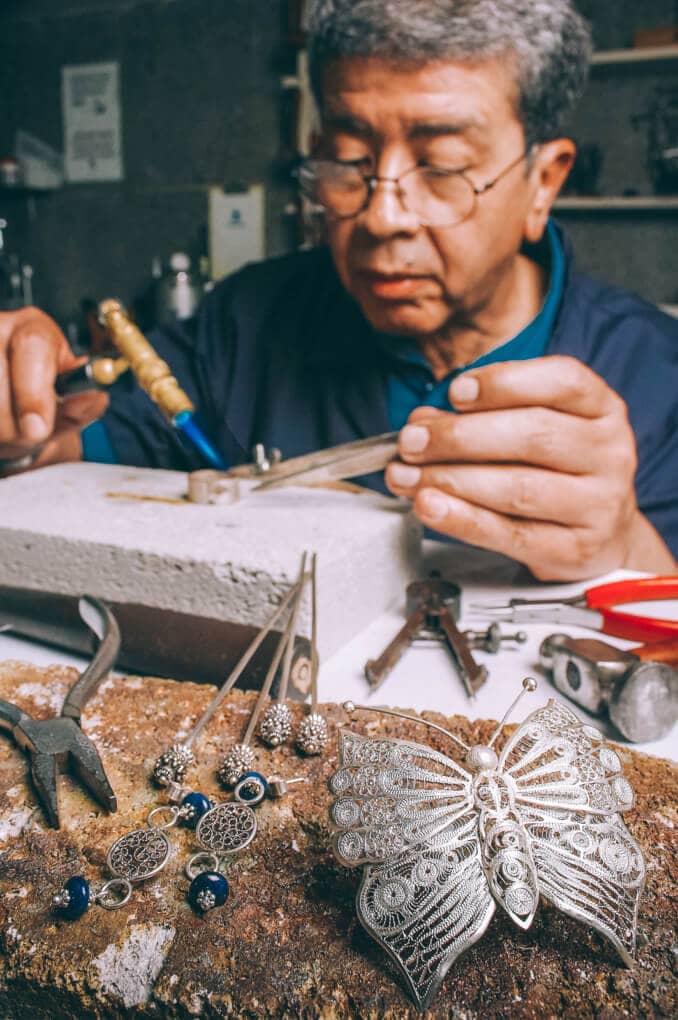
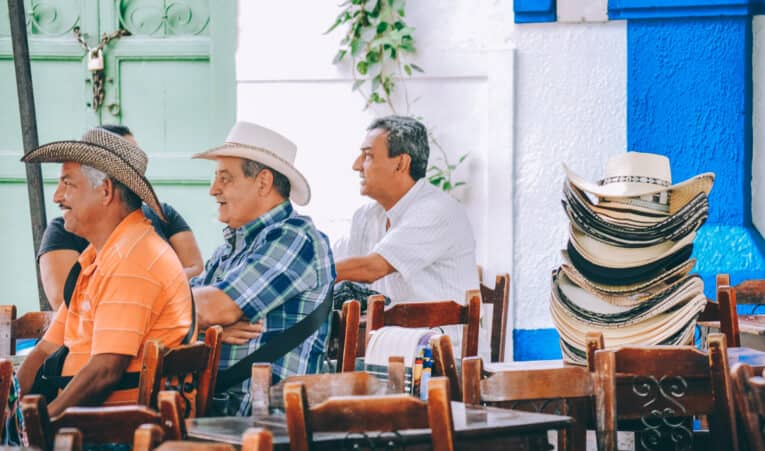
Around Santa Fe de Antioquia
- Hacienda Juan Blanco: located in the village of El Espinal, this colonial-style residence has belonged to a number of illustrious figures
- Paramo de Belmira: a nature reserve where you can observe the Paramo ecosystem around Medellín
Santa Fe de Antioquia
General information
- Founded: 1541
- Population: 26.000
- Altitude: 500m
- People: Santafereño
- Department: Antioquia Antioquia
How to get to Santa Fe de Antioquia
- Nearest airport: Medellin
- By bus from Medellin: about 1h30 and $10.000
Our recommendations for accommodation in Santa Fe de Antioquia

Jerico, Antioquia
Heritage villages of Colombia
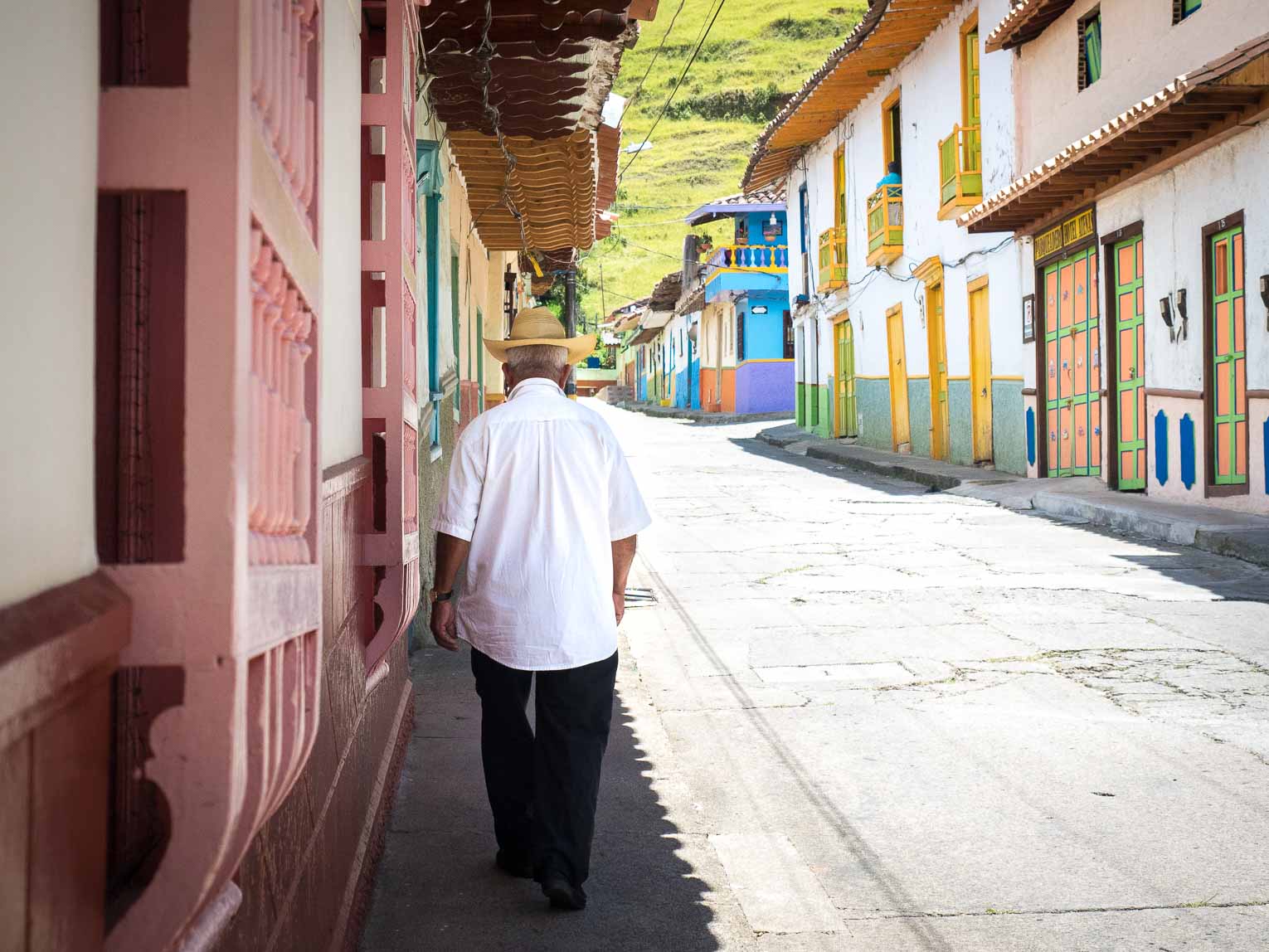
Here’s another one of our favorites! The village of Jerico is a marvel of cafetero architecture. Jerico is a veritable explosion of color, with all its houses featuring colorful doors and balconies.
We only stayed there for 2 nights, but we’d have liked to stay for life! Jerico is difficult enough to access to retain its authenticity, far removed from mass tourism. Here, life flows quietly around local activities, markets, cafés and crafts. There’s a tradition of making Carriel, the traditional paisa bag, and we recommend a visit to the workshop of Dario Agudelo, THE village’s master craftsman and an exceptional character.
In Jerico, the idea is simply to enjoy the local atmosphere. But of course, there’s plenty to do: guided tours, discovering the village’s religious history, climbing the various viewpoints to admire the surrounding landscape, strolling through the botanical gardens, visiting a coffee finca…
There are also plenty of mountain walks and even paragliding opportunities.
Here again, if you’d like to find out more and be accompanied on a guided tour of Jerico in english, we suggest you contact our friend Cathy below.
JERICO GUIDED TOUR IN english
Points of interest in Jerico
- Restrepo family home and Castaño-Pelaez family home
- Market Square
- Catedral de Nuestra Señora de Las Mercedes : with its distinctive colors
- Calle “100 escalas” with its lanterns and balconies jutting out over the edges.
- Morro El Salvador: a small hill from which you can admire a beautiful view of Jerico and the surrounding area
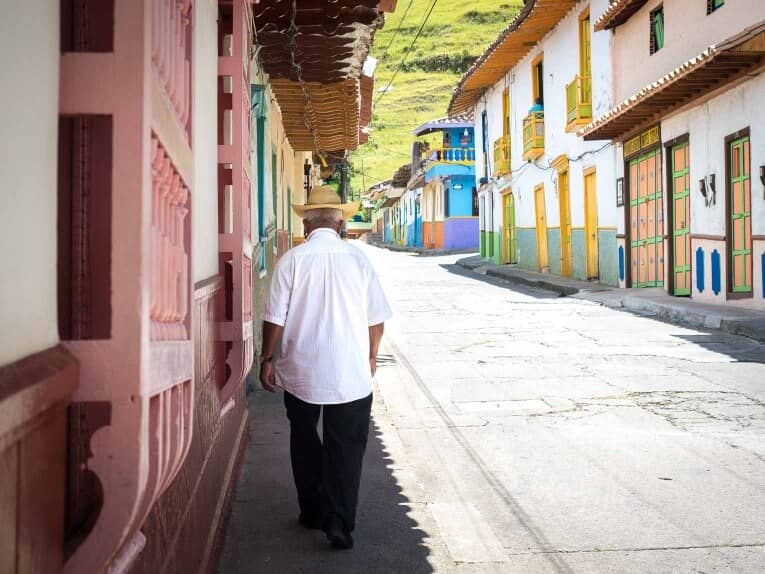
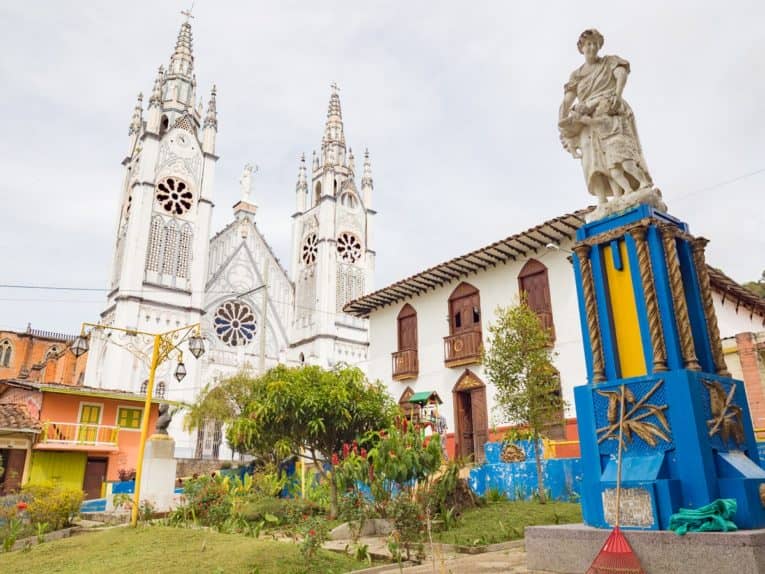
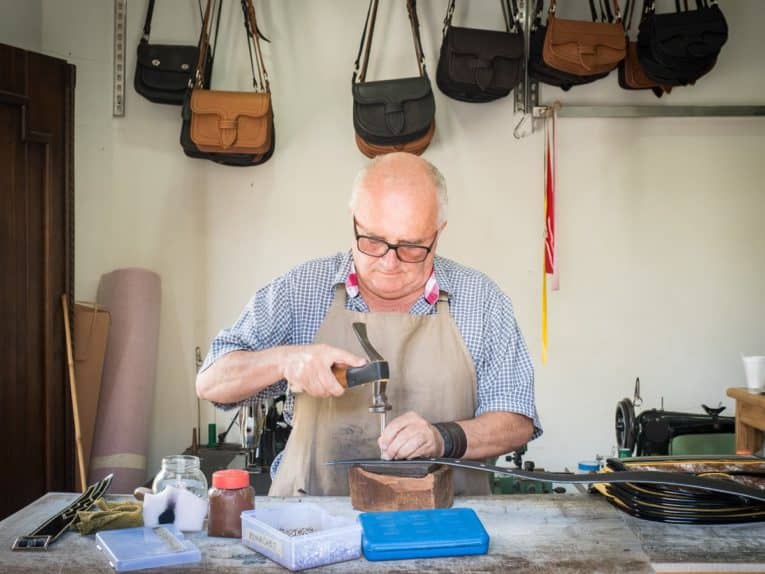
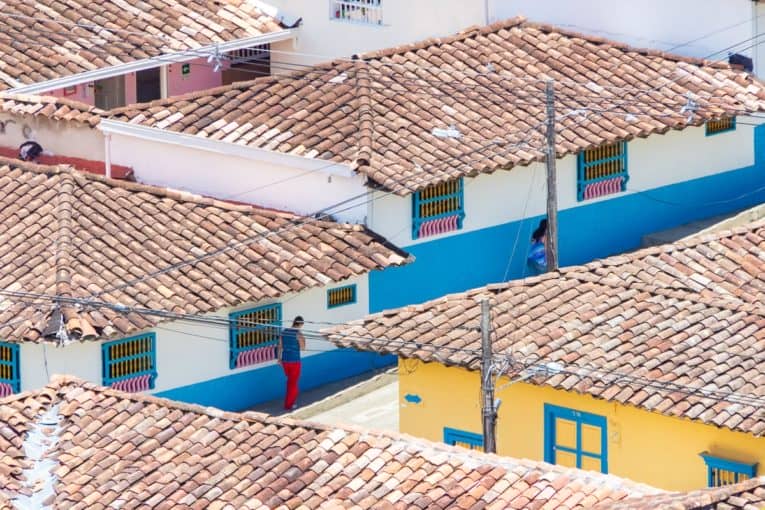

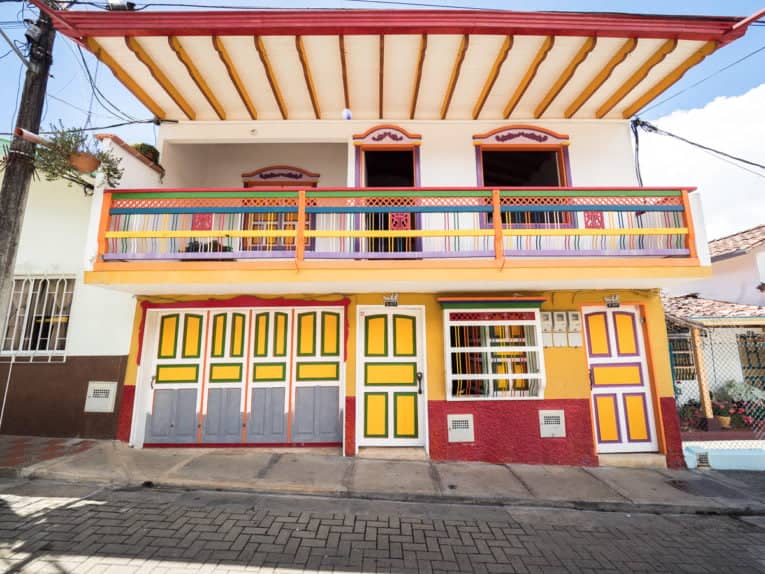
Near Jerico
- Ecoparque de Las Nubes : nature walk surrounded by forest and a wide variety of birds.
- Vereda La Soledad : trail through coffee and banana plantations to a viewpoint overlooking the Cauca River.
- Rio Piedras: a river where you can swim
Jerico
General information
- Founded: 1850
- Population: 13.640
- Altitude: 1910m
- People: Jericoano
- Department : Antioquia
How to get to Jerico
- Nearest airport: Medellin
- By bus from Medellin: about 3h30 and $18.000
Our recommendations for accommodation in Jerico
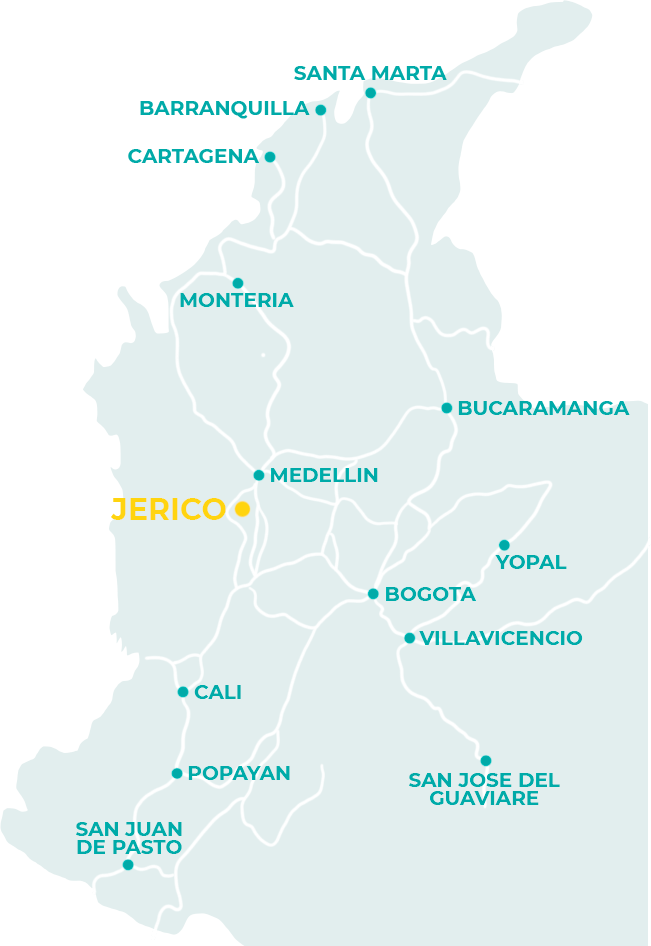
Garden, Antioquia
Heritage villages of Colombia
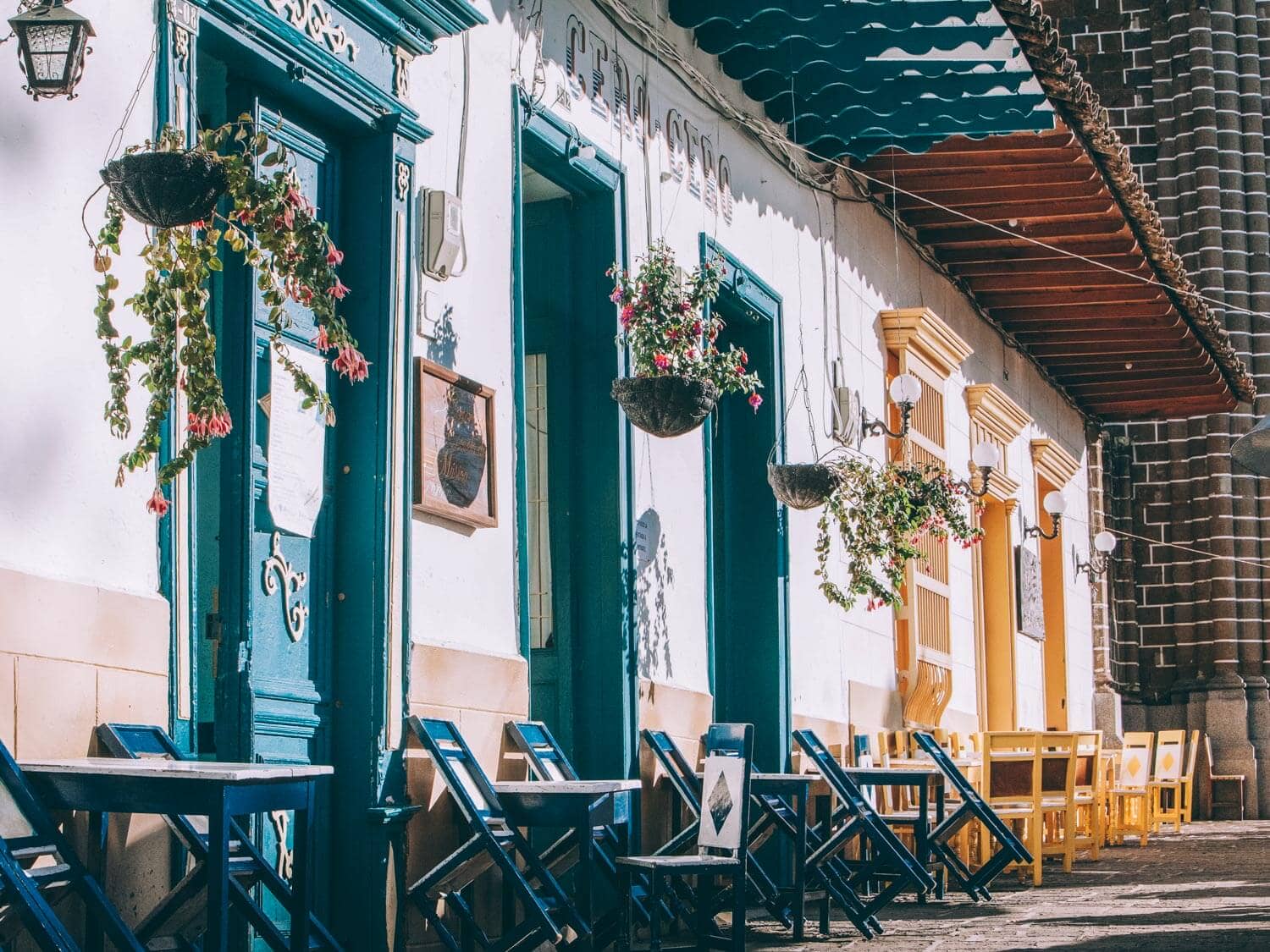
El Jardín is a municipality in the southwest of Medellín, located in a valley from which the Farallones del Citará can be seen on the border with the department of Chocó.
Its economy is based on agriculture and trout farming and, in recent years, tourism. Indeed, Jardin has enjoyed a boom in tourism in recent years, no doubt due to its repeated presence in numerous guidebooks. After all, we’re far from mass tourism.
There’s a lovely cafetera village atmosphere in Jardin, with traditional architecture and colorful houses around the main square, where you can enjoy a coffee while watching daily life.
Local craft traditions include patchwork plaids and colorful wooden and leather stools, which can be found in cafés and bars.
GUIDED GARDEN TOUR IN english
Garden points of interest
- Parc El Libertador: the main square with its magnificent trees and terraces, a meeting place for the people of Jardin.
- Basilica de la Immaculada Concepción: inaugurated in 1932, thisminor basilica was built of volcanic stone hewn by the peasants of the time.
Around Jardin
- Cascada del Amor : walk to a waterfall where you can observe birds.
- La garrucha : a traditional means of transport consisting of a wooden basket moved by cable
- Numerous guidedhikes are available in the area
- Paragliding
- Reserva del Loro Orejiamarillo, Alto de Ventanas
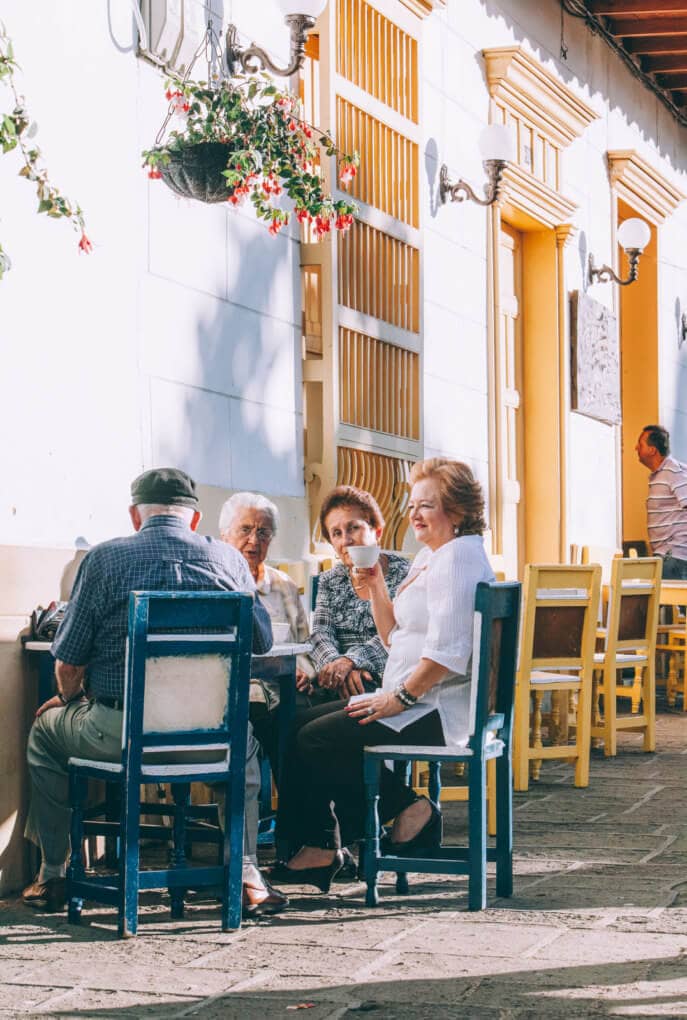
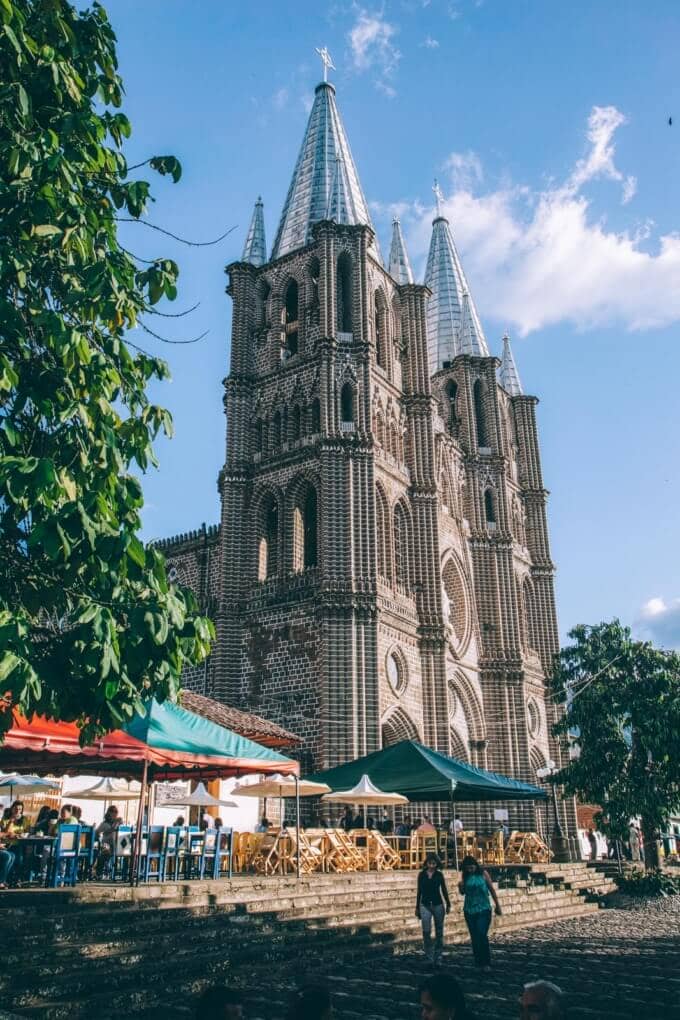
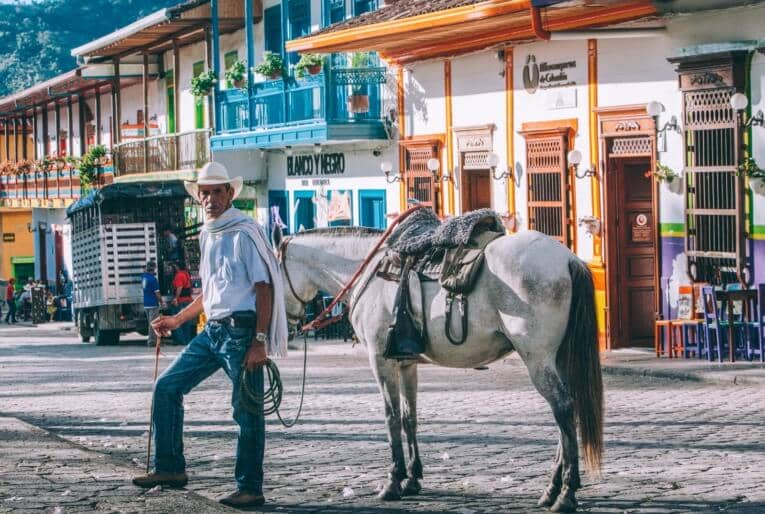
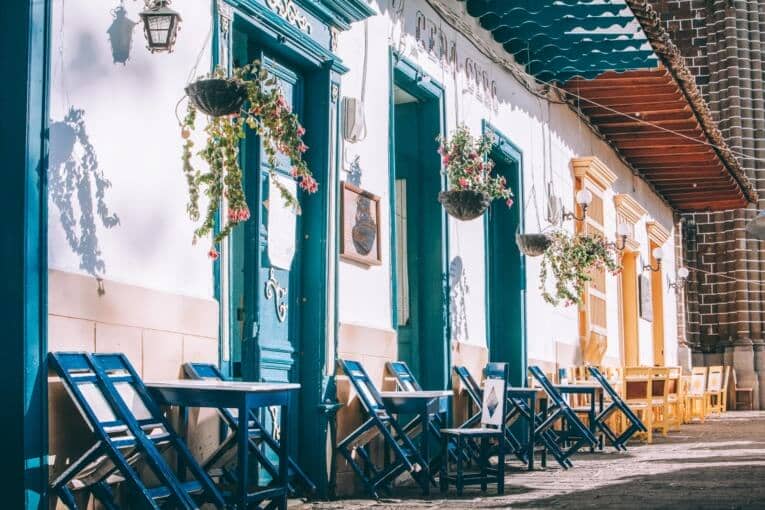
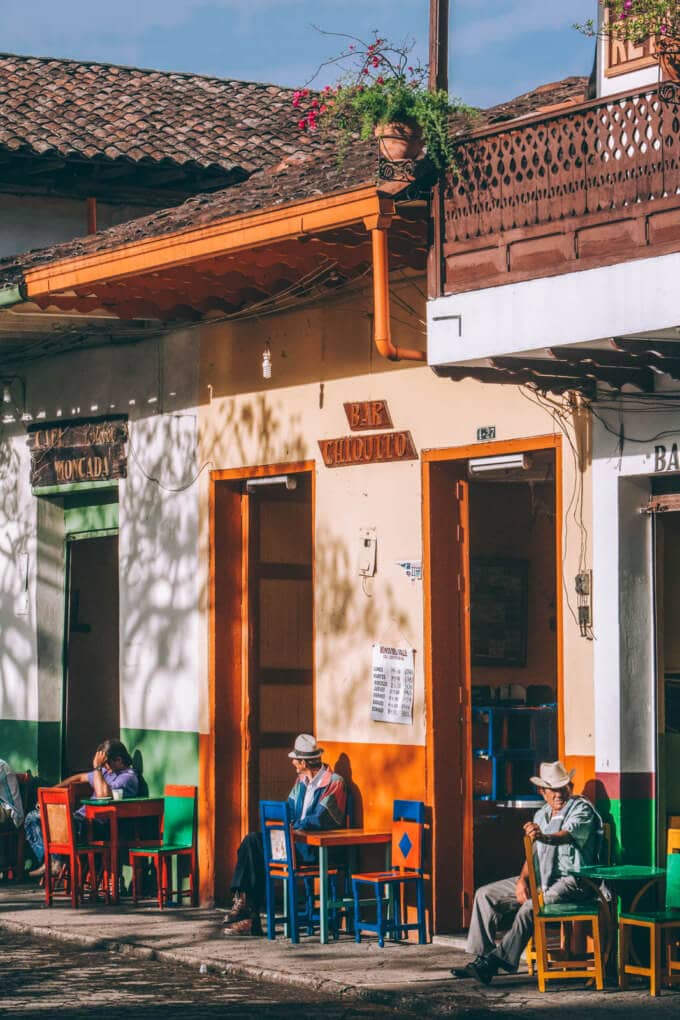
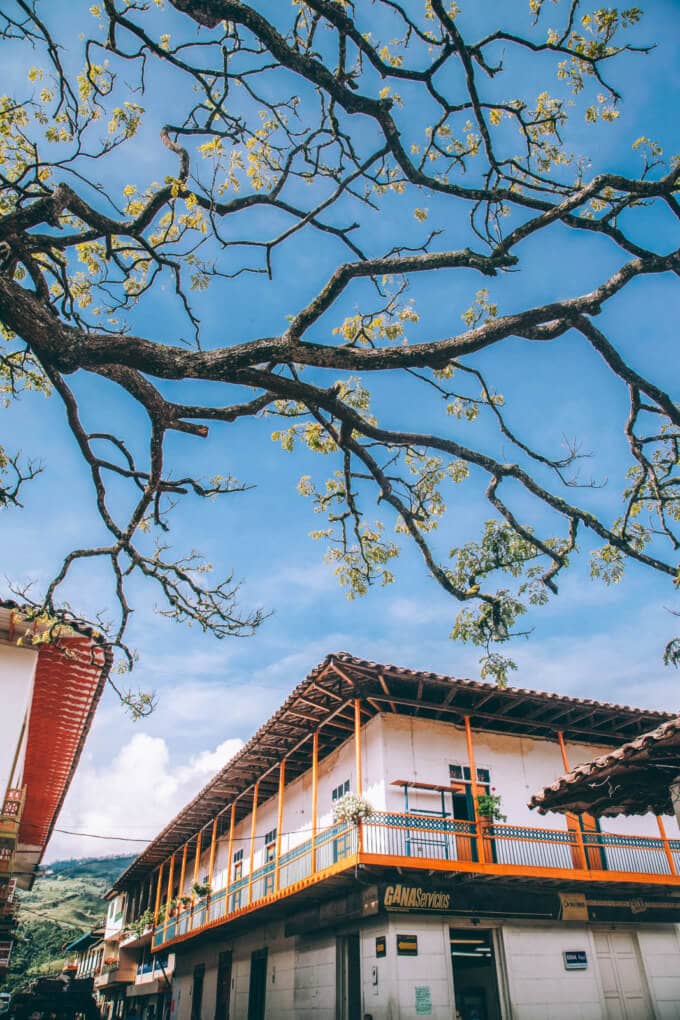
Garden
General info
- Founded: 1864
- Population: 14.518
- Altitude: 1750m
- People: Jardineño
- Department : Antioquia
How to get to Jardin
- Nearest airport: Medellin
- By bus from Medellin: about 4 hours and $25.000
Our recommendations for accommodation in Jardin
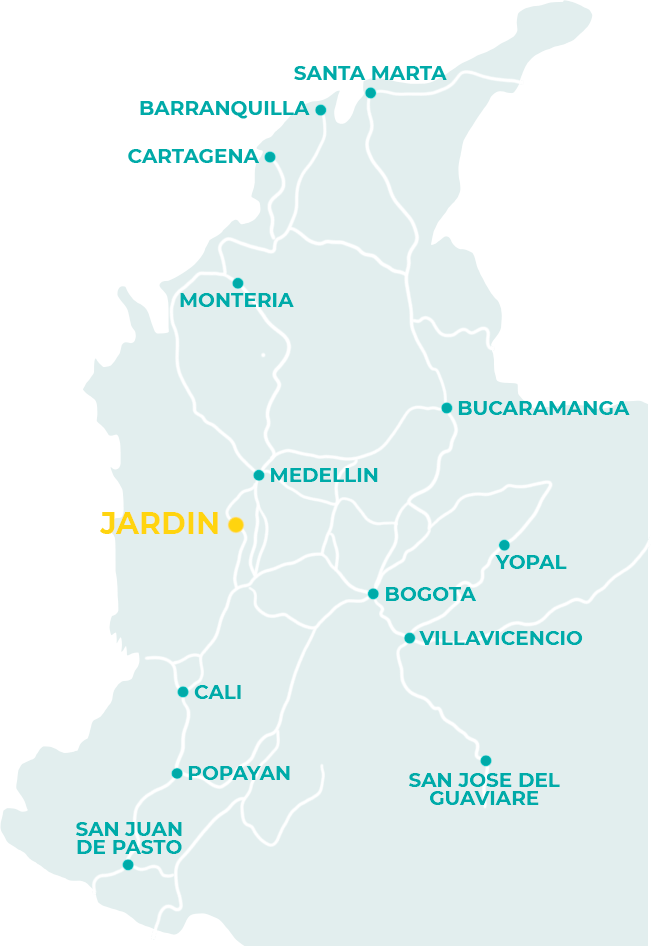
Aguadas, Caldas
Heritage villages of Colombia
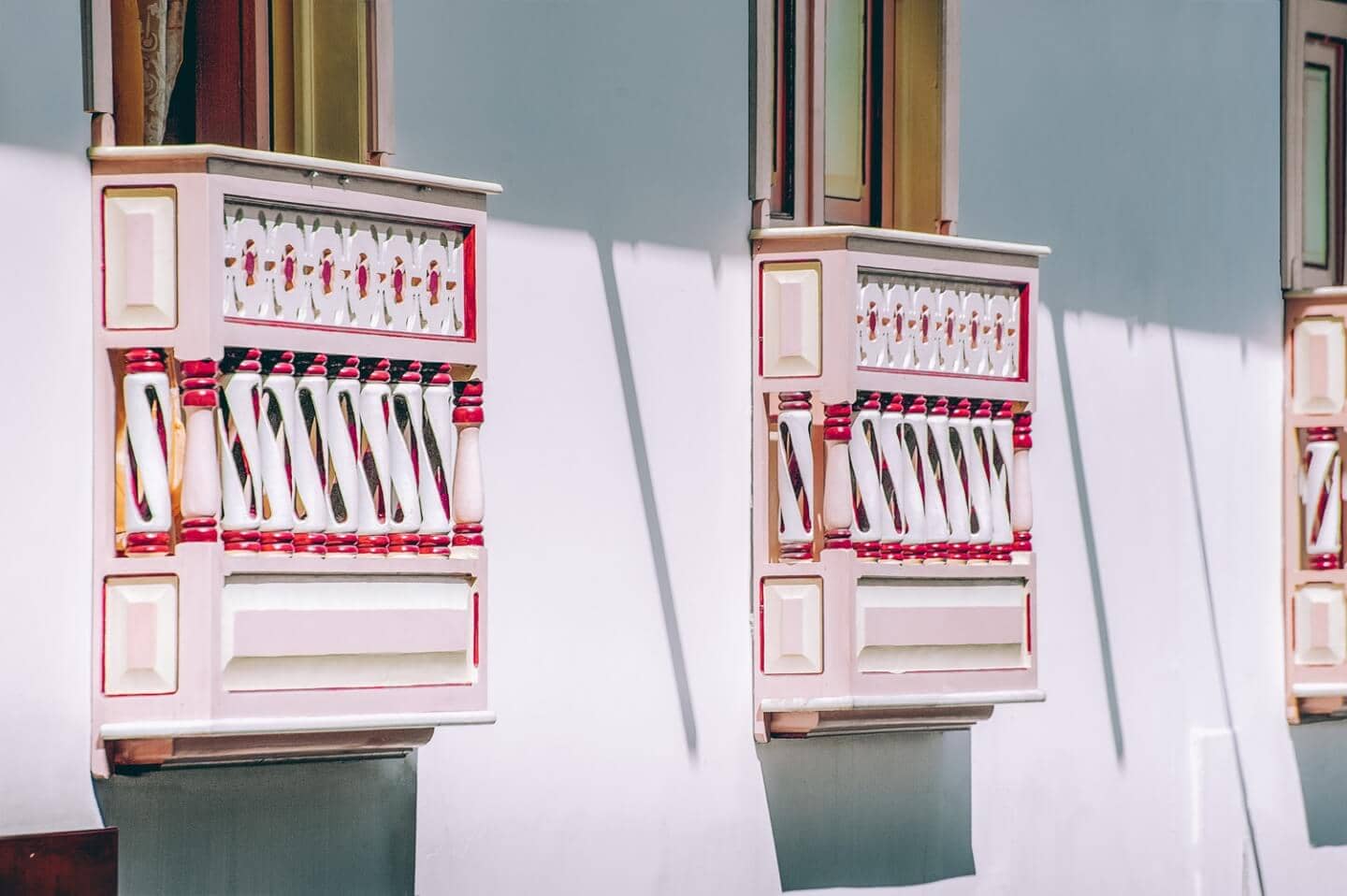
Located halfway between Manizales and Medellín, Aguadas is a village that forms part of the coffee cultural landscape, declared a UNESCO World Heritage Site. The village boasts a wealth of culture, history, architecture and craftsmanship: it’s the capital of hats!
The aguadeño hat, renowned for 160 years for its quality and weave, is handmade from iraca, a fiber extracted from the Toquilla palm tree. Another local specialty is Pionono, a traditional regional confectionery.
Like Salamina, Aguadas’ geographical location, a little way from the most popular tourist spots, is probably what keeps it away from mass tourism.
Aguadas is a village with colorful houses and a beautiful church in fresh, tangy colors. It may not be the most beautiful village in the coffee-growing region, but it has the typical atmosphere of the region, and you can feel that not everything in the village is geared towards tourism.
GUIDED TOUR OF AGUADAS IN english
Points of interest in Aguadas
- Casa de la Cultura “Francisco Giraldo”: National Hat Museum, unique in the country, where you can see over 300 handmade hats from different Colombian regions.
- Pueblito Viejo: a picturesque replica of the houses built when the village was founded. Located at the top of the Alto de la Virgen, it offers a panoramic view of Aguadas.
- Templo de la Inmaculada Concepción : the emblematic temple of Aguadas.
- Parque de Bolivar: Aguadas’ central square, where you can enjoy village life.
In the vicinity of Aguadas
- Playa del rio Arma: local bathing spot where you can enjoy the “paseo de olla”, a Colombian tradition of eating (literally) at the water’s edge.
- Cascadas de Pore (80 m) and La Chorrera (50 m ): located in a nature reserve, where you can enjoy beautiful walks.
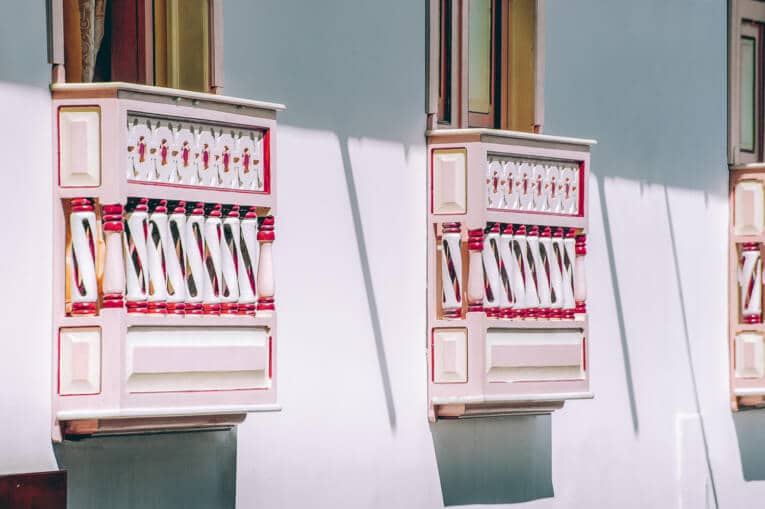

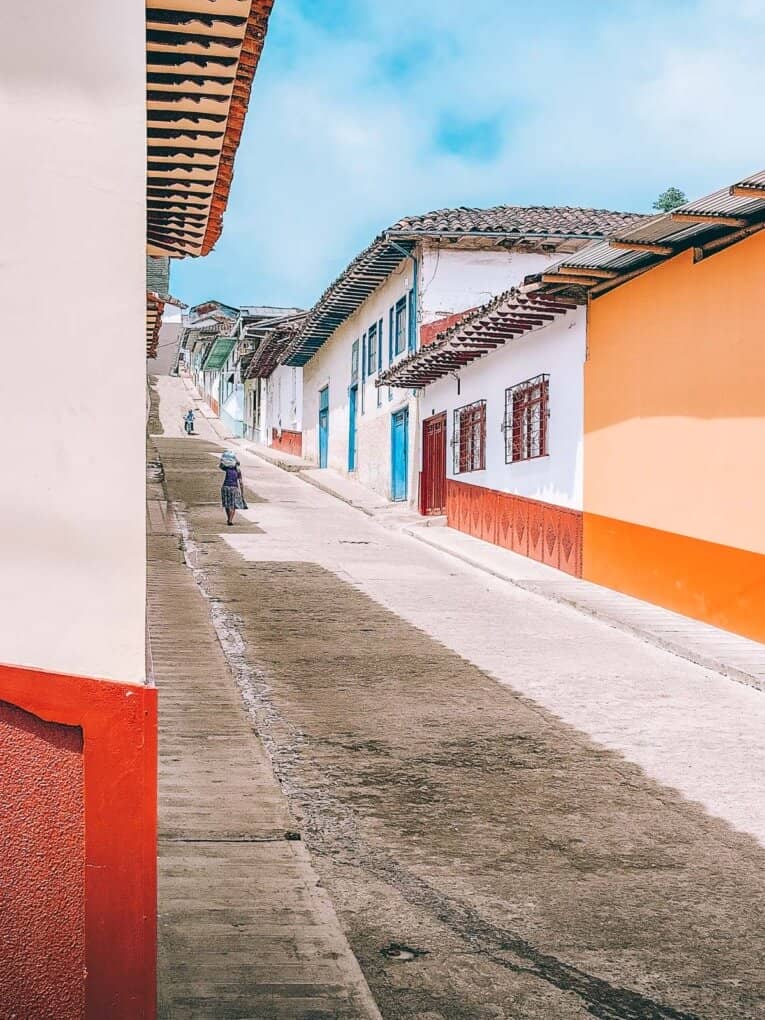
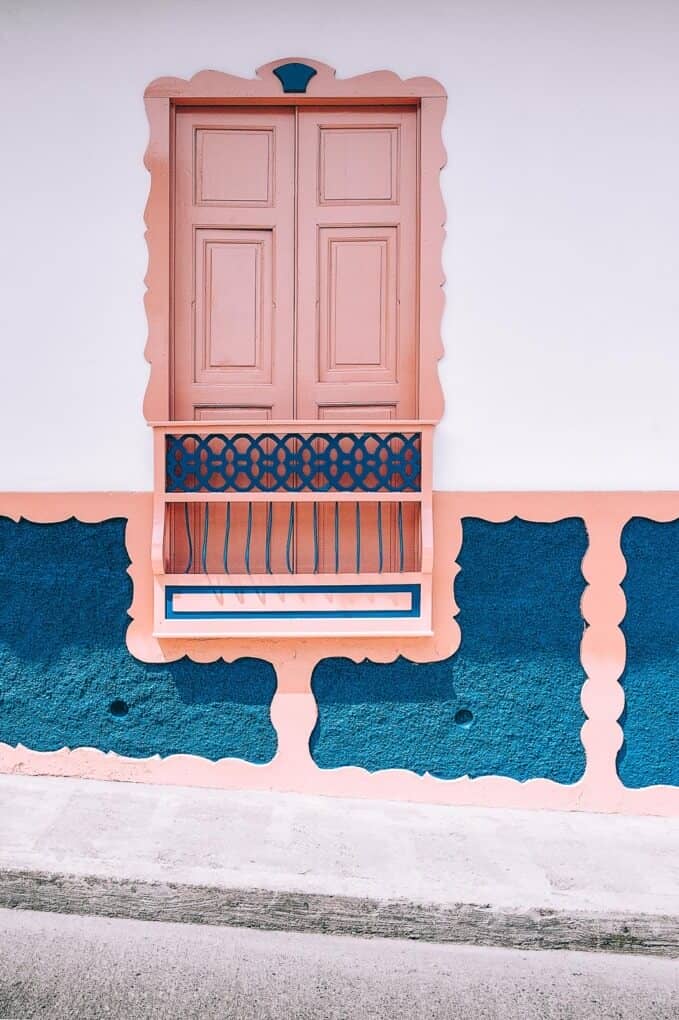
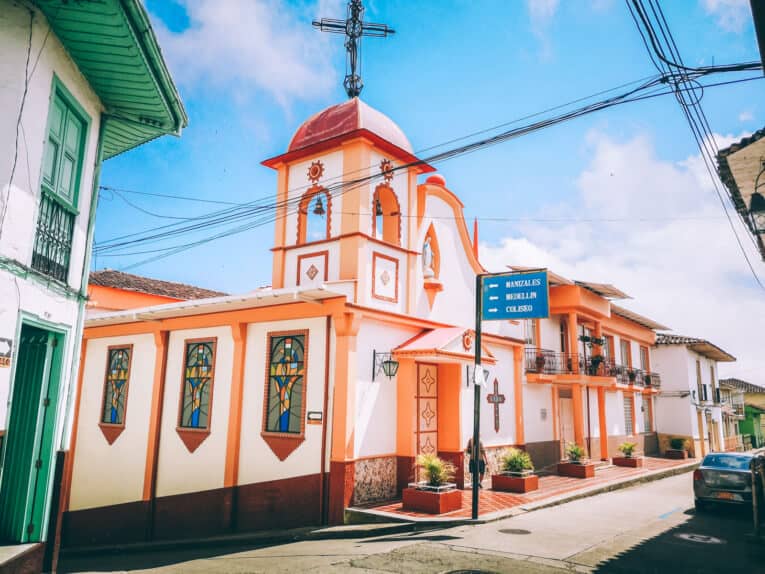
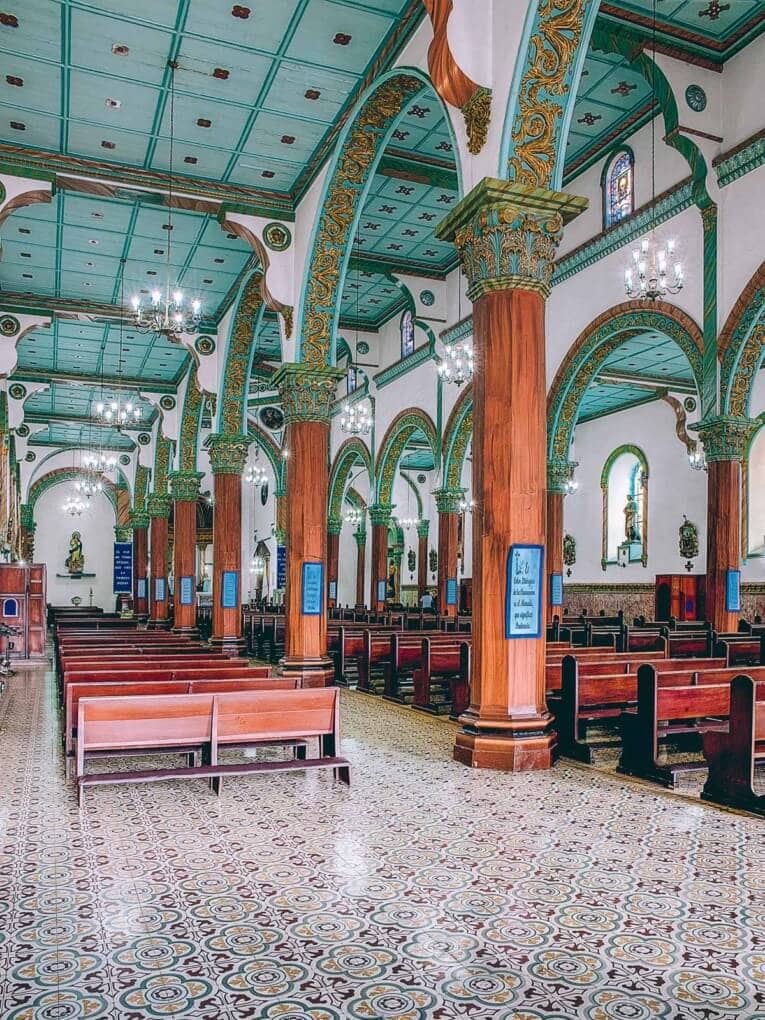
Aguadas
General info
- Founded: 1808
- Population: 22.081
- Altitude: 2214m
- People: Aguadeño
- County: Caldas
How to get to Aguadas
- Nearest airport: Medellin or Manizales
- By bus from Medellin: about 4 hours and $40.000
Our recommendations for accommodation in Aguadas

Salamina, Caldas
Colombia’s heritage towns
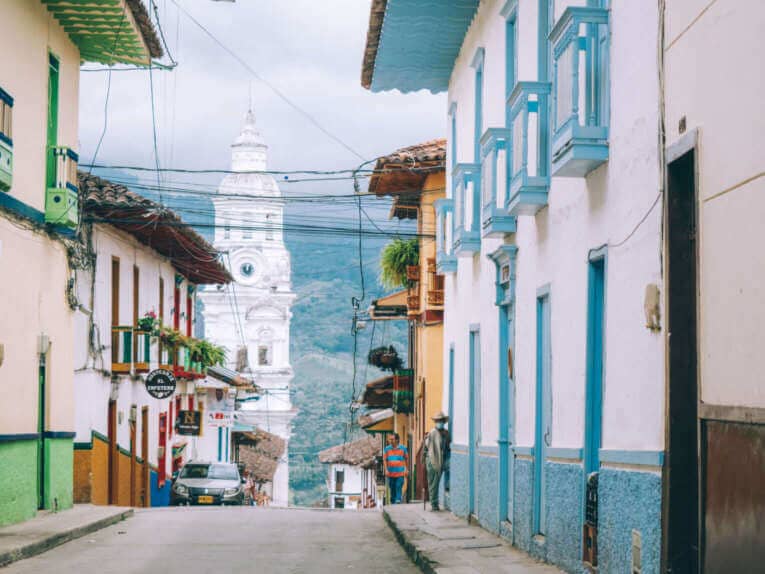
Salamina is probably the most underrated village on our list – nobody knows about it, yet it’s one of the most beautiful villages in the coffee region, if not THE most beautiful!
Like Aguadas, its geographical location protects it from mass tourism, and yet… in addition to the sublime historic center with its colorful houses and sculpted balconies, the region is home to a hidden treasure: the Samaria Valley, a forest of wax palms that has nothing to envy the Cocora Valley!
Salamina, known as “the city of parks”, is renowned for its well-preserved architectural heritage. It boasts some of the finest sculpted doors and balconies in the world.
Salamina is located on a mountainside, and the steep terrain offers beautiful panoramic views of the surrounding mountains.
A village that is one of our MUST DO’s on a forthcoming trip to Colombia, a stop to add to any journey between Medellín and Pereira.
It’s possible to organize a short trip from Medellín with Cathy, our highly recommended local partner! See below.
GUIDED TOUR OF SALAMINA IN english
Salamina points of interest
- Parque Bolivar: with its sublime kiosk and all the colorful houses with carved balconies all around, this is the nerve center of the village.
- Basílica Menor de la Inmaculada Concepción : an imposing, all-white church.
- Casa del Degüello: located in the historic center, this 18th-century building is considered one of the town’s most important architectural landmarks.
- La Valvanera cemetery
- Rodrigo Jimenez Mejía House of Culture: for its wood carvings and woodwork
- La ultima lagrima: For the stories the owner of this tienda next to the cemetery has to tell
- The ruanas and carpet weaving workshop just opposite the ultima lagrima.
Around Salamina
- La Samaria : a natural wax palm forest in the village of San Felix, 45 minutes from Salamina.


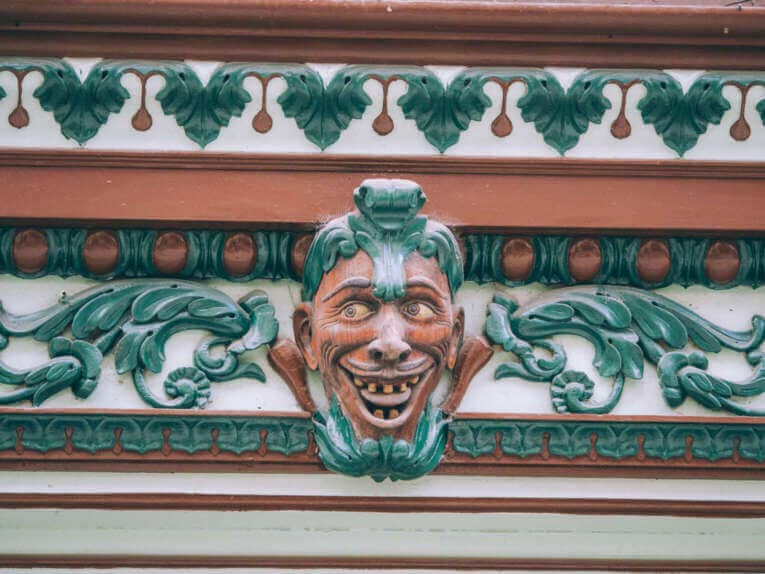

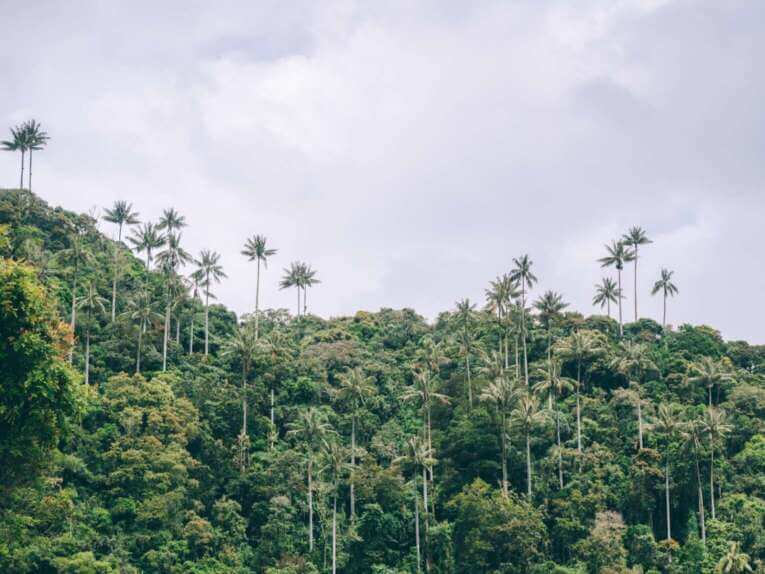
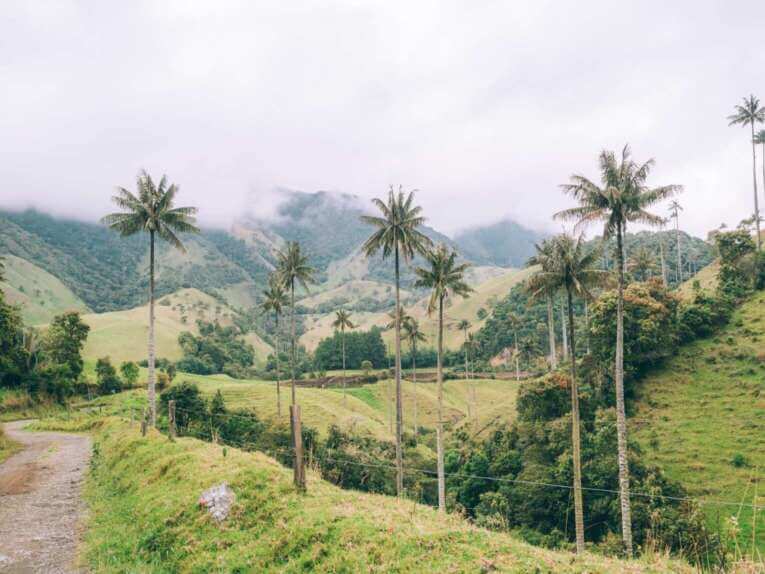
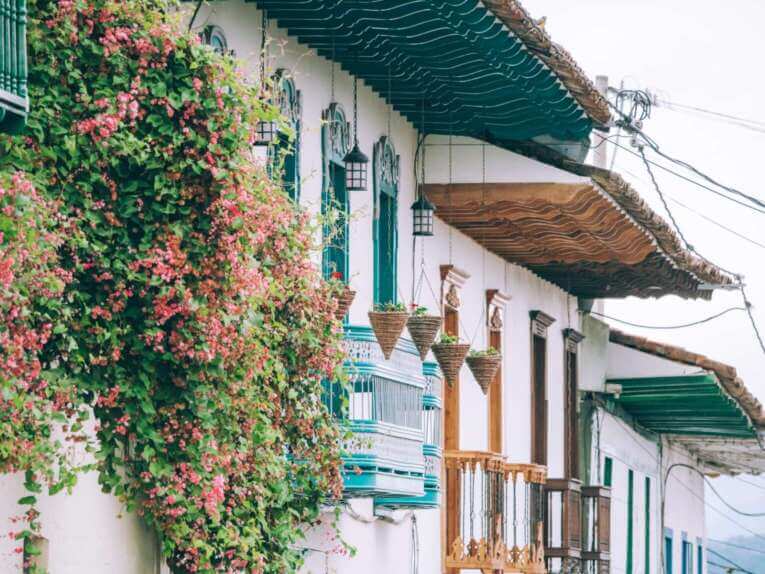
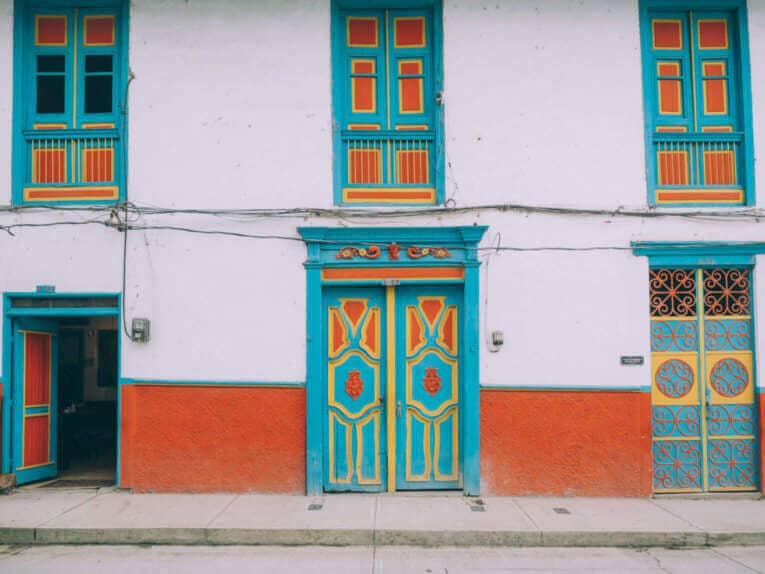
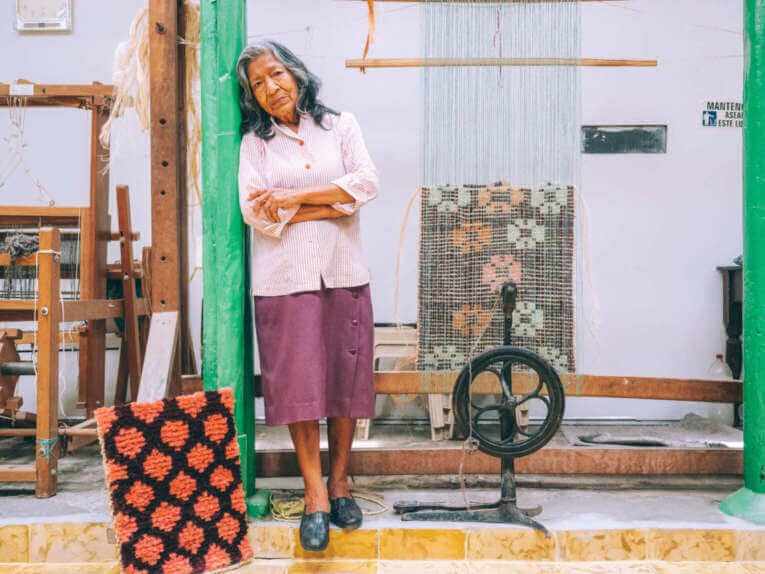
Salamina
General info
- Founded: 1825
- Population: 16.635
- Altitude: 1822m
- People: Salamineño
- County: Caldas
How to get to Salamina
- Nearest airport: Manizales
- By bus from Manizales: about 3 hours and $16.000
Our recommendations for accommodation in Salamina
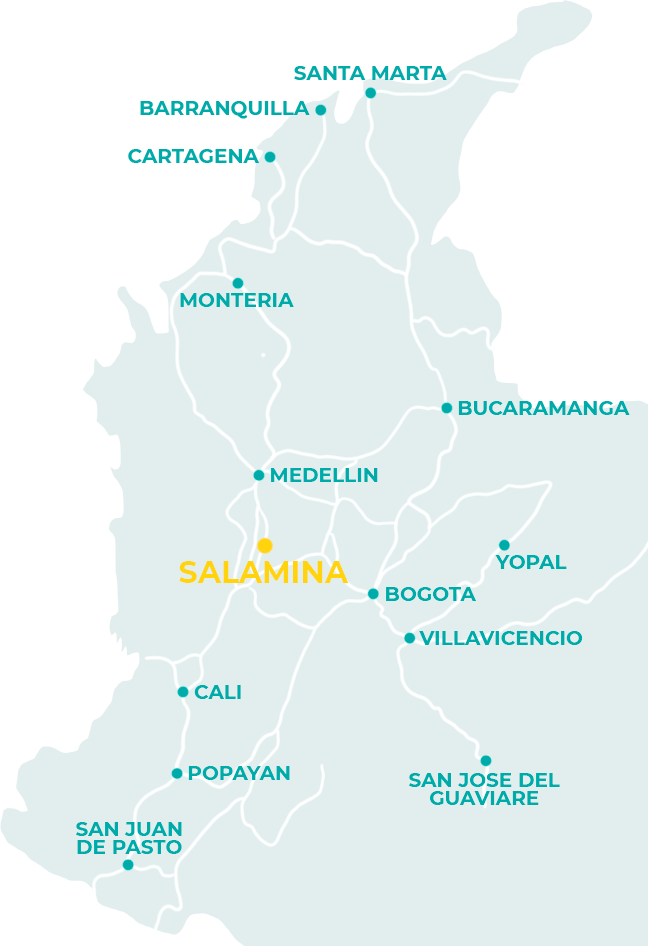
Honda, Tolima
Colombia’s heritage TOwns
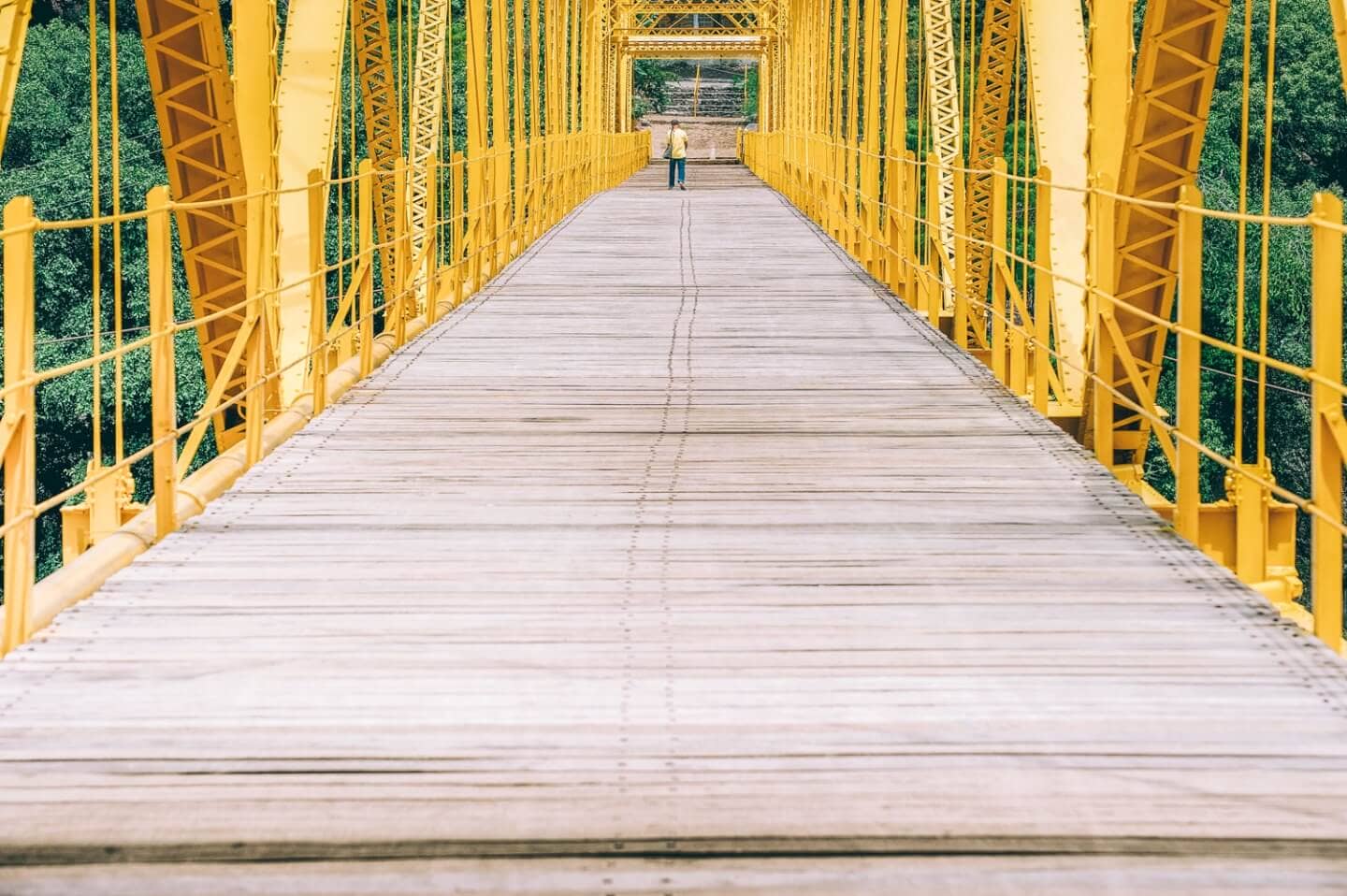
Known as the “city of bridges”, its streets boast over forty bridges crossing the Magdalena, Gualí, Guarinó and Quebrada seca rivers!
A former commercial crossroads, Honda is renowned for its fishing activity, one of the main economic, social and cultural activities that still distinguishes this municipality today, which has benefited from a commercial predominance that has lasted for over three centuries, linking and communicating the whole country.
Honda is slowly becoming aware of the heritage character of its historic center and its architecture. Renovation projects have been multiplying in recent years to restore the value of this colonial heritage.
Honda is a truly off-the-beaten-track destination that you don’t visit by chance. The village could be added as a possible stopover for those making the journey between Bogota and Manizales.
Honda points of interest
- Navarro Bridge: the symbol par excellence of this municipality, this was the first metal-structured bridge built in South America.
- López Bridge : offers a fine view over the city of Honda.
- Market Square: the local market is located in a former convent, a sublime building with green and white colors and 140 columns.
- Barrio Alto del Rosario: with well-preserved Republican-style colonial houses.
- Magdalena River Museum
- Calle de Las Trampas: an old cobbled street named after its labyrinthine shape, flanked by old houses with balconies and lanterns.

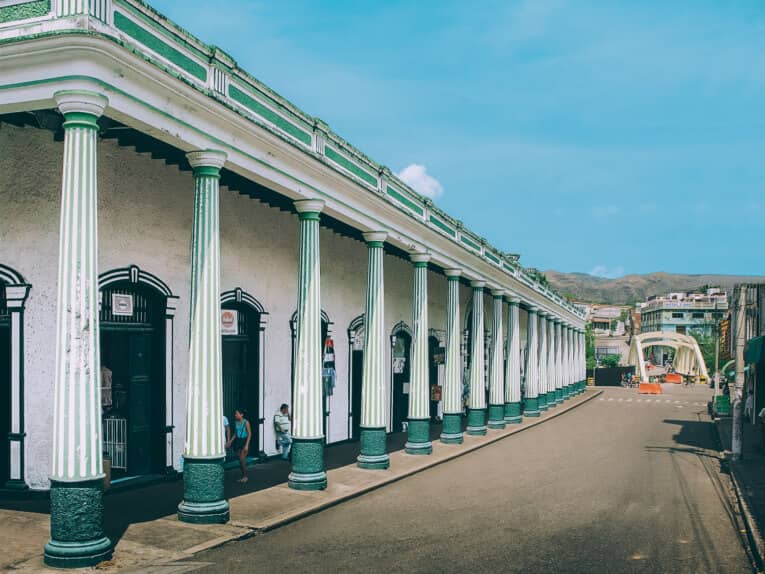
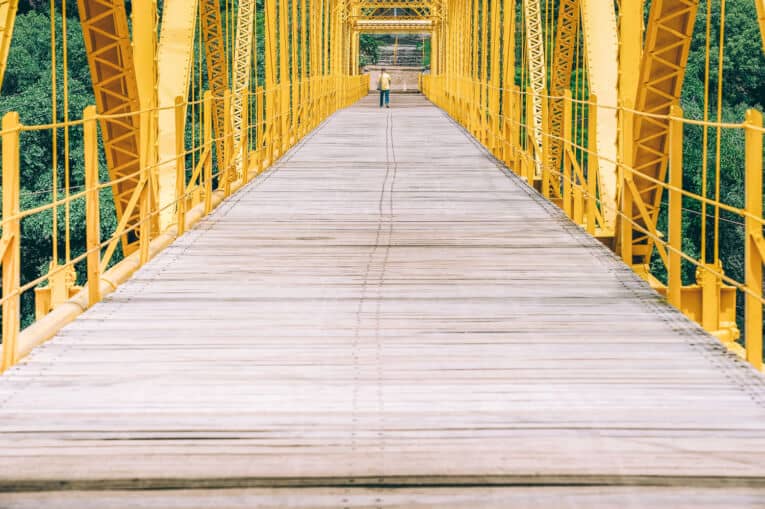
Around Honda
- Vereda Perico rock paintings: rock art left by the natives of northern Tolima in a rock shelter dating back some 600 or 700 years.
Honda
General information
- Founded: 1539
- Population: 34.781
- Altitude: 225m
- People: Hondano
- County: Tolima
How to get to Honda
- Nearest airport: Manizales
- By bus from Manizales: about 3 hours and $20.000
- By bus from Bogota: about 4h30 and $40.000
Our recommendations for accommodation in Honda
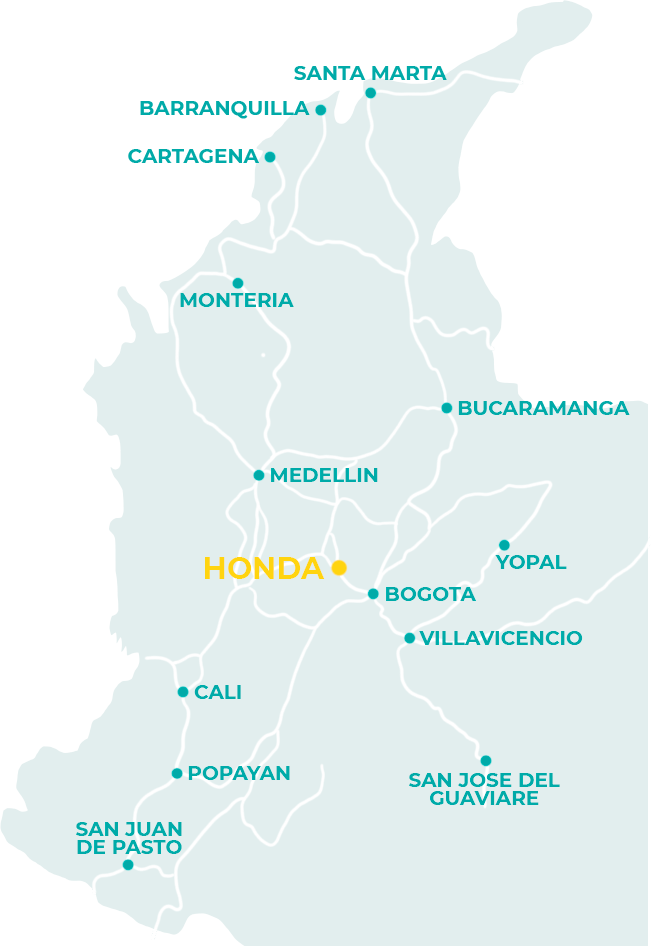
Buga, Valle del Cauca
Colombia’s heritage towns
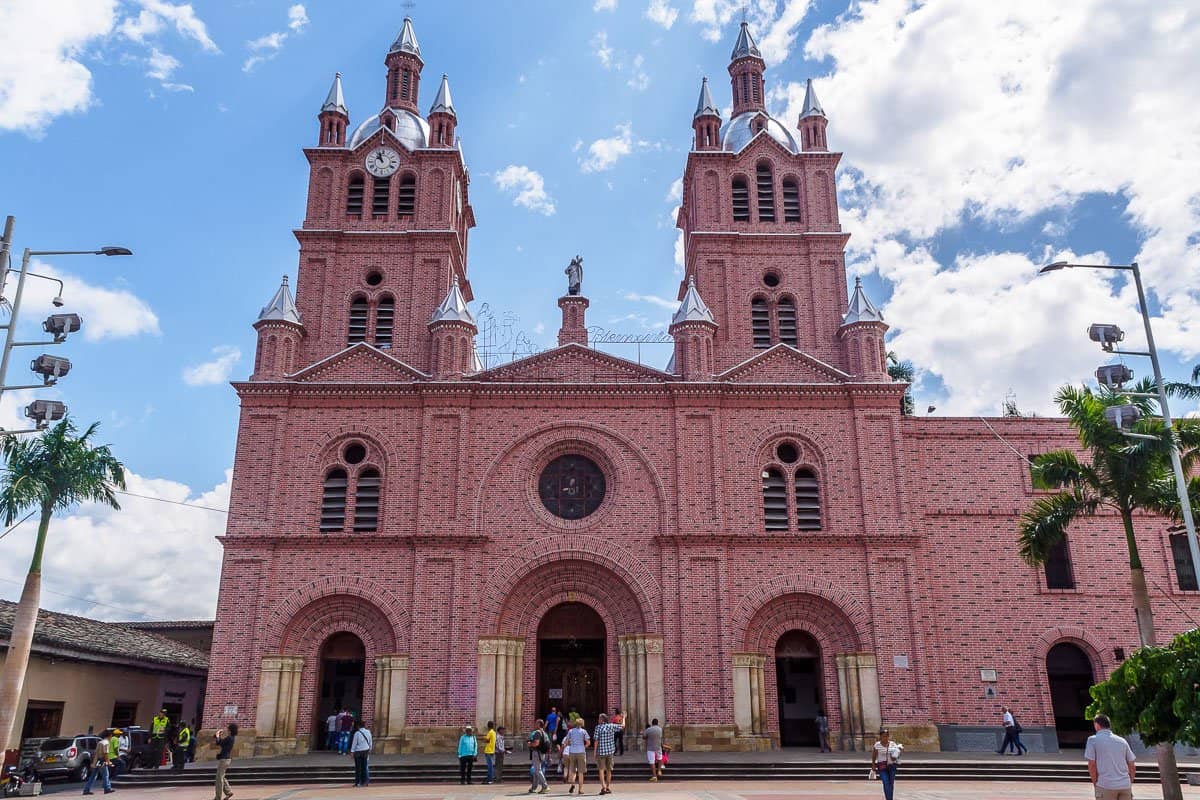
Located a few kilometers north of Cali, Buga is one of the few heritage towns in southern Colombia. A counter-example to the difference in development between northern and southern Colombia in the history of Colombia.
An international pilgrimage site, Buga is a bit like the Lourdes of Colombia. It awaits its visitors all year round with its religious fervour, transcended by the image of the “Holy Redeemer”, over 2 metres high, to which miracles have been attributed.
As you can see, the “Ciudad señora” is a city with a special place in Colombia. Of course, the immense Buga Basilica is THE must-see monument, visited by over a million pilgrims every year!
But it’s not Buga’s only attraction. The town boasts well-preserved colonial architecture, with many 17th and 18th century buildings still retaining their original appearance.
Buga points of interest
- Basílica Menor del Señor de los Milagros: place of pilgrimage where the image of the “Milagroso” is preserved.
- Parc José María Cabal : Buga’s former main square.
- Luciano Rivera y Garrido” House of Culture: museum and music and dance school.
- Ernesto Salcedo Ospina” municipal theater : neoclassical Republican architecture
- Palace of Justice: former town hall and prison
- Cathedral of Saint-Pierre Apôtre
- Temple of Santo Domingo and Saint Francis
Around Buga
- Balnearios : along the Guadalajara River, there are numerous natural swimming pools.
- Laguna de Sonso Nature Reserve: the largest wetland in the Valle del Cauca, home to some 150 species of birds.
- El Vínculo Regional Nature Park: this nature reserve is home to one of the last remaining tropical dry forests in the Valle del Cauca.
- Lake Calima: located on the outskirts of the village of Calima del Darien, this immense body of water offers a wide range of activities.
Buga
General information
- Founded: 1573
- Population: 114.807
- Altitude: 969m
- People: Bugeño
- Department : Valle del Cauca
How to get to Buga
- Nearest airport: Cali
- By bus from Cali: about 1h30 and $10.000
Our recommendations for accommodation in Buga
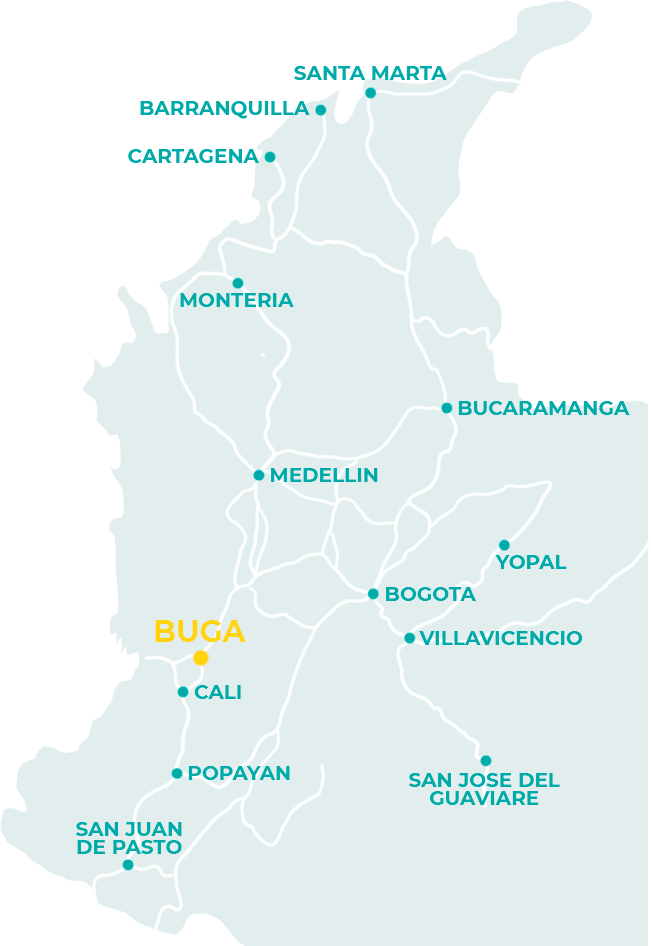
Pore, Casanare
Colombia’s heritage villages
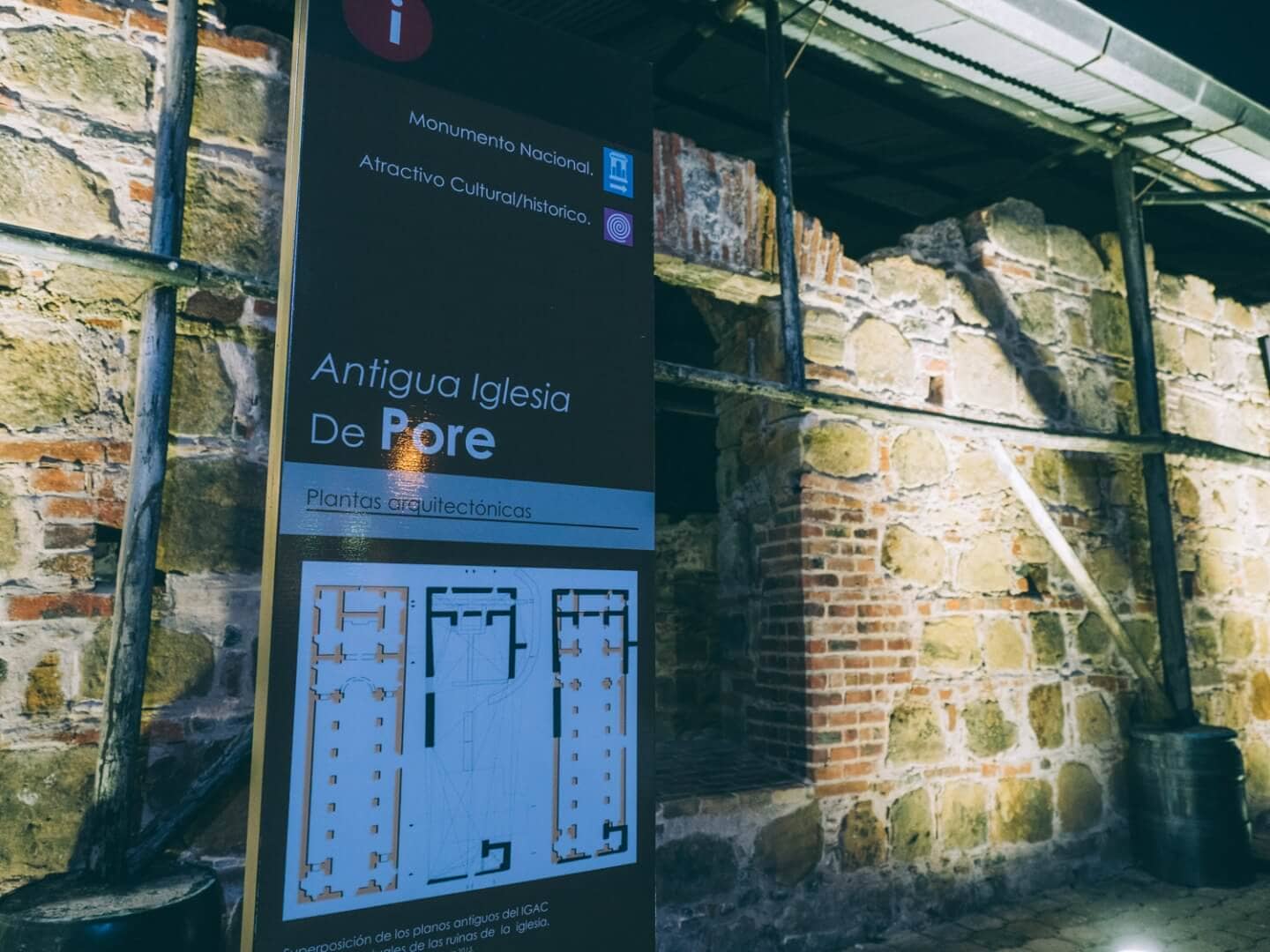
Located in the north of Casanare department, San José de Pore was founded in 1644. It is a landmark in Colombian history for its role in the War of Independence.
History and culture are the pillars on which this pre-Hispanic town, which belonged to the indigenous Achagua people and whose name translates as “Fortress”, is rooted.
Admittedly, Pore itself is not of immense interest, as it is its historical remains that have given it its lustre.
The architectural ensemble that has earned it access to the network of Colombia’s Heritage Villages consists of the colonial remains of the former church of Pore, the first Jesuit episcopate, the prison and the tunnel that connects the two buildings.
This can be a quick stop on a trip to Casanare
Points of interest in Pore
- La calle real: this is Pore’s most emblematic street, a cobbled street with traditional houses, restaurants and local craft stores.
- Casa de los caballos : where Simón Bolívar and his troops stayed in 1819.
- Museo Walter Silva: one of Colombia’s greatest exponents of llanera music
Around Pore
Pore
General information
- Founded: 1644
- Population: 10.000
- Altitude: 250m
- People: Poreño
- County: Casanare
How to get to Pore
- Nearest airport: Yopal
- By bus from Yopal: about 1h30 and $15.000
Our recommendations for accommodation at Yopal
